Press the right key for the next slide (or swipe left)
also ...
Press the left key to go backwards (or swipe right)
Press n to toggle whether notes are shown (no equivalent if you don't have a keyboard)
Press m or double tap to see a menu of slides
\title {Logic I \\ Lecture 04}
\maketitle

\def \ititle {Logic I}
\def \isubtitle {Lecture 04}
\begin{center}
{\Large
\textbf{\ititle}: \isubtitle
}
\iemail %
\end{center}
Readings refer to sections of the course textbook, \emph{Language, Proof and Logic}.
\section{∨Intro}
\section{∨Intro}
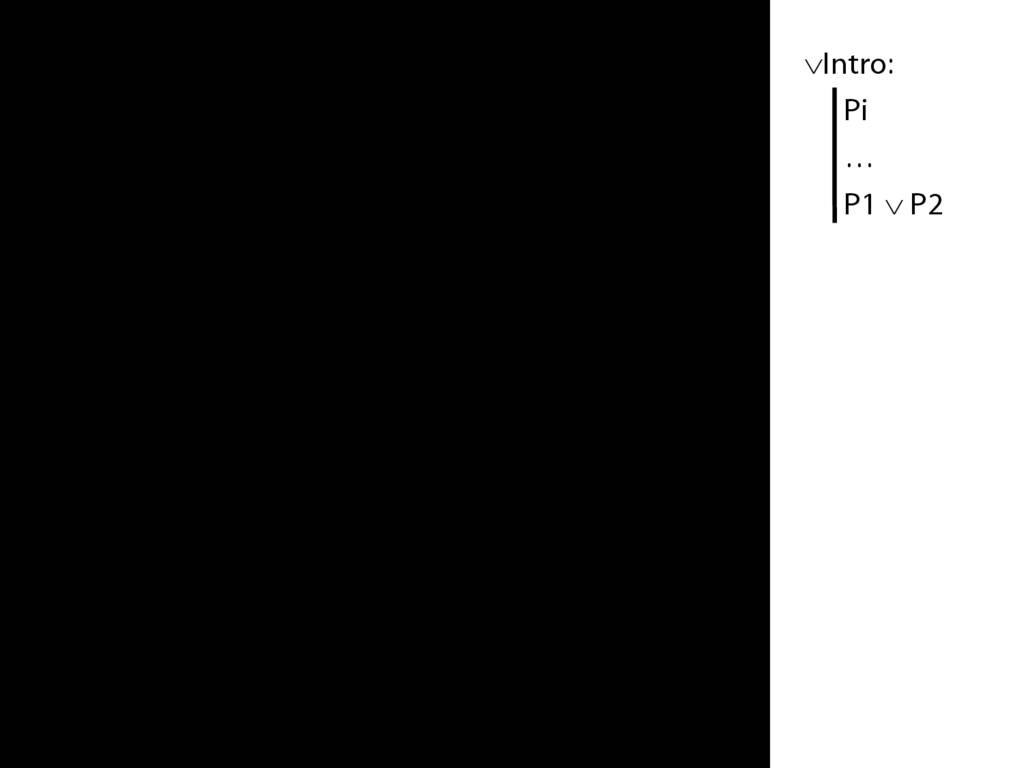
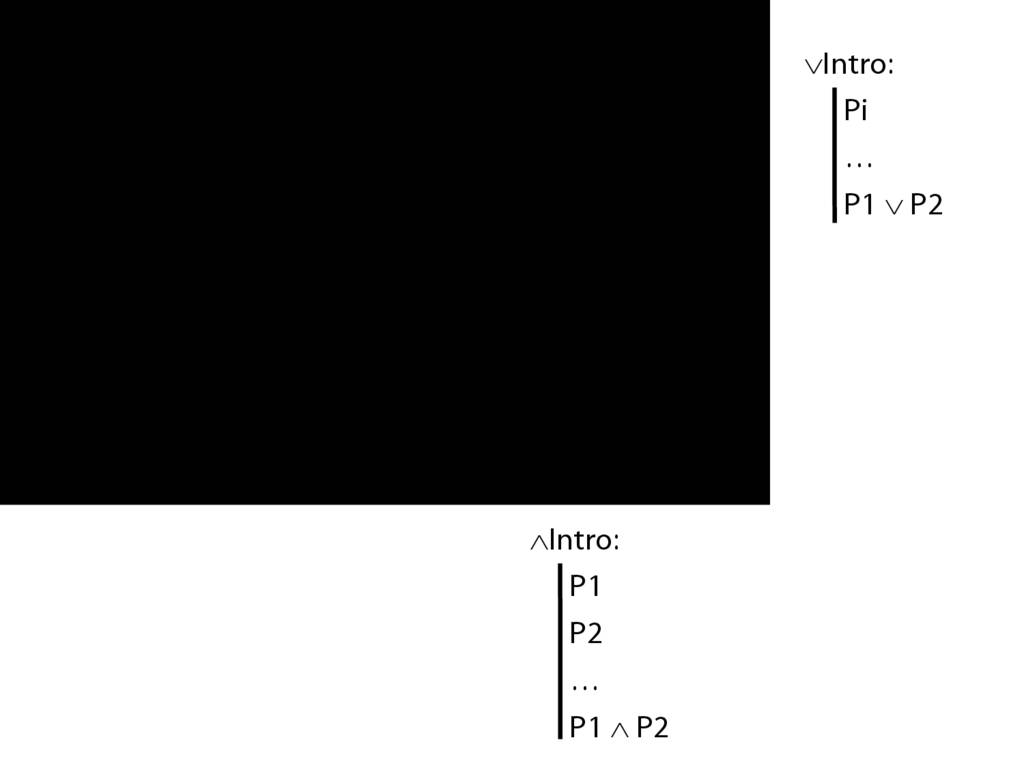

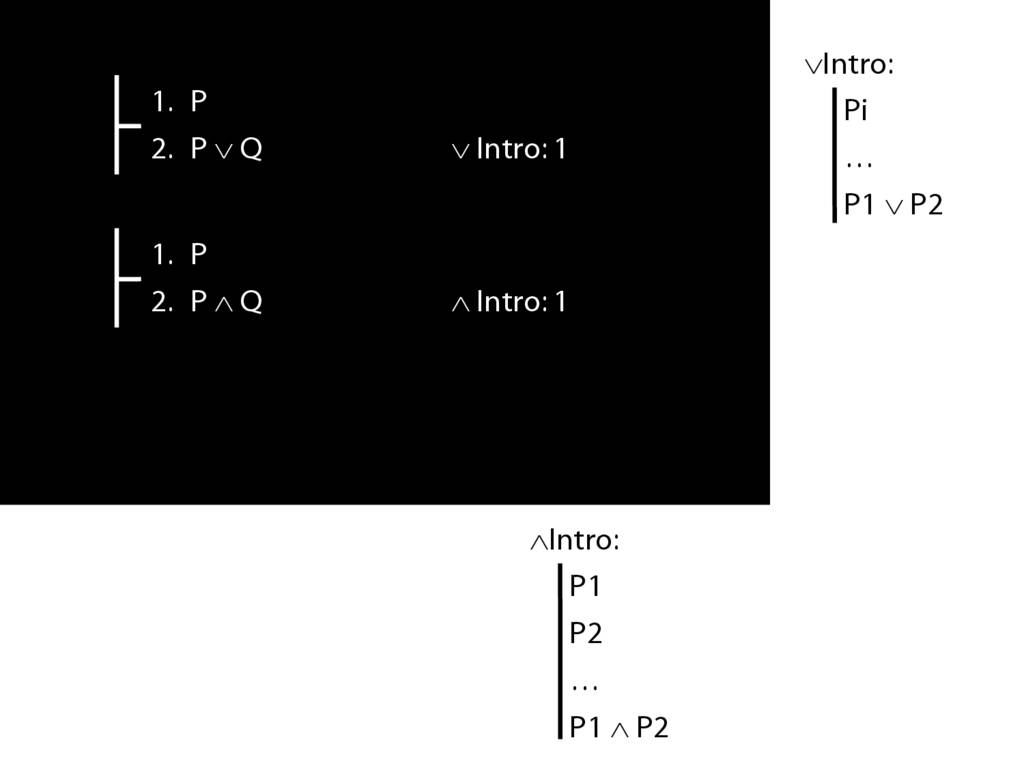
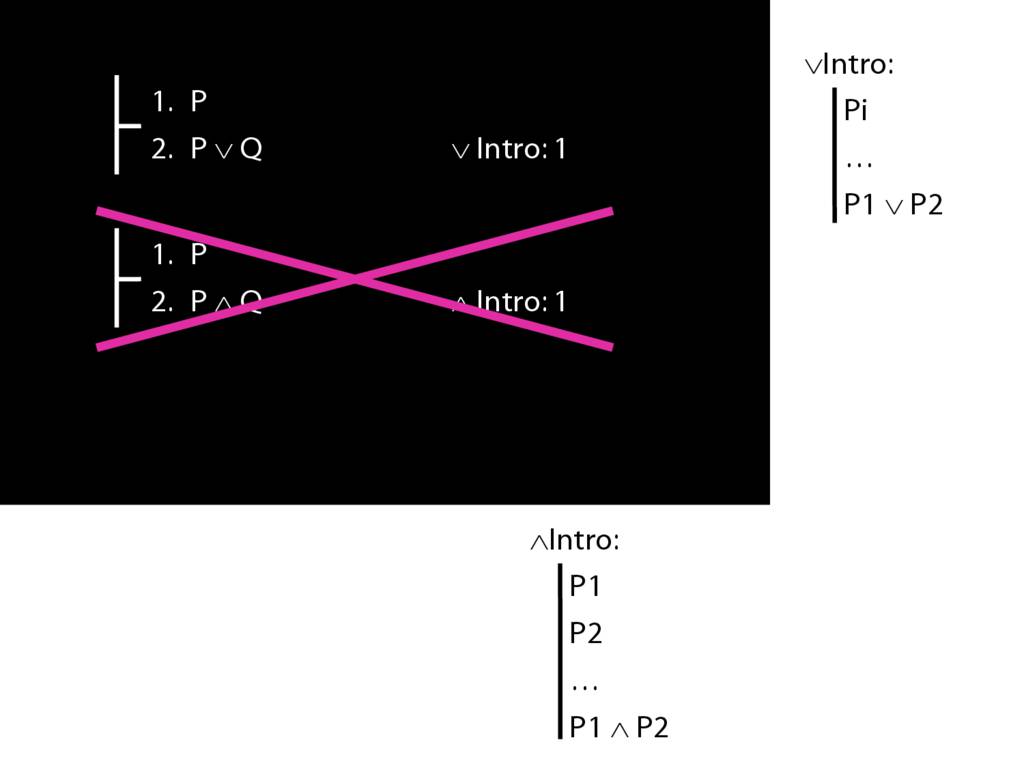
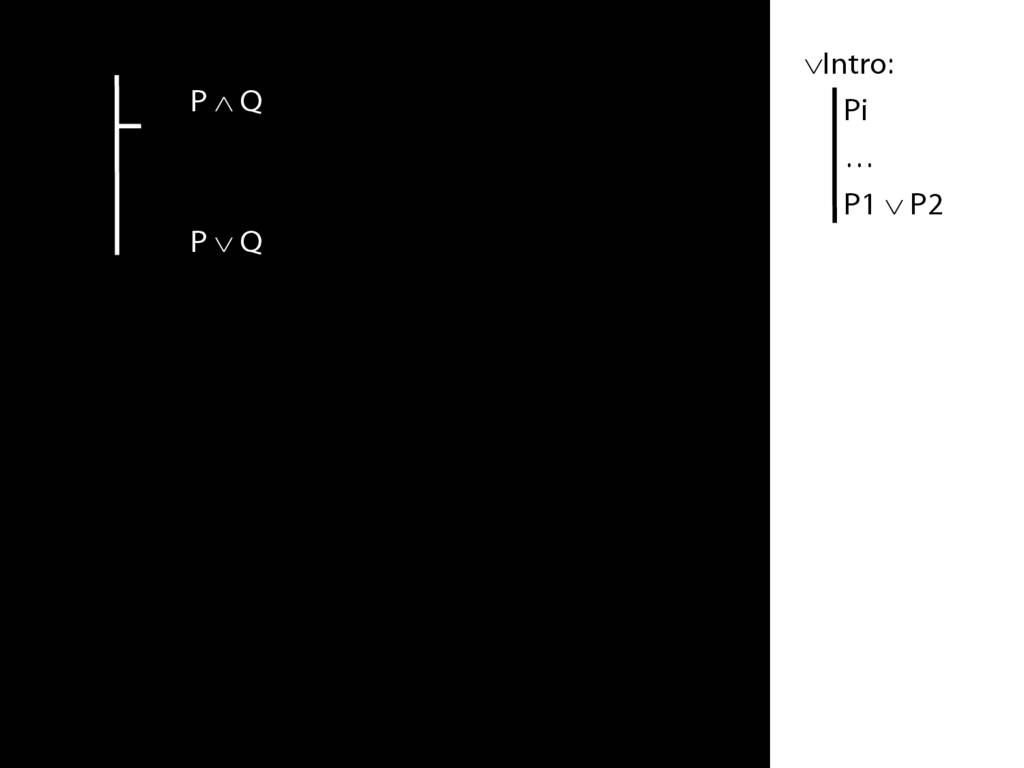
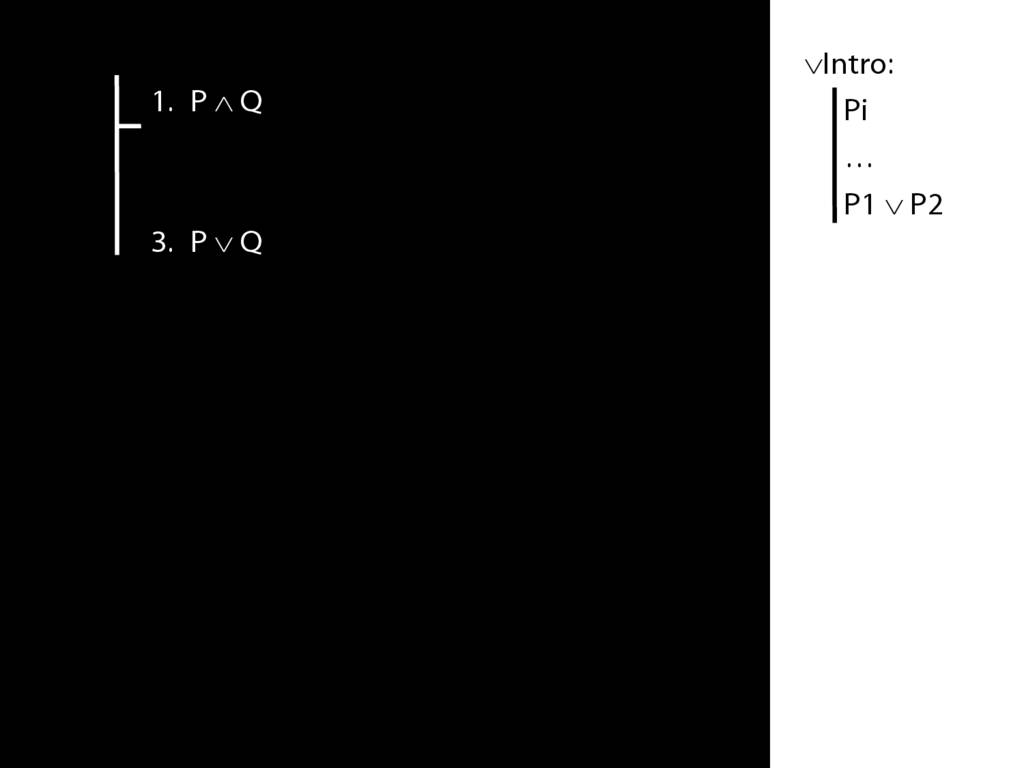
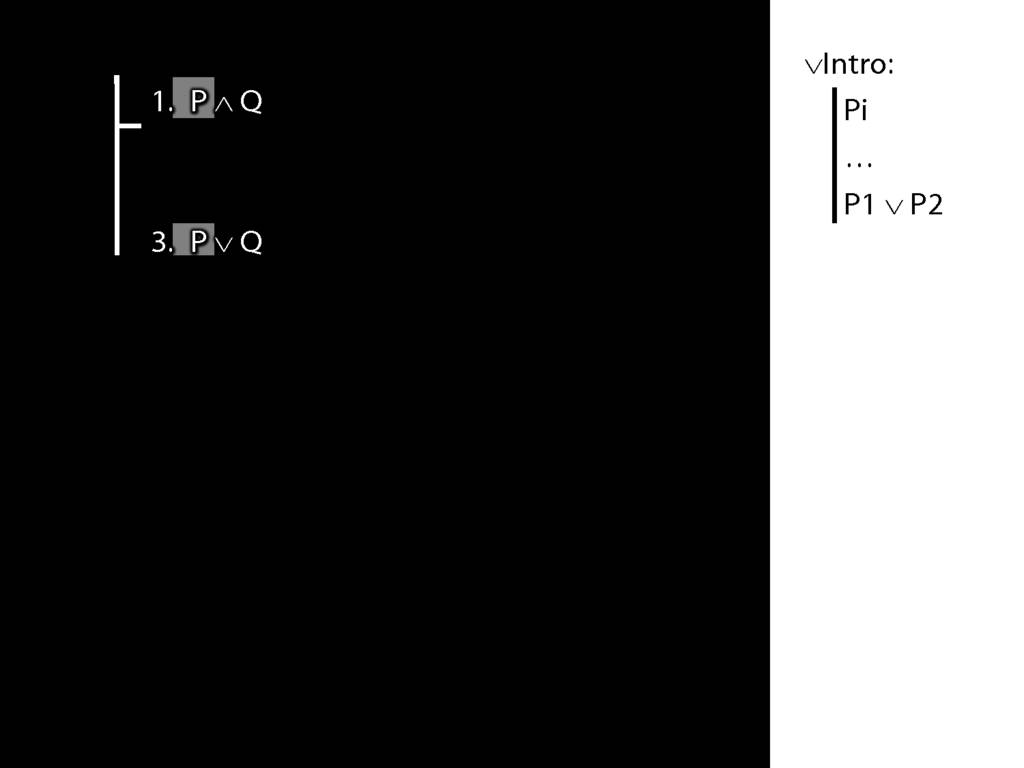
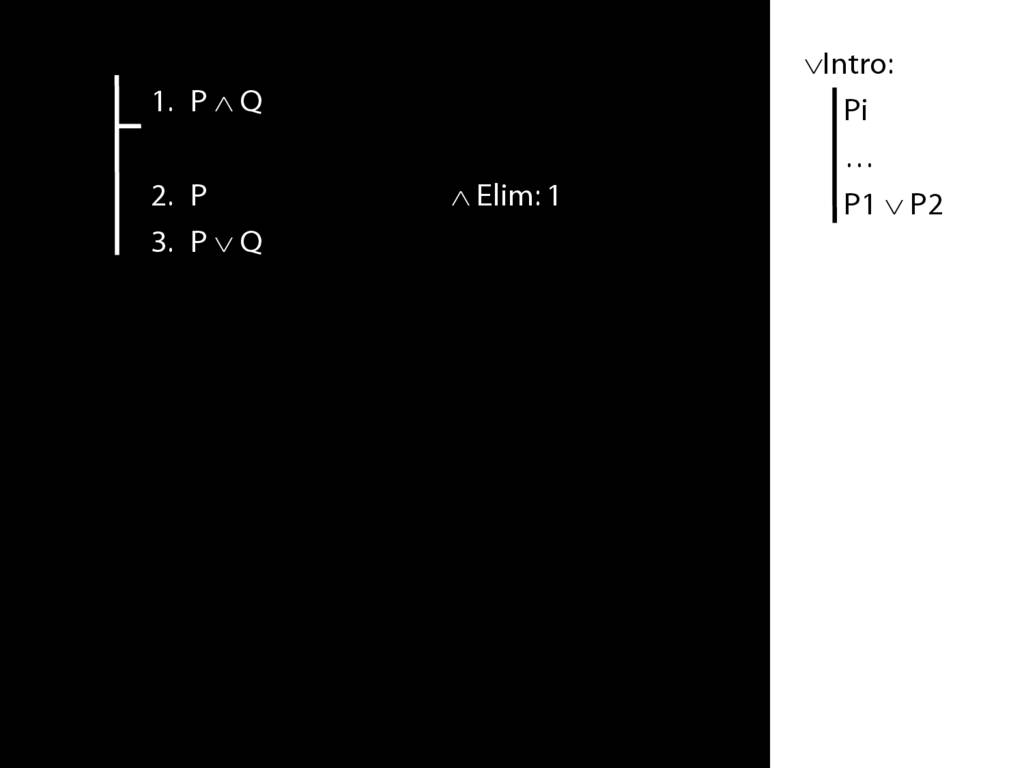
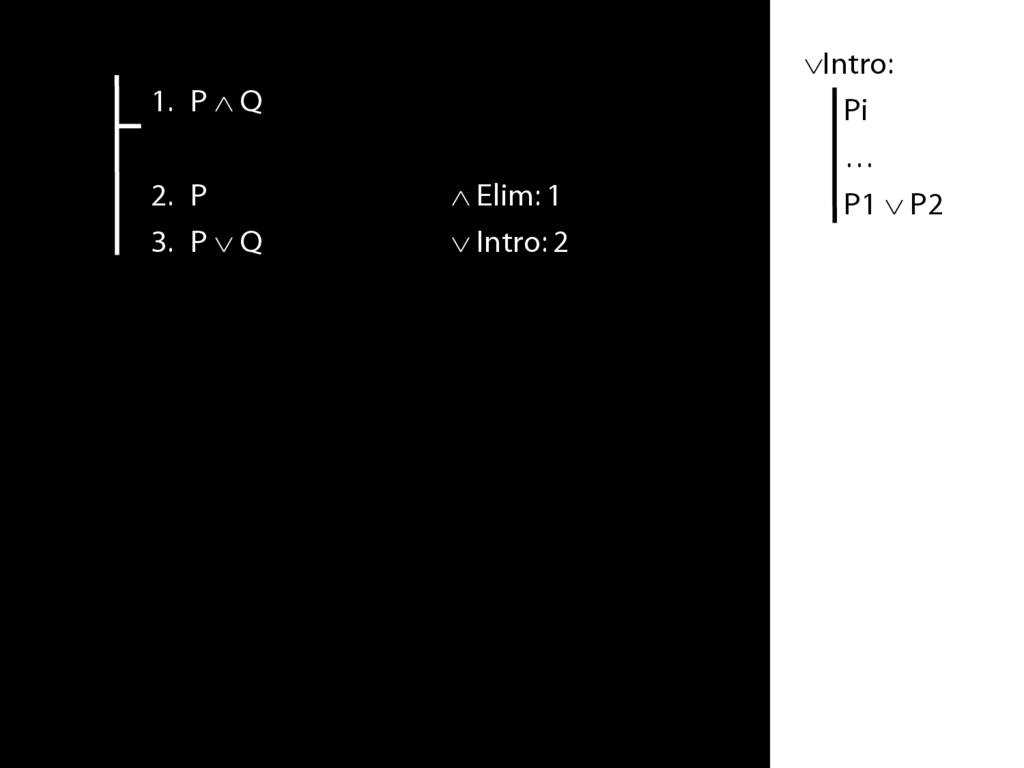
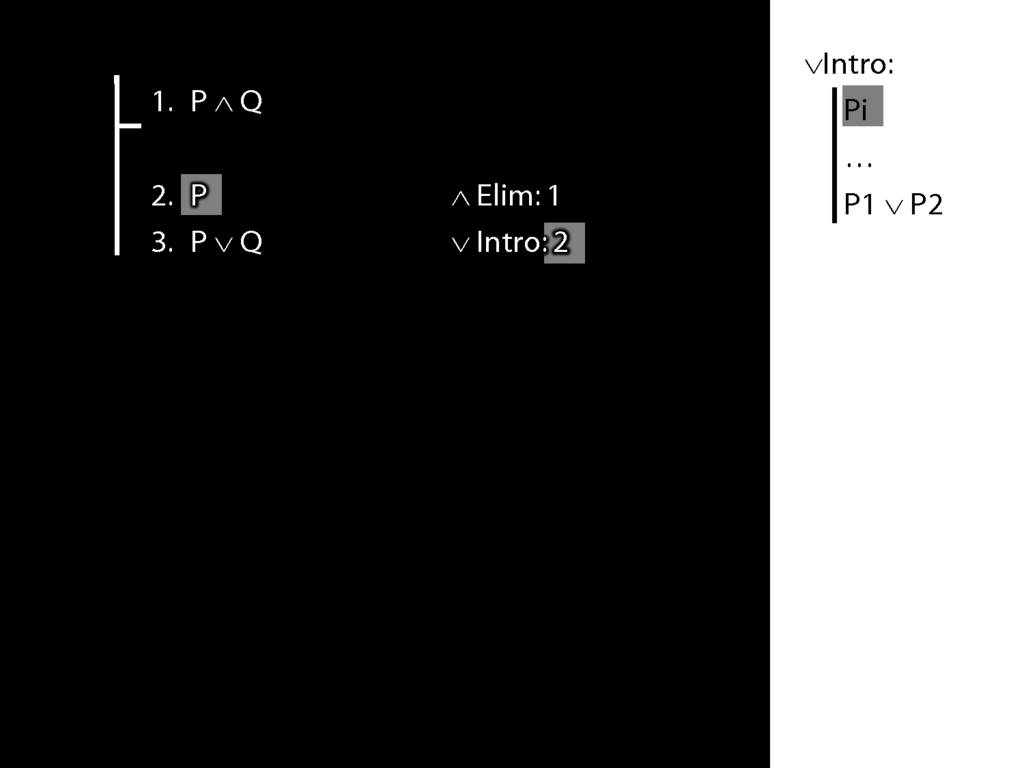
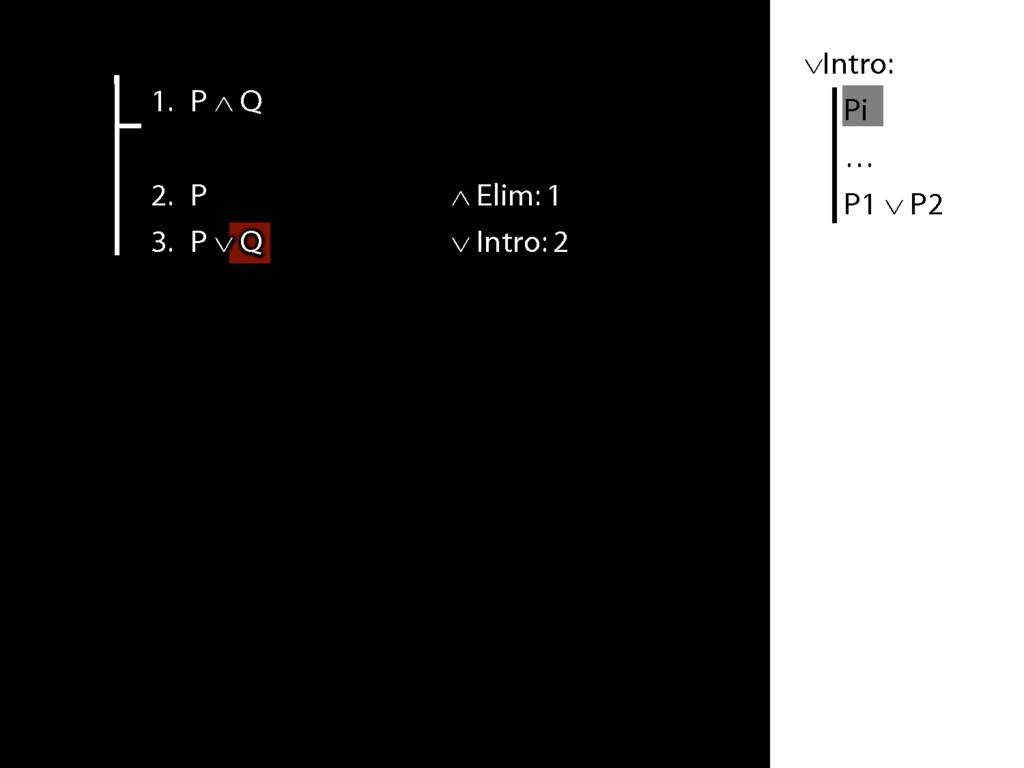

∧Intro and ∨Intro: Compare and Contrast
\section{∧Intro and ∨Intro: Compare and Contrast}
\emph{Reading:} §6.1
\section{∧Intro and ∨Intro: Compare and Contrast}
How come we can prove only valid arguments?
How come we can prove only valid arguments?
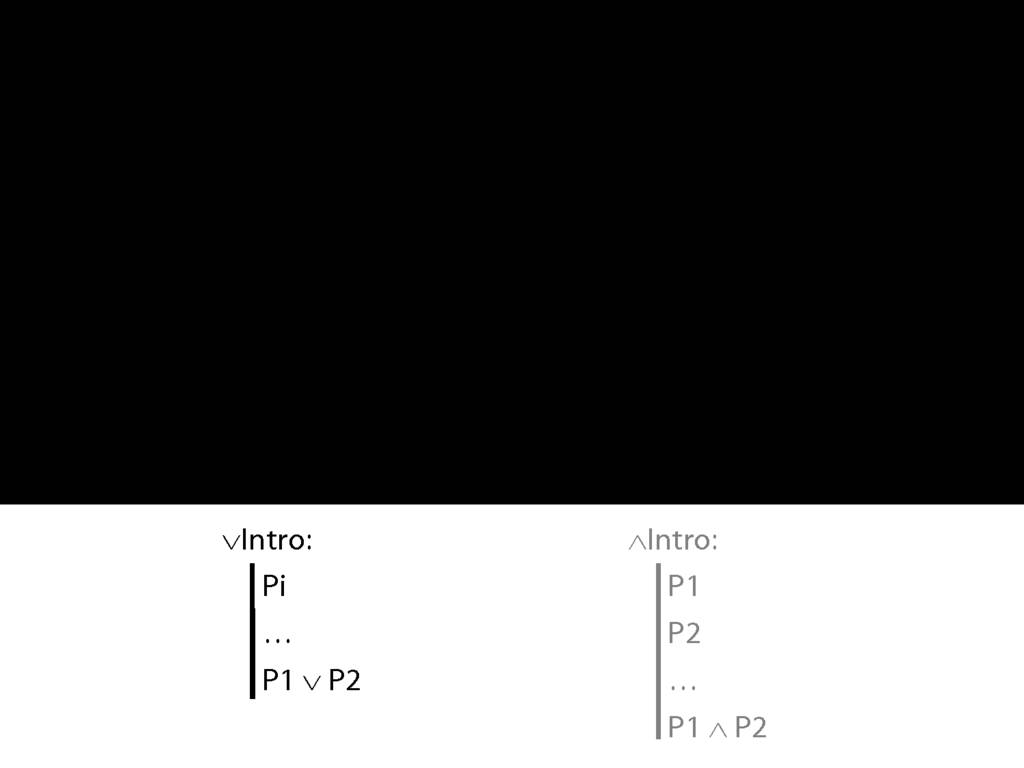
Here is a new rule of proof, called disjunction intro.
∨Intro is saying that if you have any sentence, you can add a line to your proof containing a disjunction of that sentence and any other sentence you like.
Explain ∨Intro with an example: if you know Ayesha is in the garden but don’t want to give this away but do want to speak the truth you can say “Ayesha is in the library or Ayesha is in the garden”.
The transition from 'Ayesha is in the garden' to 'Ayesha is in the garden or Ayesha is in the library' is the transition that disjunction intro allows you to make in formal proofs.
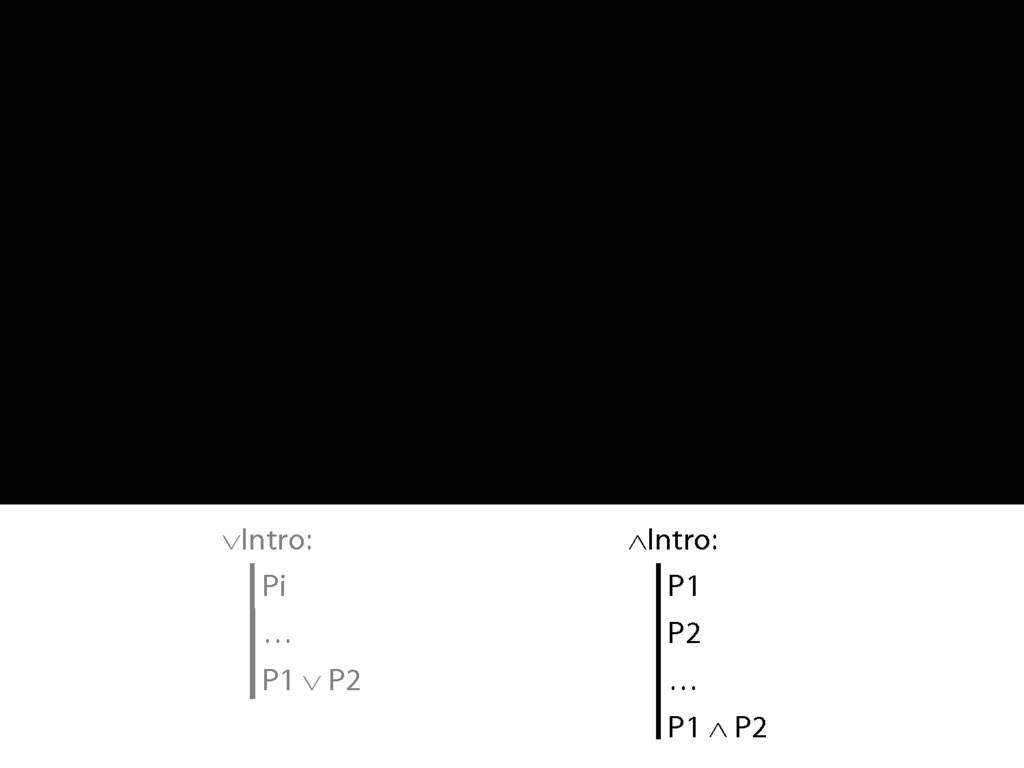
Contrast ∧Intro ...
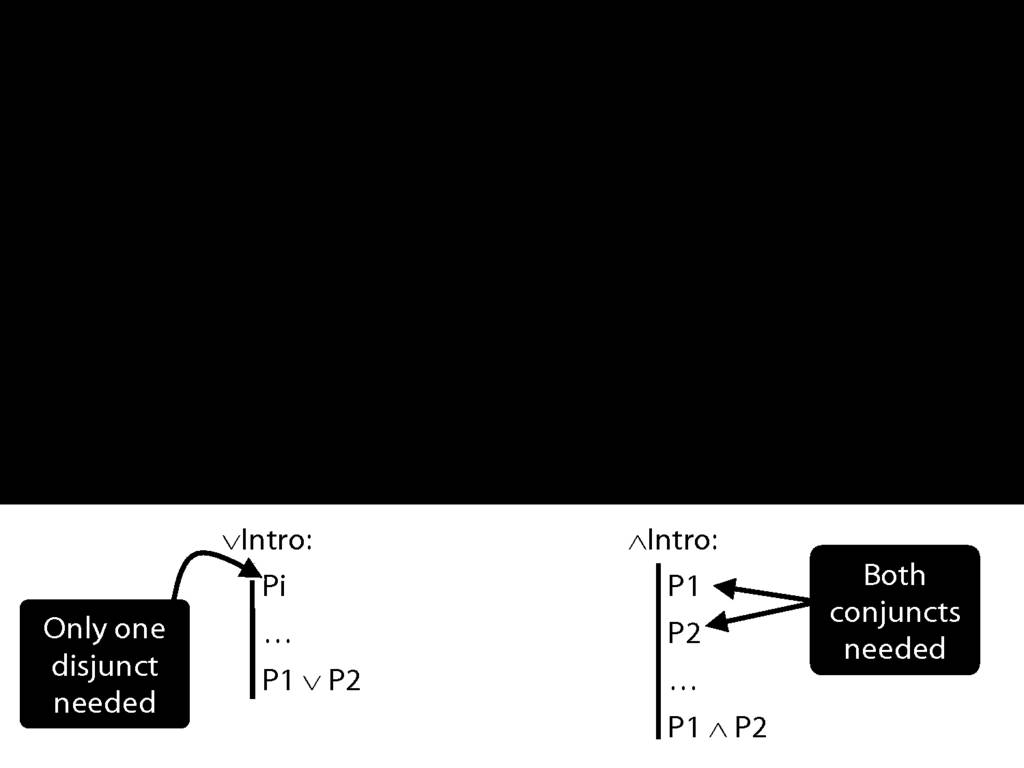
∧Intro is just like ∨Intro except that you need both conjuncts for ∧Intro.
Why should we have set things up like this? Why is using ∧Intro more demanding than using ∨Intro?
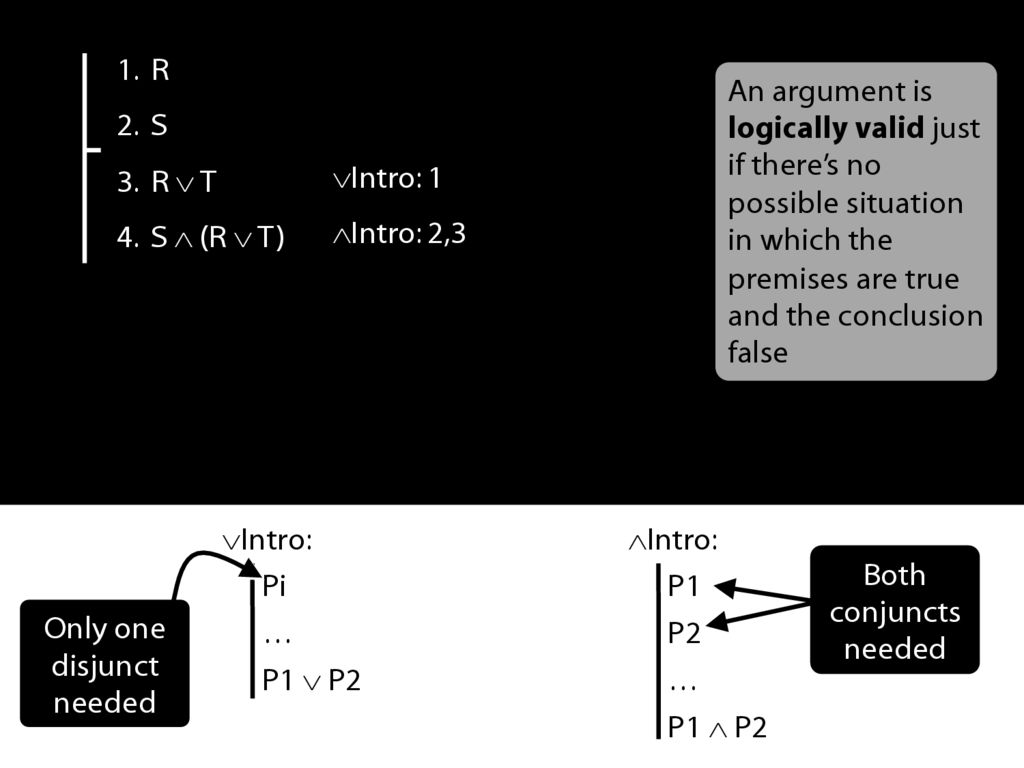
Let's have a look at a proof involving these two rules.

We're using ∨Intro at line 3 to get R∨T.
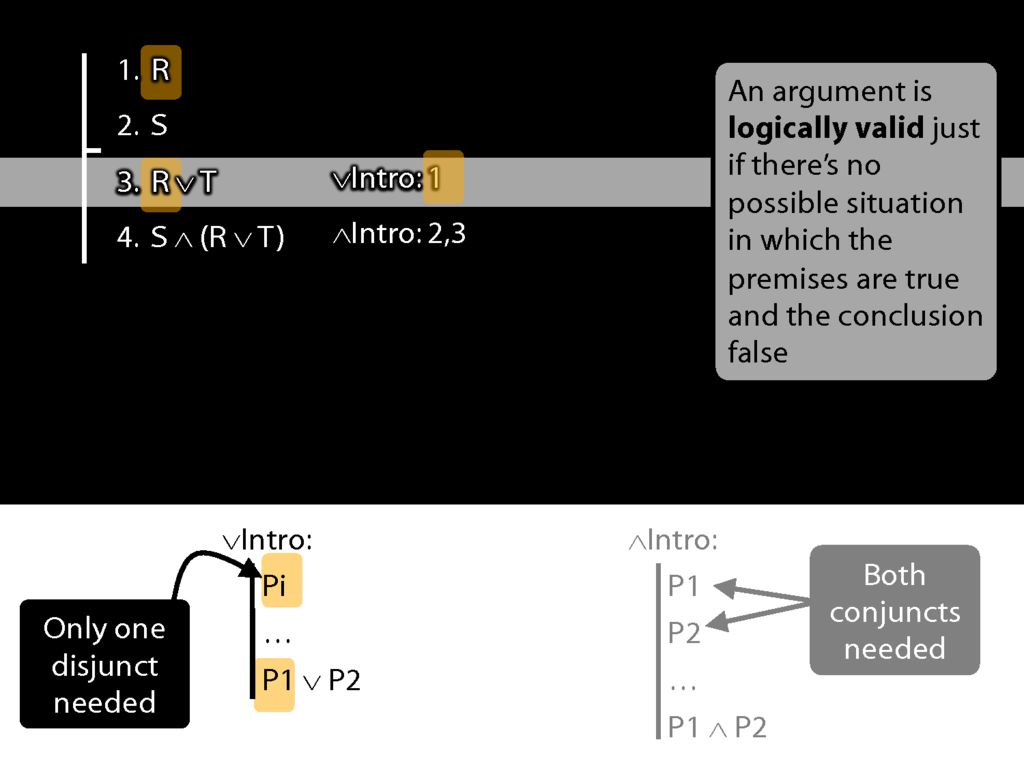
See how what we've done matches the rule. (Sometimes people ask, Where does the T come from? The answer is: it just comes from nowhere.)
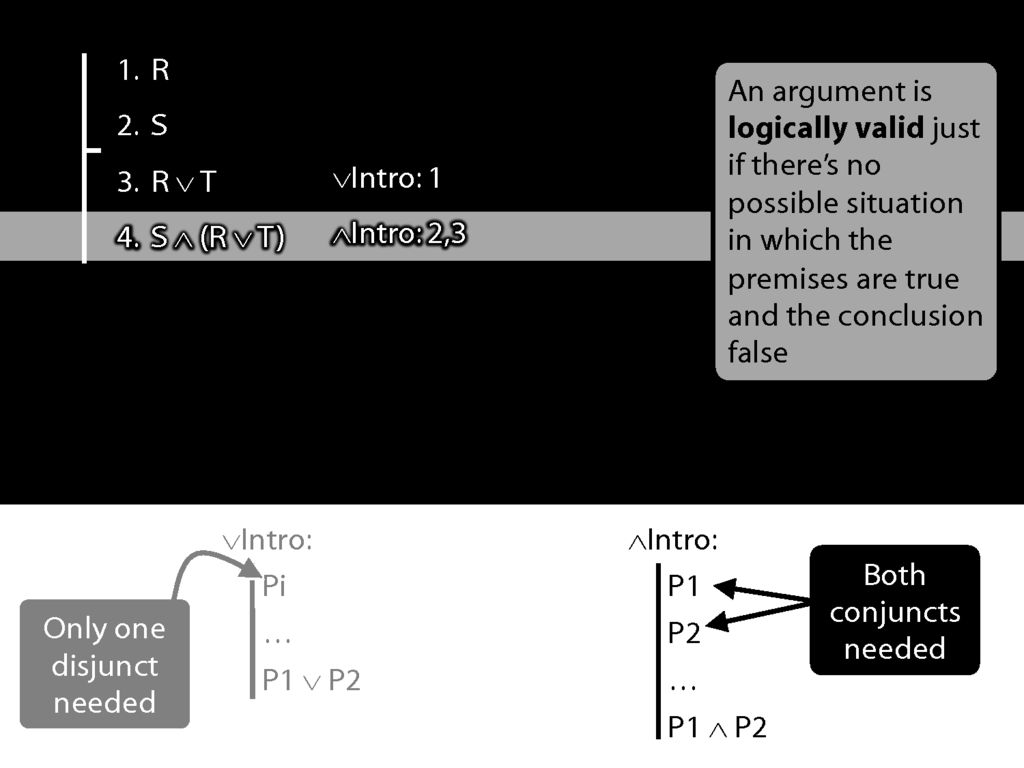
Now we're using ∧Intro.

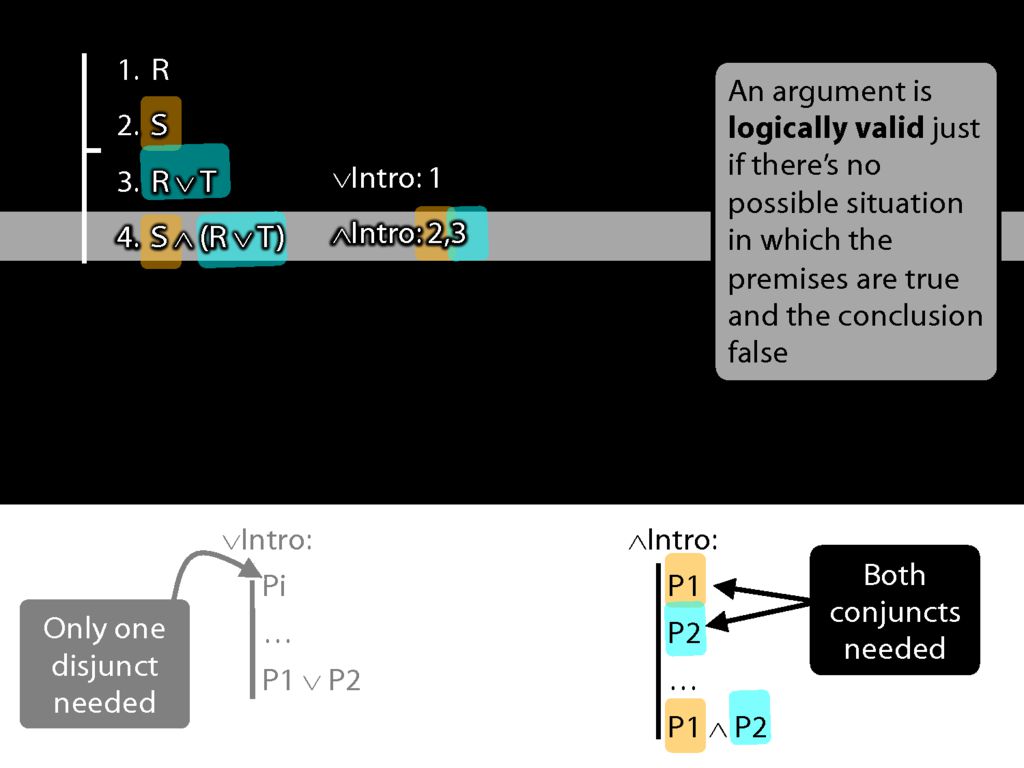
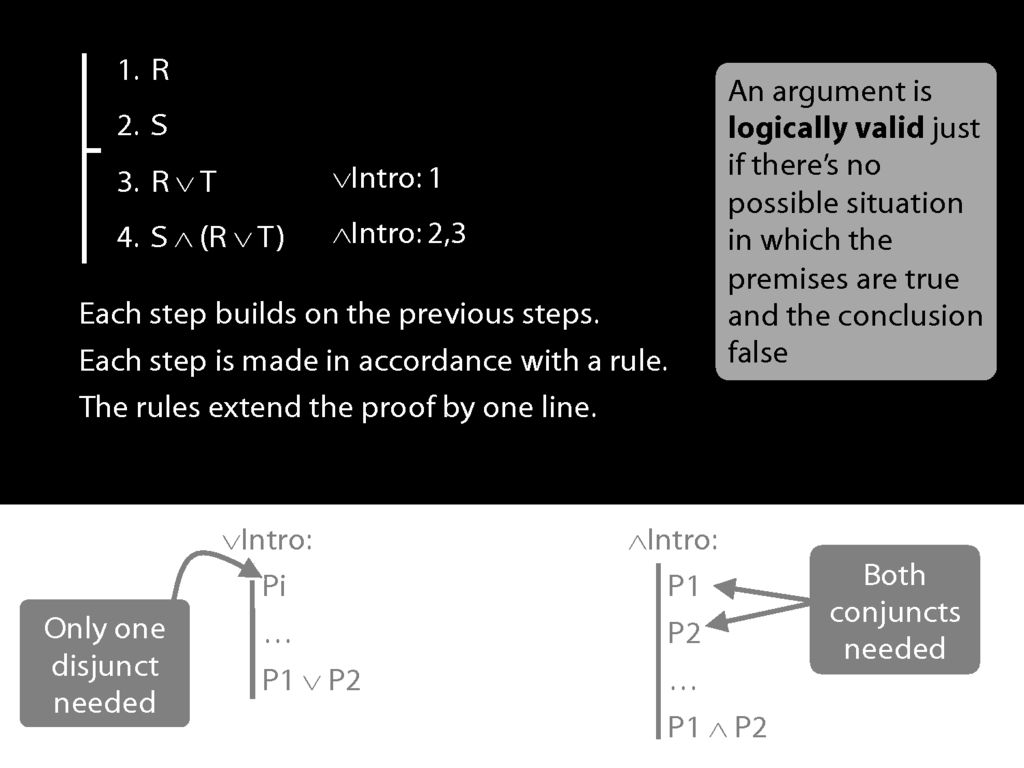
Note some properties of the proof:
Each step builds on the previous steps; each step is made in accordance with a rule; and the rules we've seen so far extend the proof by one line.
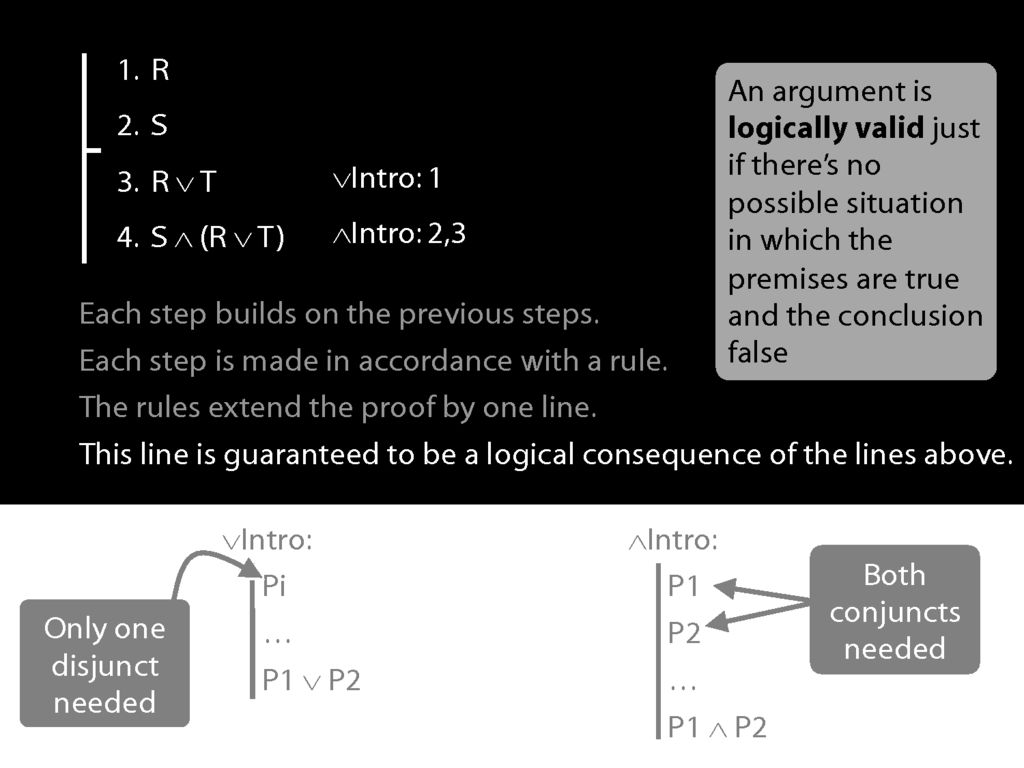
The most important property, though is this: The new line is guaranteed to be a logical consequence of the lines above.
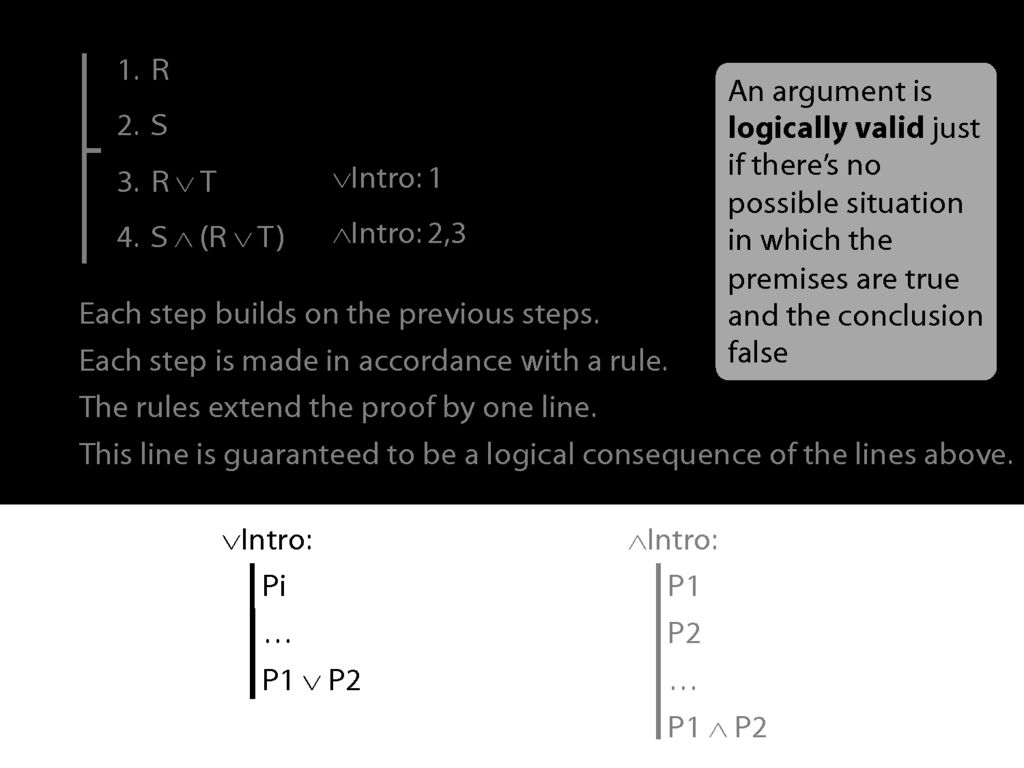
Let me illustrate ...
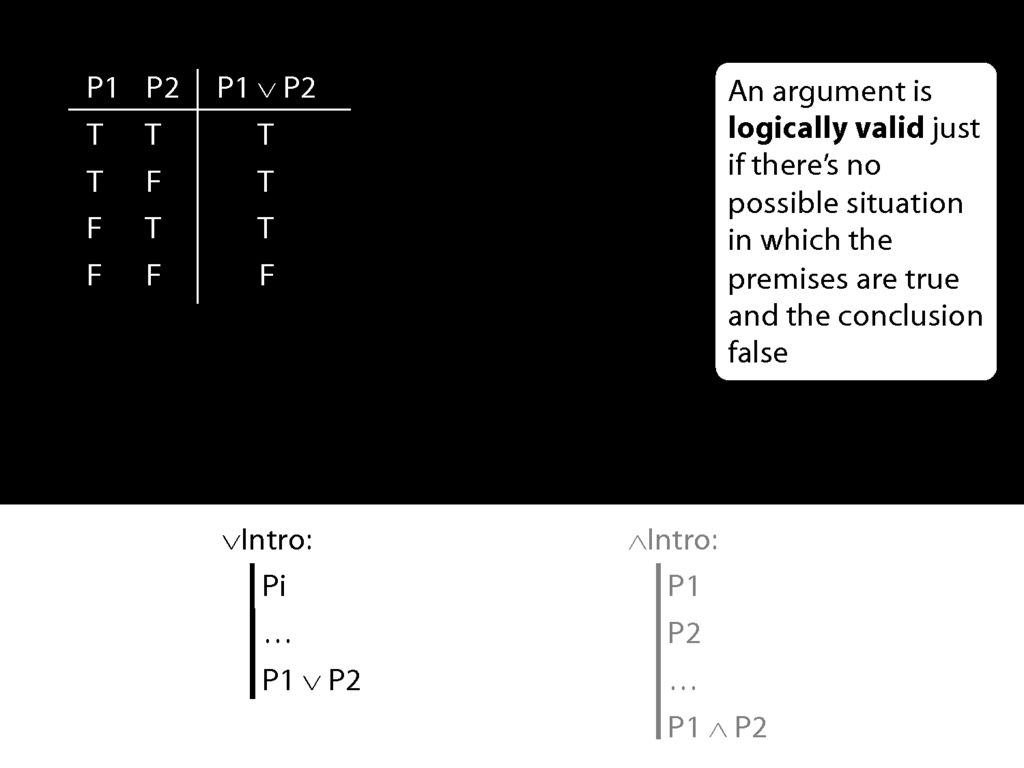
Consider the truth table for disjunction.
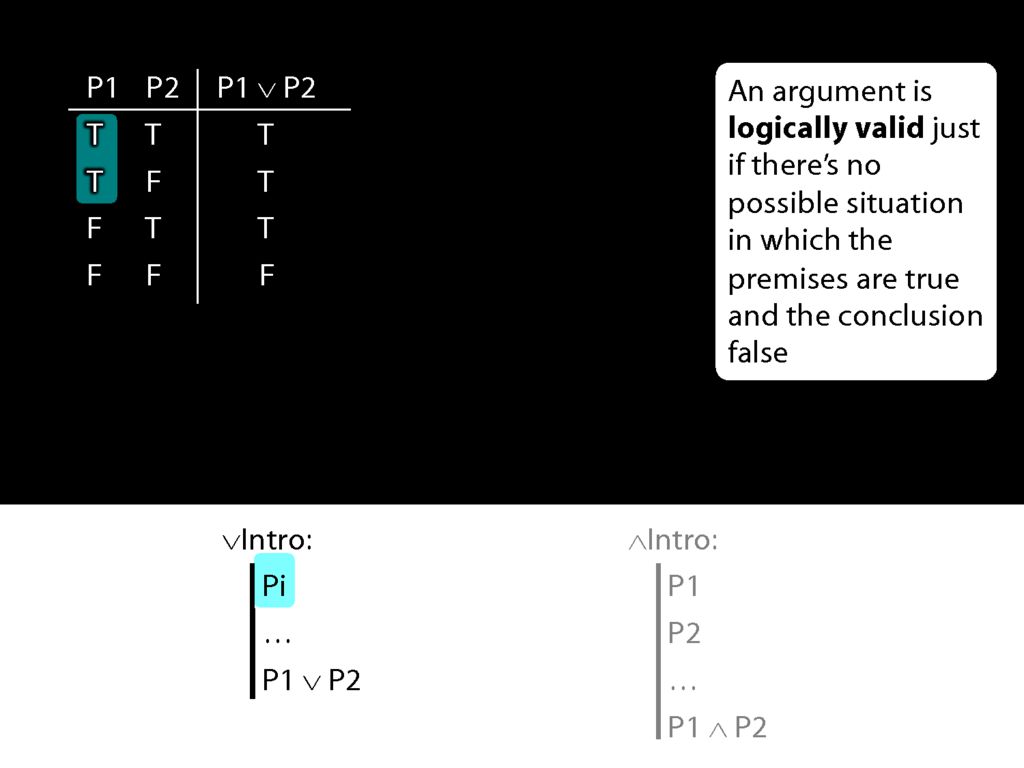
What happens when the prerequiste for the disjunction-intro rule is true? In that case, we're in the first two rows of the truth table.
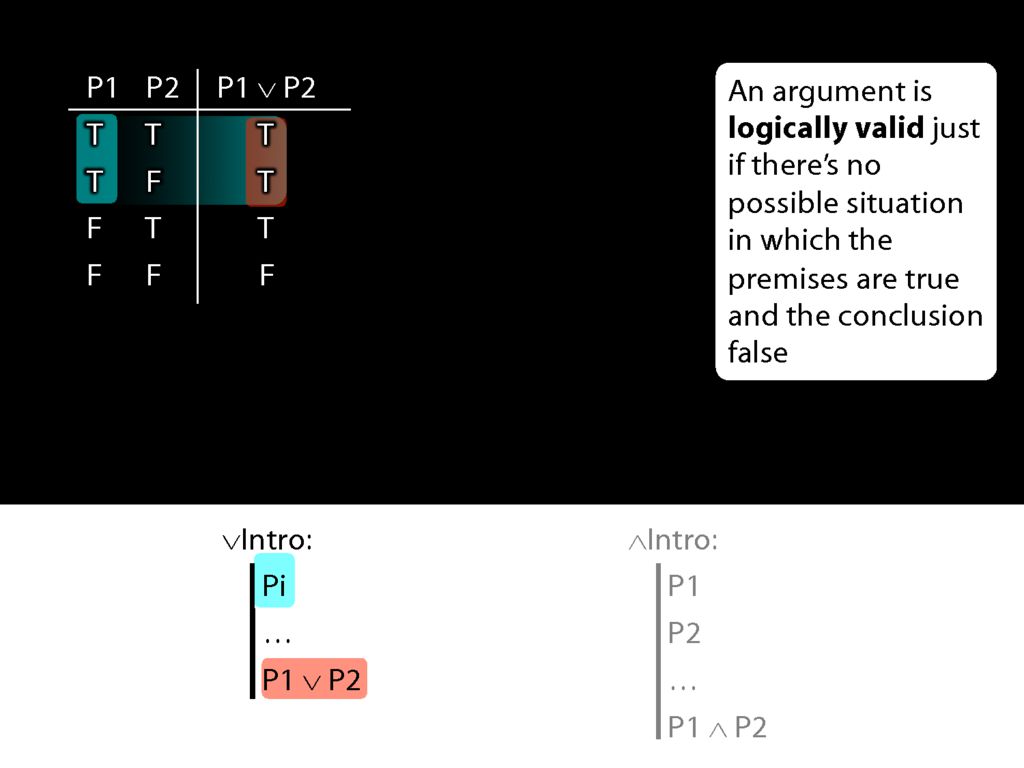
And in those first two rows, the disjunction which the rule adds to the proof is true.
So given the truth table, we can see that disjunction-intro will never take us from a truth to a falsehood; from a truth we can only reach another truth using disjunction-intro.
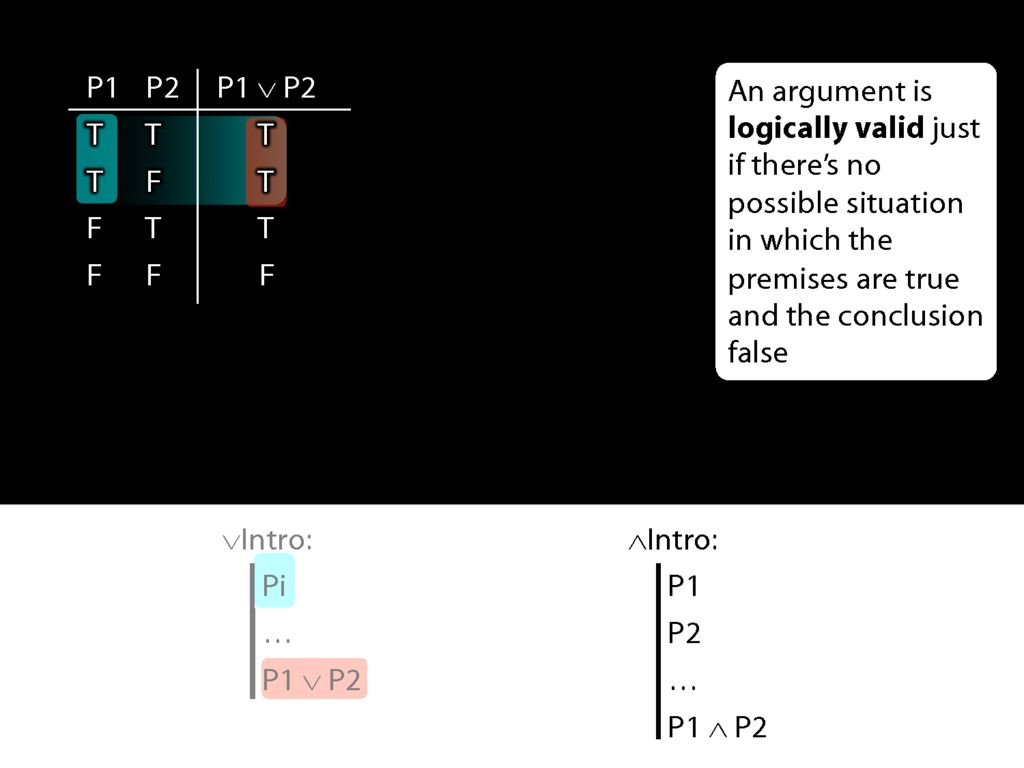
Now look at conjunction intro.
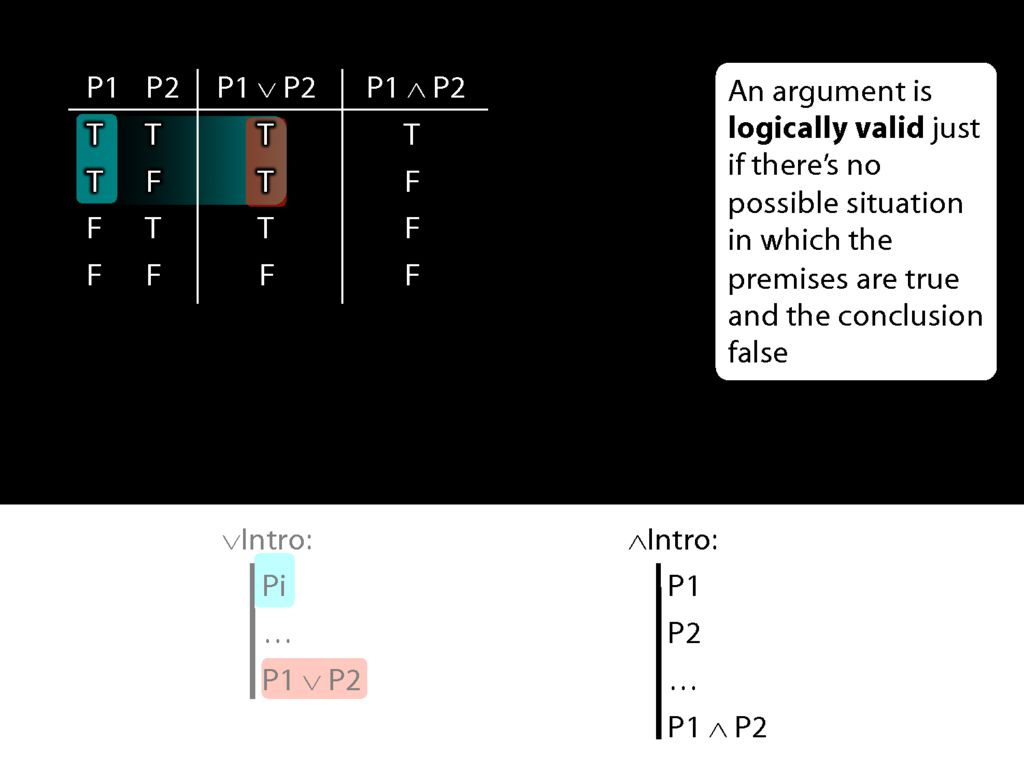
Here's the truth table for conjunction.
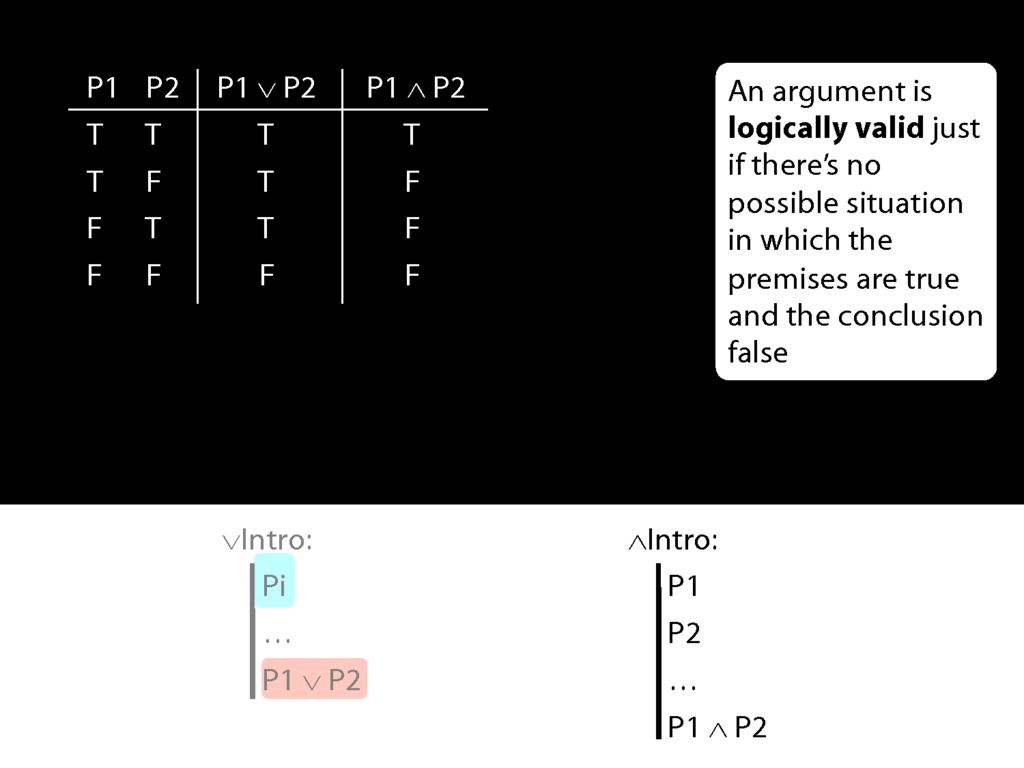

Now what happens when the first prerequisite for conjunction introduction is true?
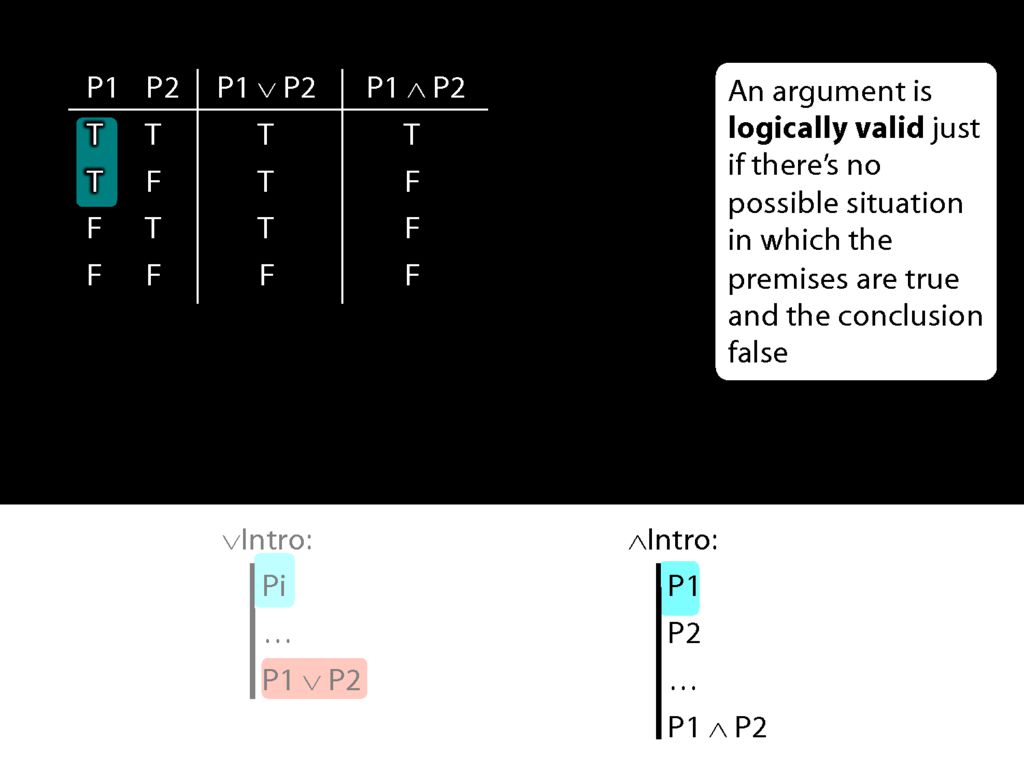
In that case, we're in the first two rows of the truth table.

What is the truth value of the conjunction which conjunction-introduction adds to the proof in these rows of the truth table?

Actually this conjunction is true is one row and false in the other.
So when P1 is true, P1∧P2 is sometimes true and sometimes false.
This means that if conjunction-intro required just one conjunct, it would sometimes take us from a truth to a falsehood.
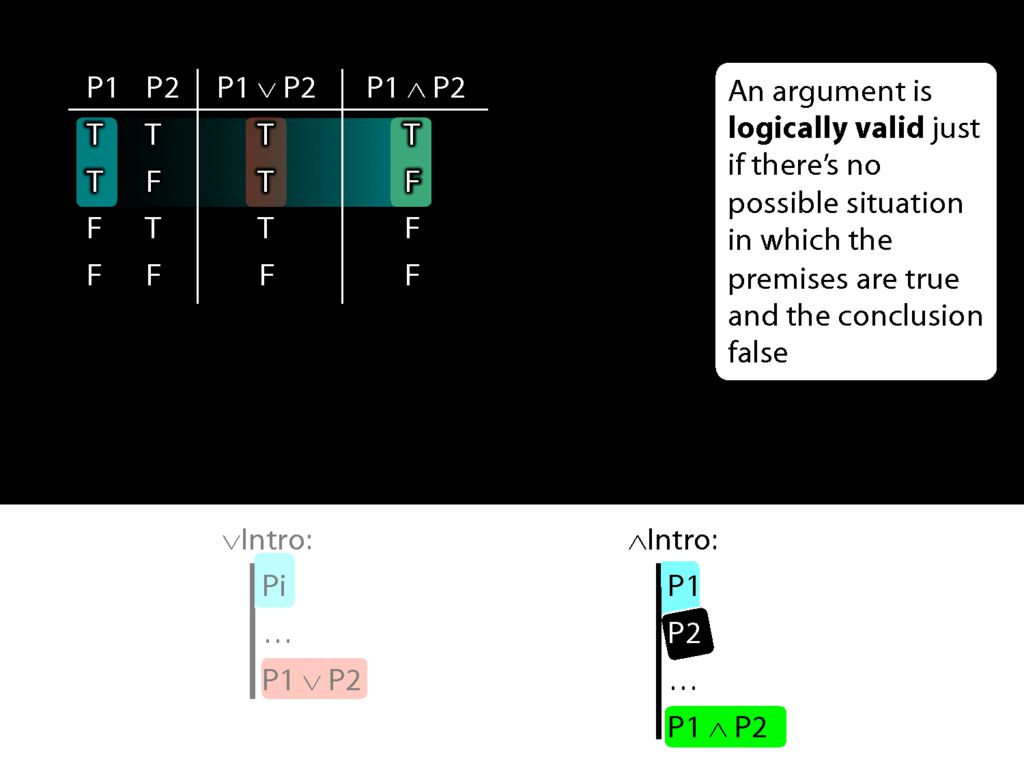
But actually conjunction-intro requires that we already have both conjuncts in our proof.
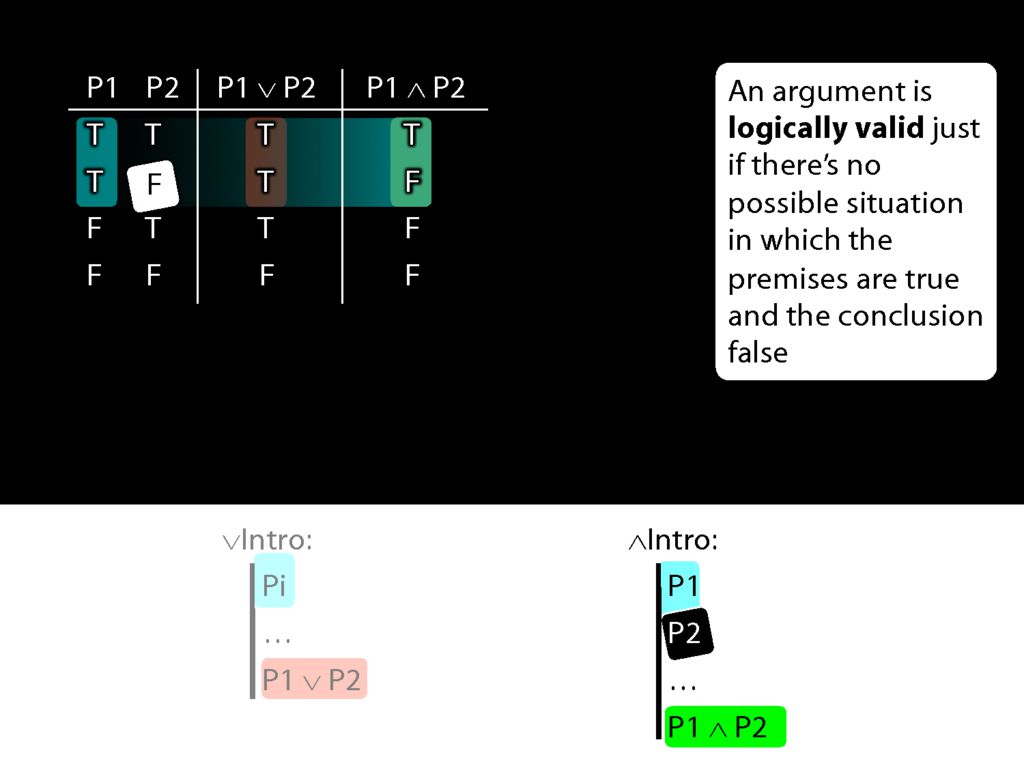
So if both pre-requisites for using conjuncton introduction are true, then we can't be in the second row of the truth table.

And this means that when everything conjunction-intro requires is true, then the conjunction it allows us to introduce must always be true.
Earlier I asked, Why is using ∧Intro more demanding than using ∨Intro? Now we can see exactly what the answer is.
Speaking entirely formally, we can use whatever rules we like.
But we want our rules to mirror logical validity--given truths, we want them to take us only to truths. We want them never to take us from truth to falsehood.
For this reason, given the truth table for conjunction, ∧Intro has to require that we already have both conjuncts.
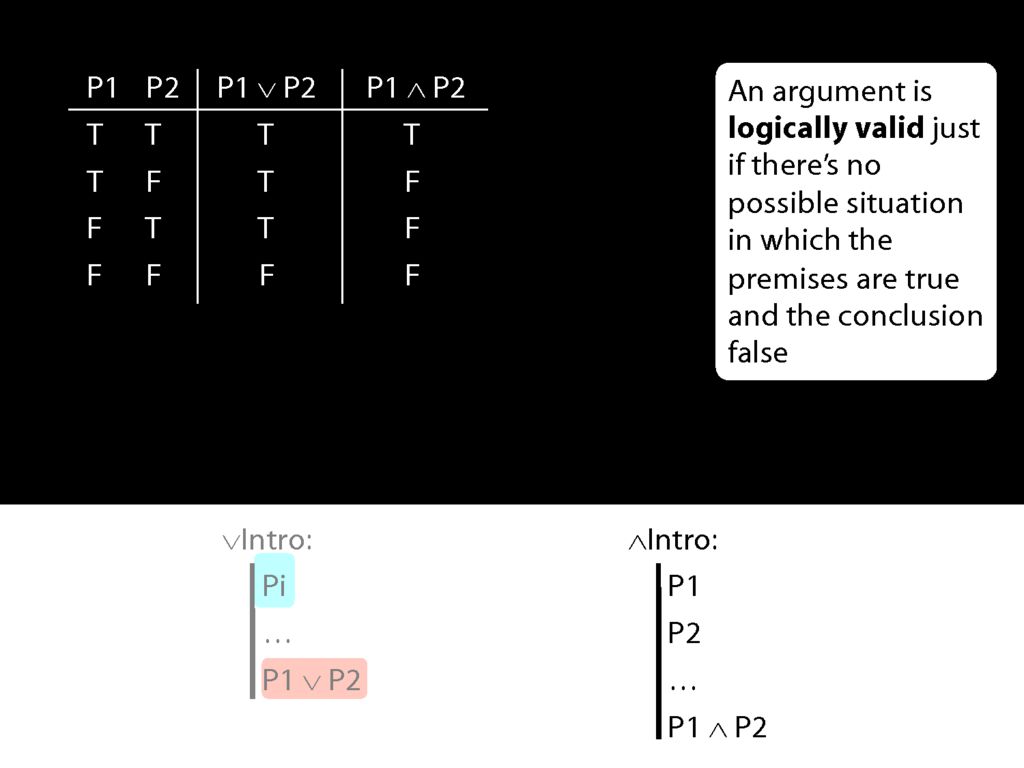
Let me make the same point by introducing a new connective.
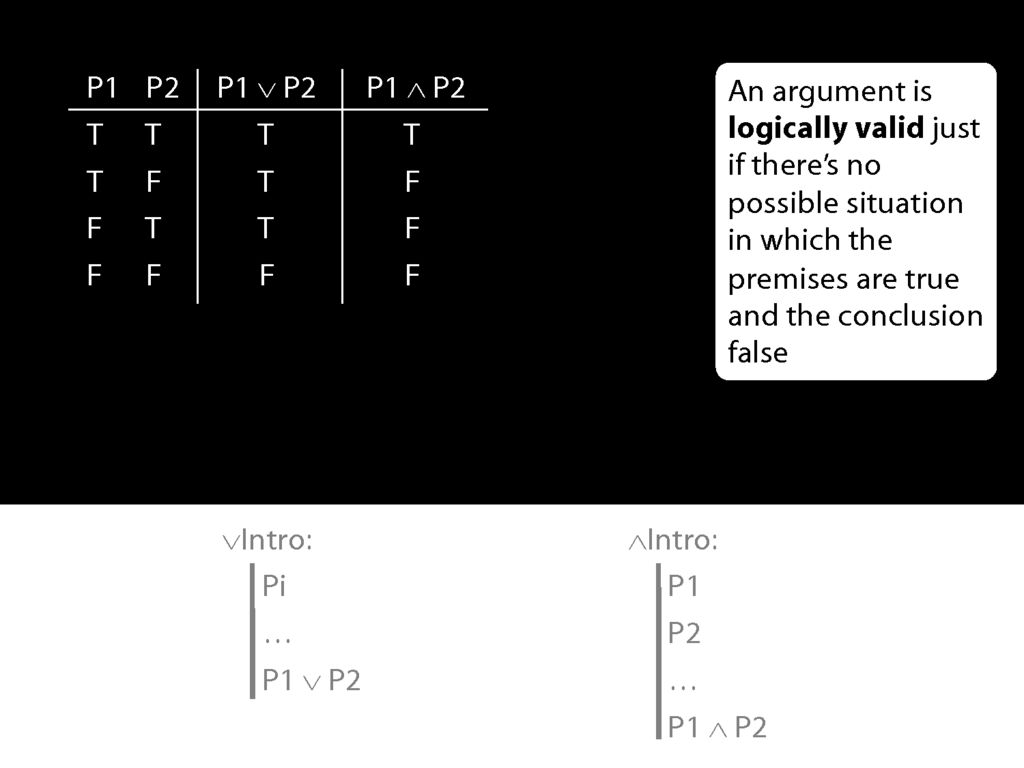
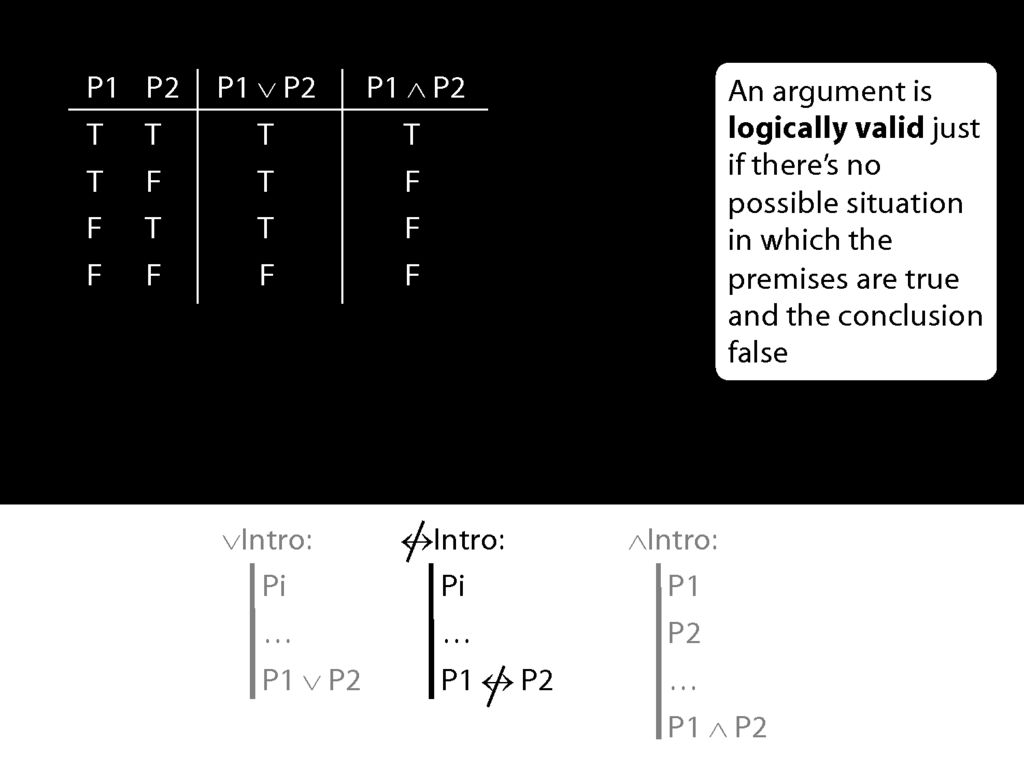
Suppose we have a connective called 'is not eqivalent' and we stipulate this introduction rule.
\begin{minipage}{\columnwidth}
Let us define a new connective with this truth table:
\end{minipage}
\begin{minipage}{\columnwidth}
The following rule is unacceptable. Why?
\end{minipage}
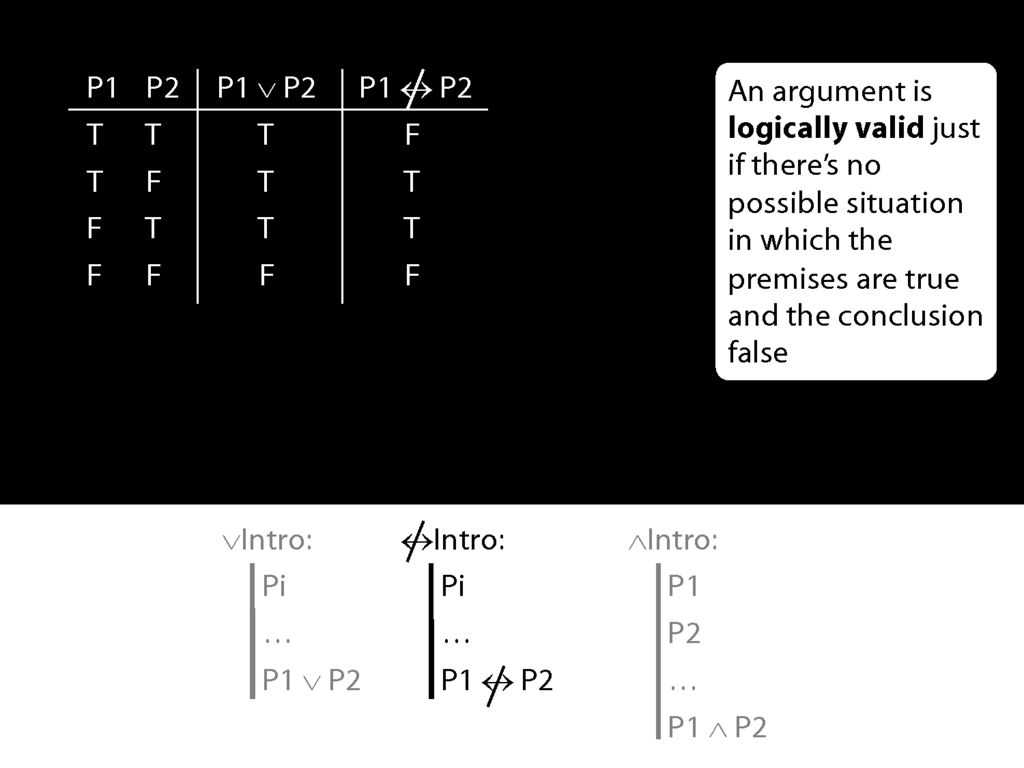
Suppose also that our new connective has this truth table, so that the 'P1 is not eqivalent to P2' is true exactly when P1 and P2 have different truth values.
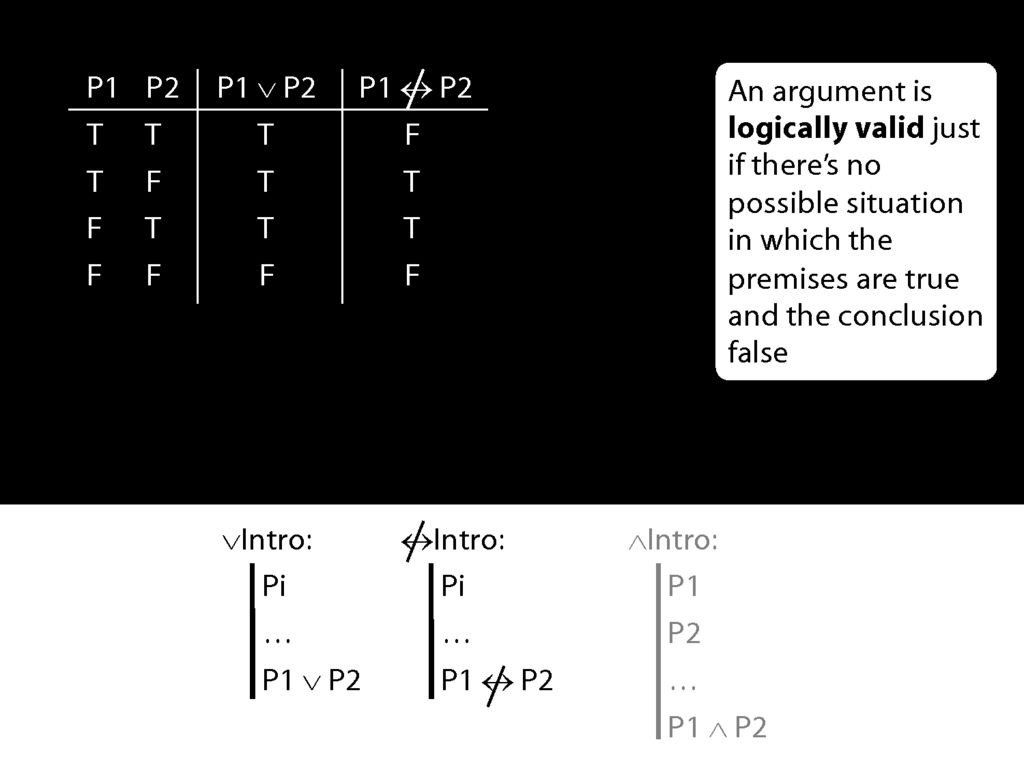
Now the rule for not-equivalent-intro is just like the rule for disjunction-intro.
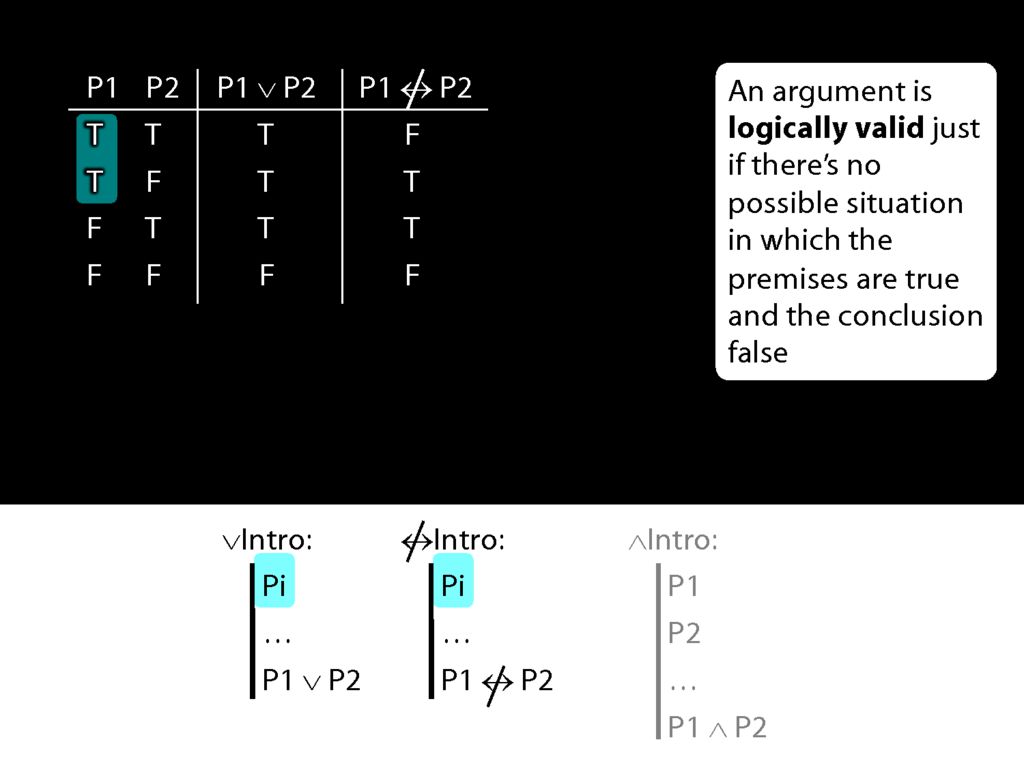
What happens when the prerequsite for these rules is true?
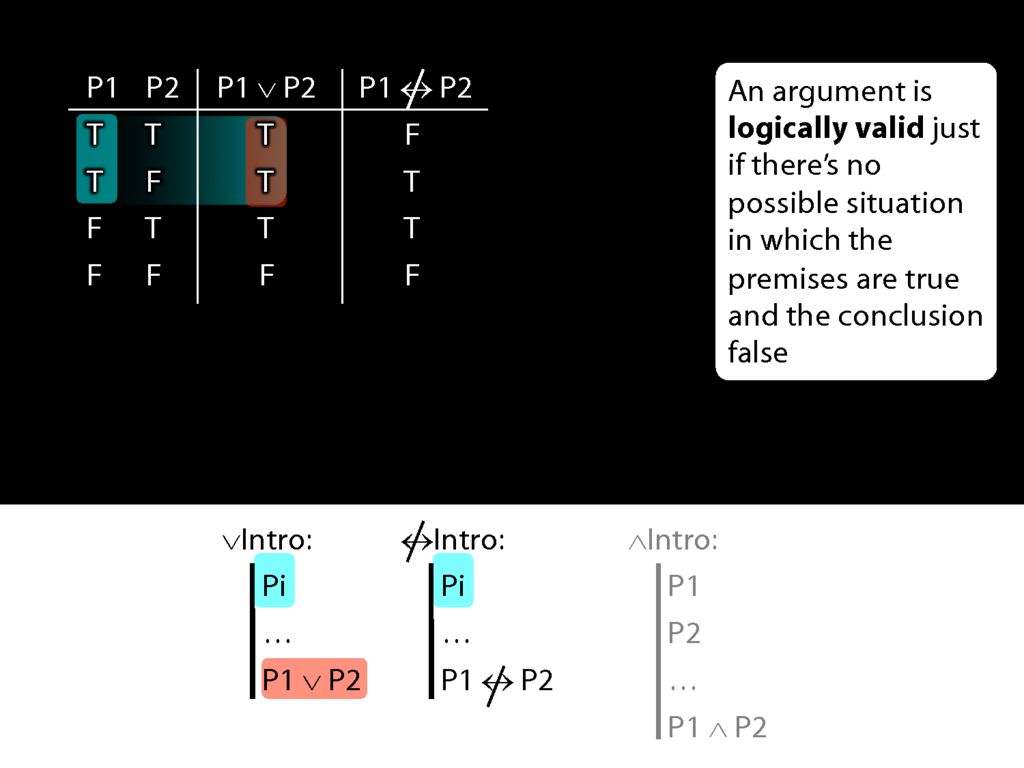
The disjunction that we can introduce with disjunction-intro is true.
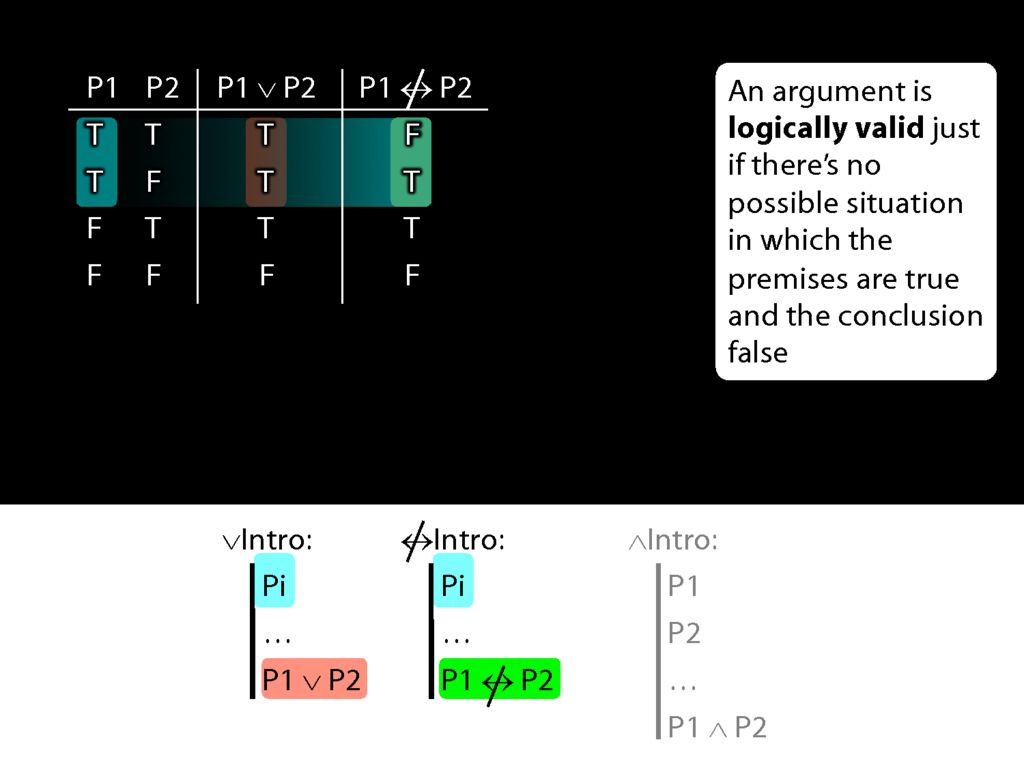
But the sentence that we can introduce with not-equivalent-intro is sometimes false and sometimes true.
So the new rule not-equivalent-intro would allow us to move from truths to falsehoods.
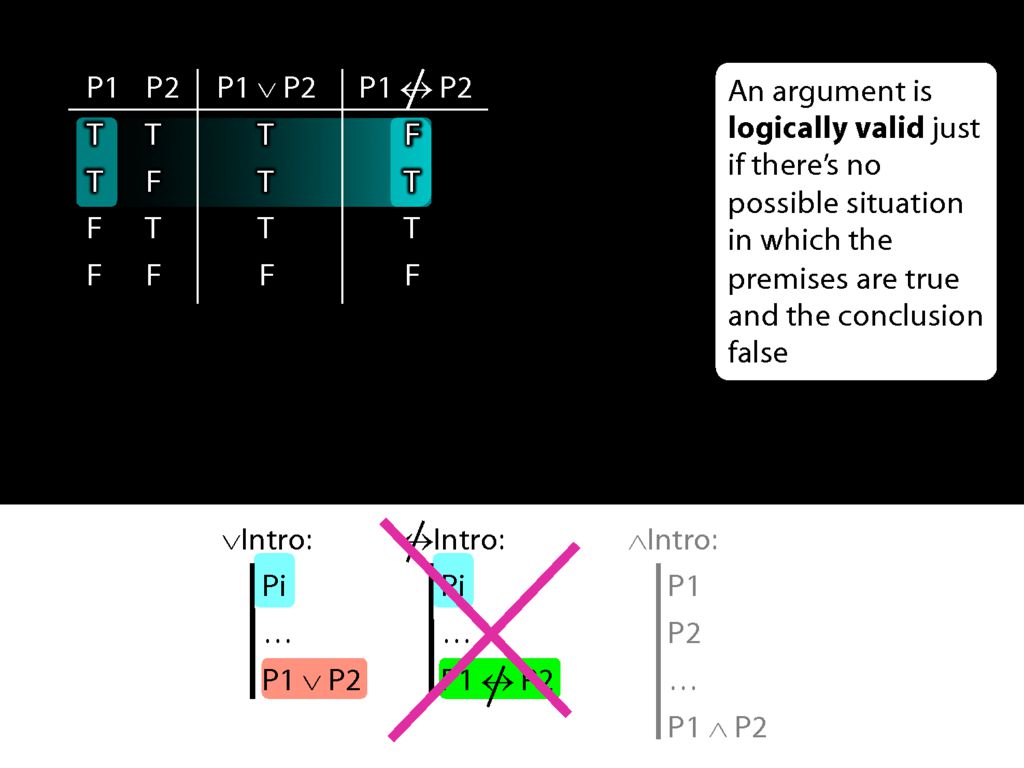
That's why we shouldn't have this rule.

Truth-functional Connectives
\section{Truth-functional Connectives}
\emph{Reading:} §7.0 (the text before §7.1)
\section{Truth-functional Connectives}

A \emph{connective} joins zero or more sentences to make a new sentence. Examples of connectives include: `∧', `¬', `$\bot$' and `because'.
A sentence joined by a connective is a \emph{constituent}. For example, consider the sentence ‘P because Q’: P is a constituent of this sentence.
A \emph{truth functional connective} produces a new sentence whose truth value depends only on the truth values of its constituent sentences.
When P and Q are both true, ‘P because Q’ is sometimes true and sometimes false. Therefore, ‘because’ is not a truth functional connective. To illustrate, consider `Alan got yellow cards because some apples are green' and `Alan got yellow cards because he used his elbows'. All the constituent sentences are true, but the first sentence is false whereas the second is true.
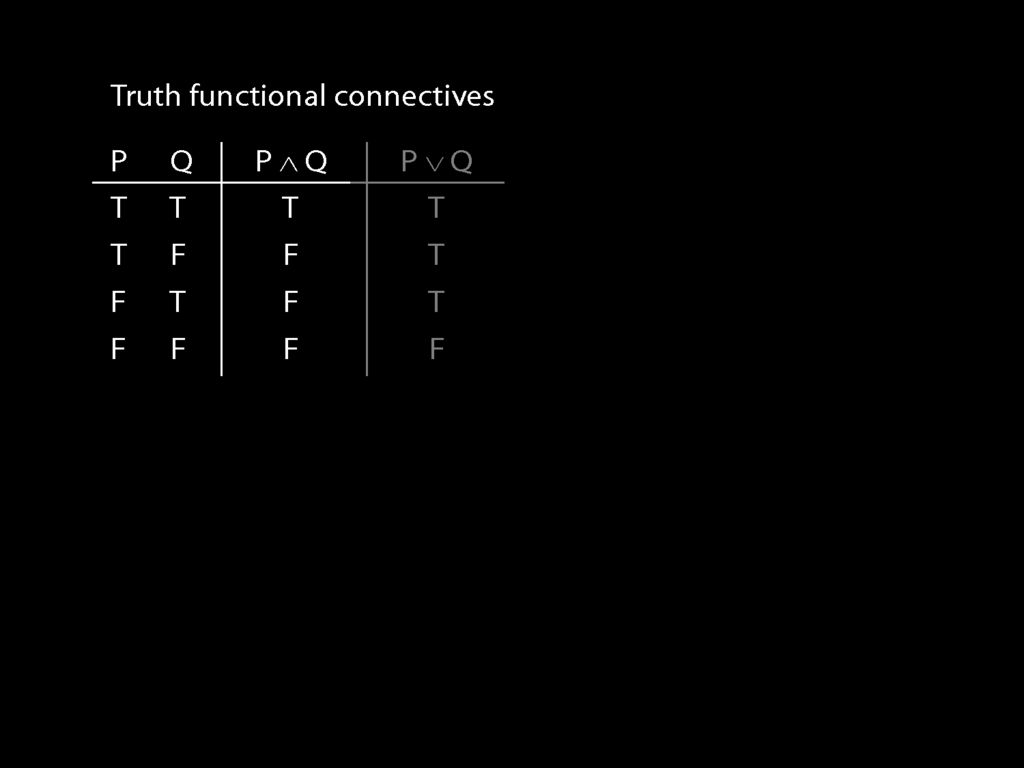


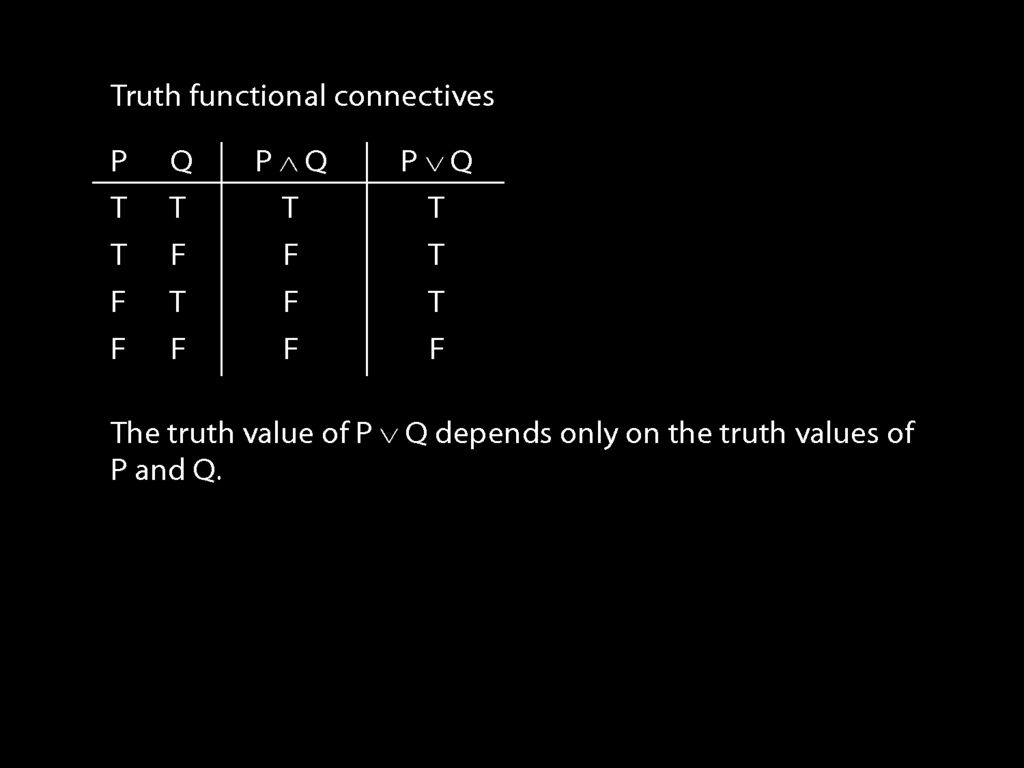










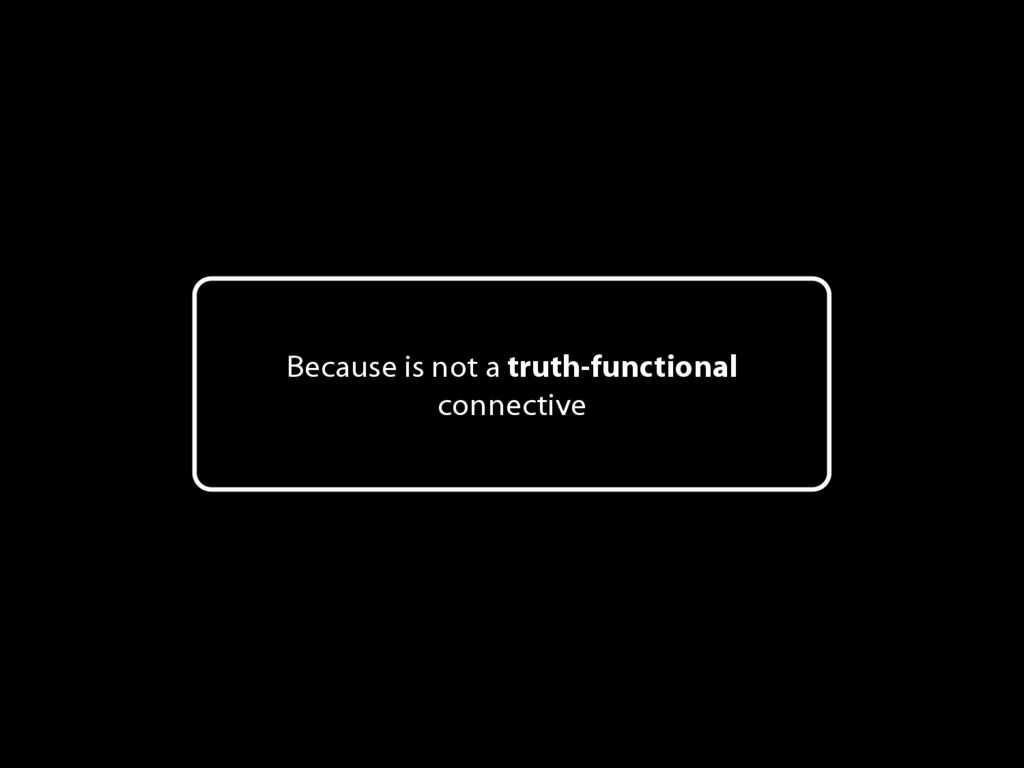

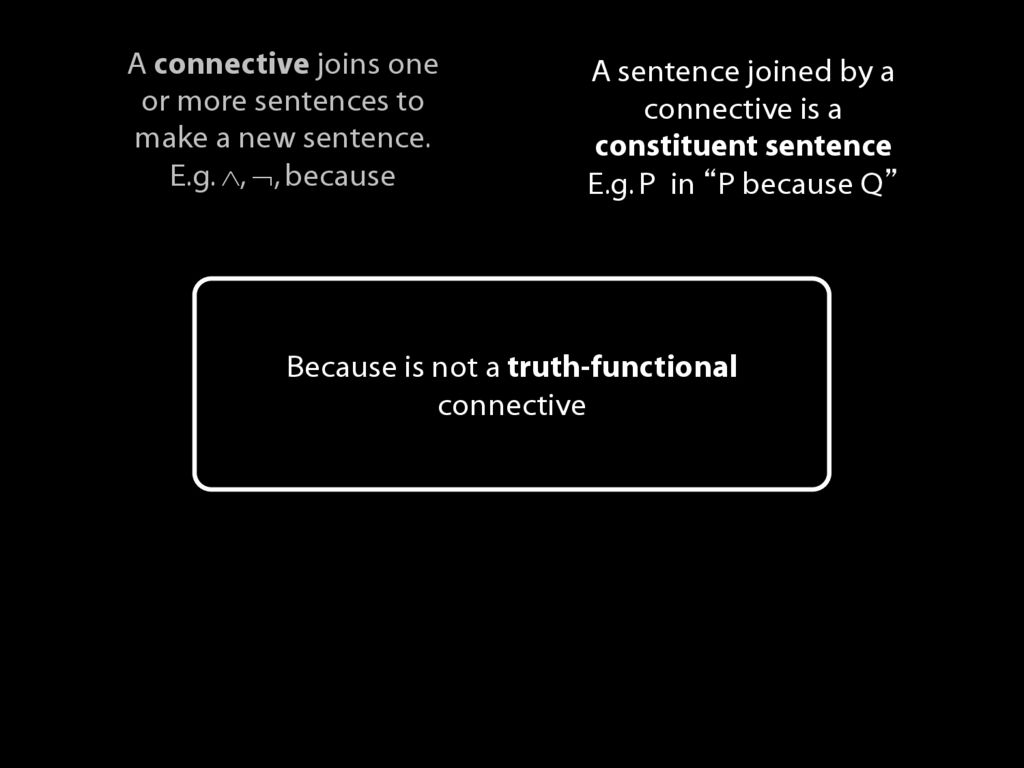
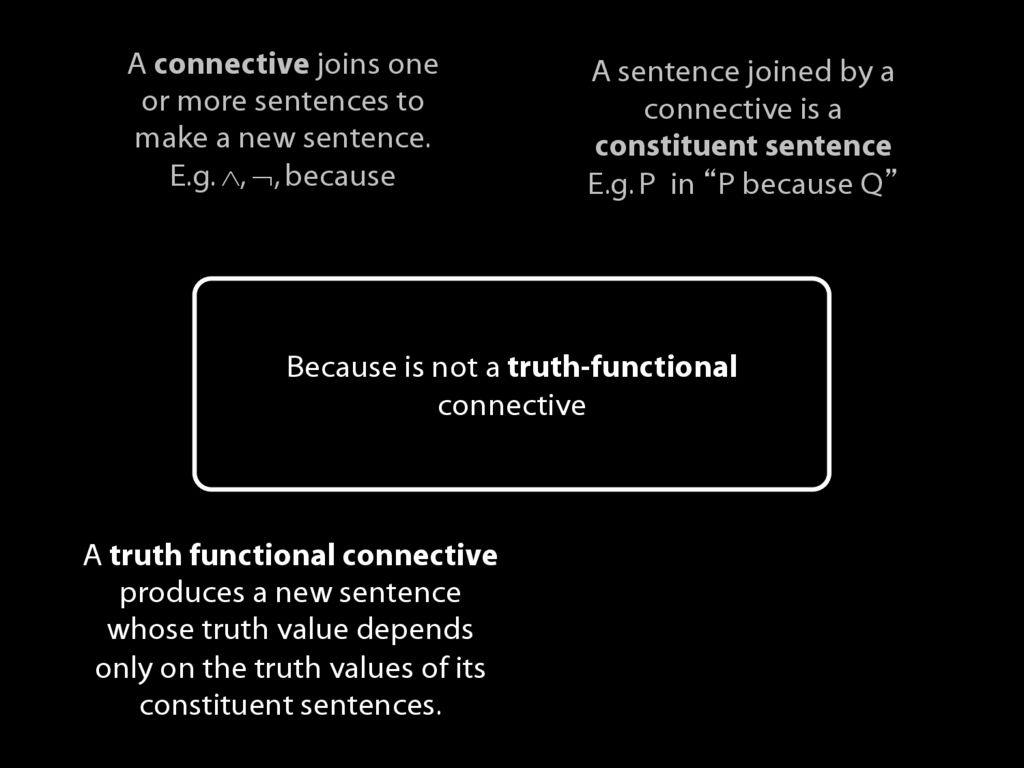

7.9
7.9
Too slow? Try fast-track.
Dissatisfaction is good
\section{The Storm Clouds on the Horizon Were Getting Nearly Directly Overhead}
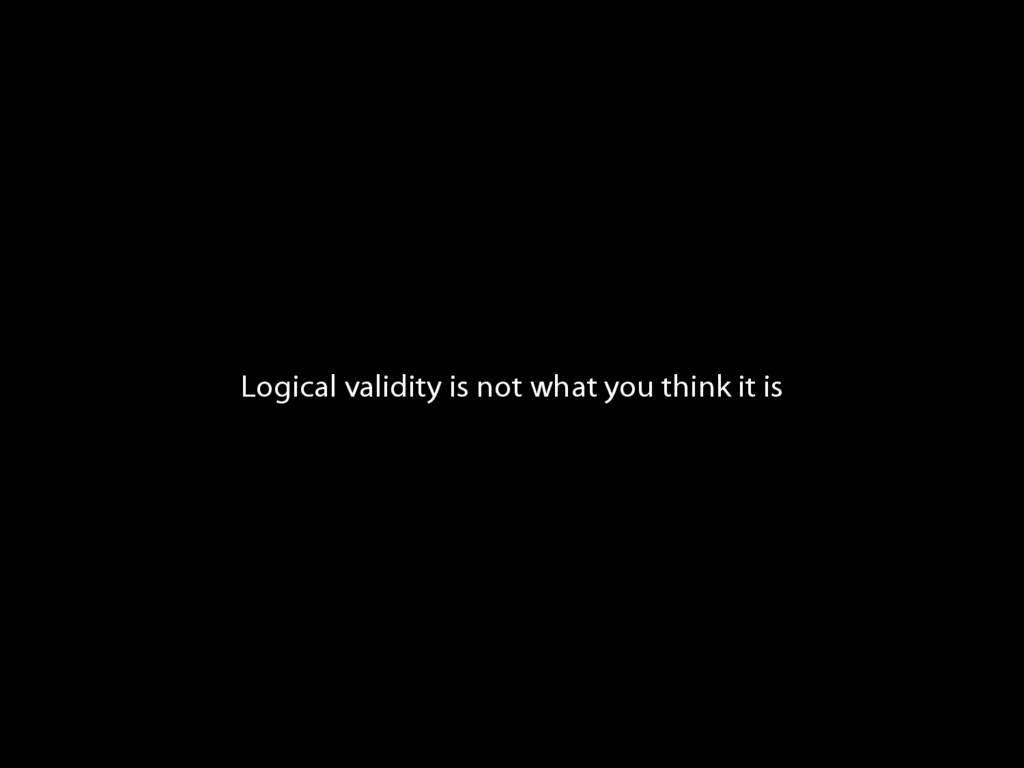

No because logic.
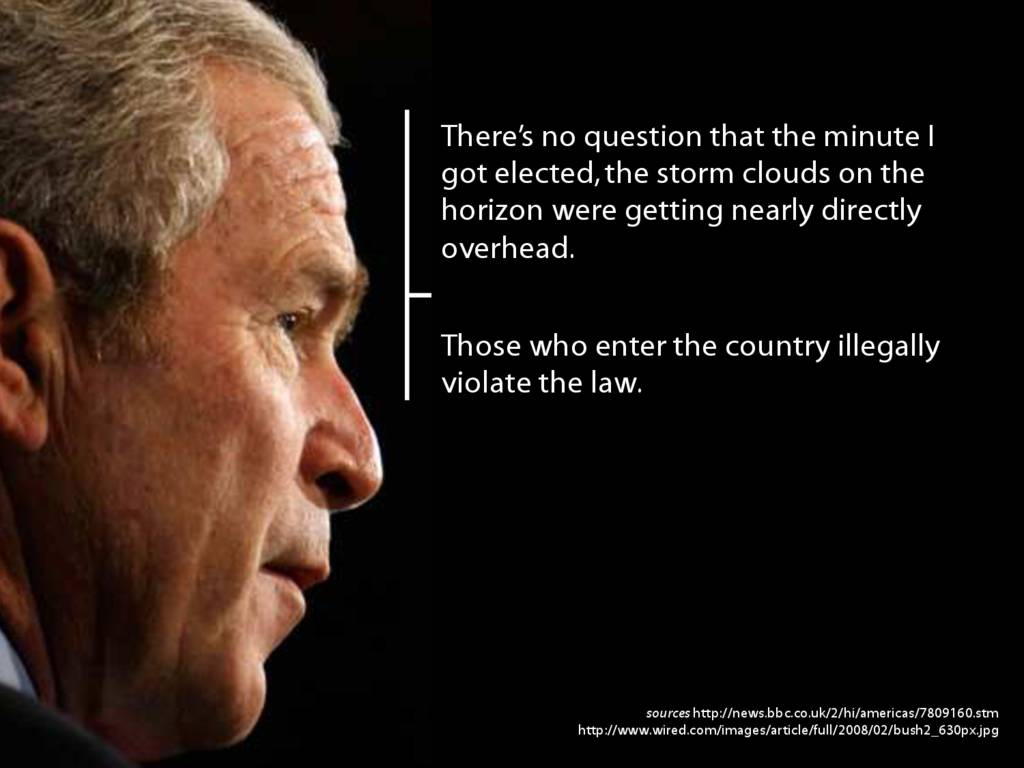
Yes because logic.
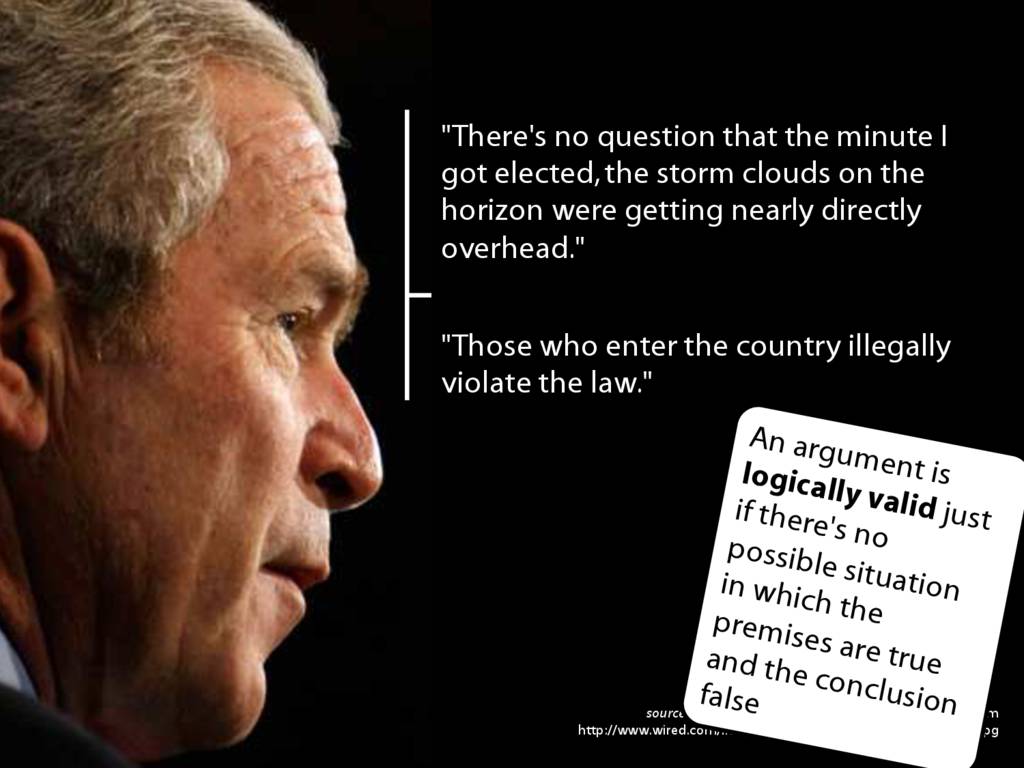
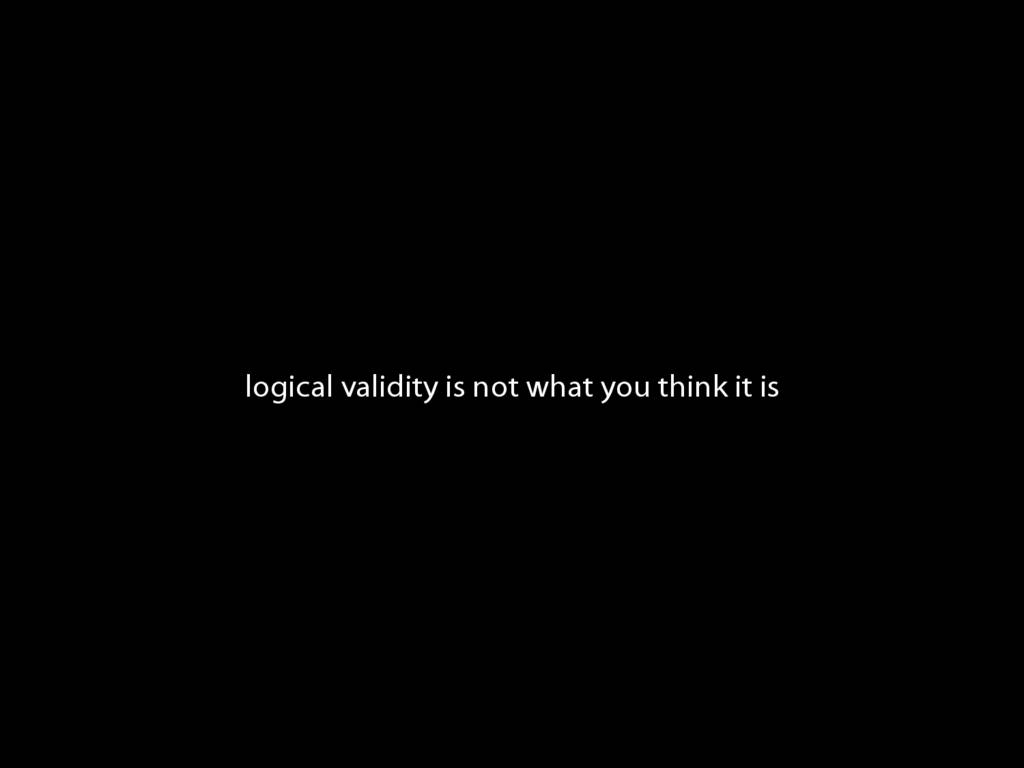

A ∧ B ∨ C
\section{A ∧ B ∨ C}
\emph{Reading:} §3.5
\section{A ∧ B ∨ C}
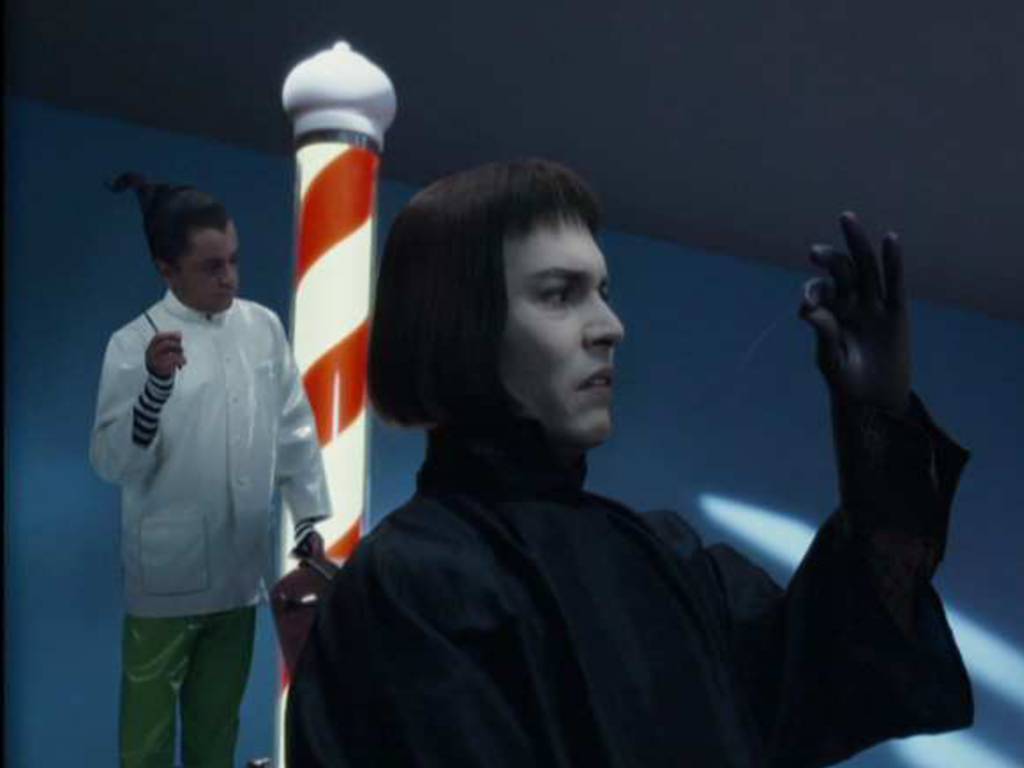
Here's Johnny Depp having his hair cut in Charlie and the Chocolate Factory.
Mrs B made me watch this film because she fancies Jonny Depp.
Ambiguity can be \emph{lexical}, e.g. `Actor testifies in horse suit'. Ambiguity can also be \emph{syntactic}, e.g. `How to combat the feeling of helplessness with illegal drugs'. (Both examples are from Bucaria, C. (2004), `Lexical and syntactic ambiguity as a source of humor: The case of newspaper headlines', Humour 17(3): 279--309.)
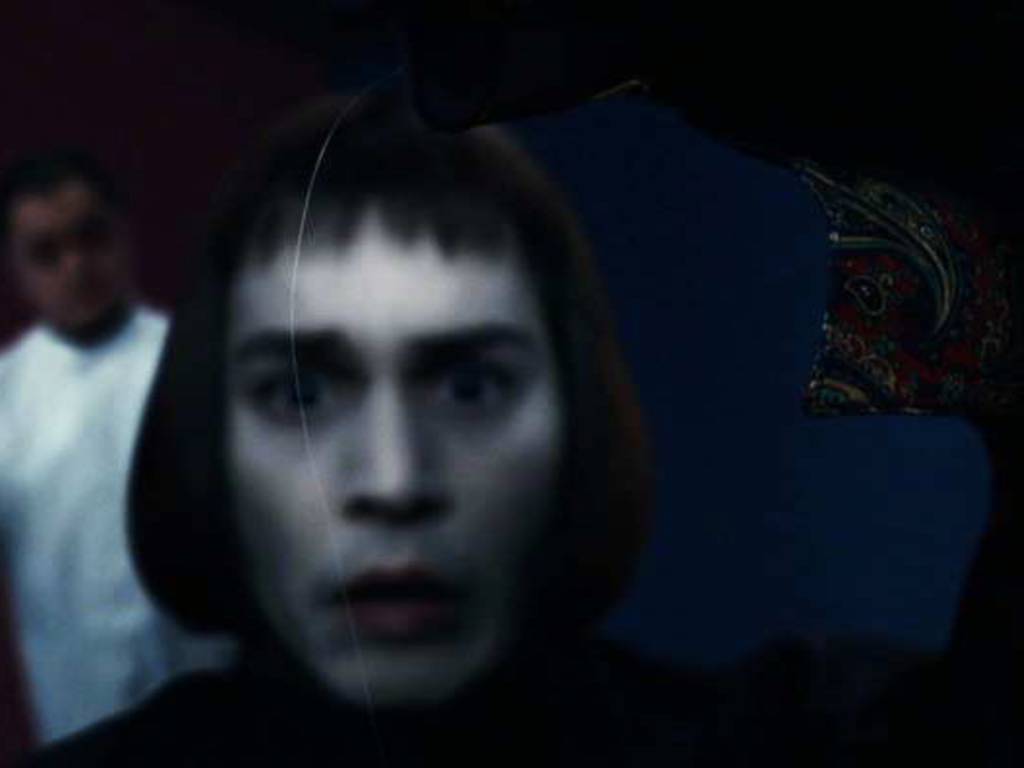
But, to be fair, how could one not?
Anyway, here he's saying 'I need a heir' and holding up a hair.
This is one example of ambiguity.
Note that here the ambiguity can be traced to a single word, 'heir' which sounds just like another word with a different meaning. We might say, the ambiguity is all in the word.

Now contrast a statement like 'two puffins ate six fish'.
This statement is ambiguous because there are two quite different ways of understanding it.
Here you see one interpretation where There were two puffins: and they ate six fish
This interpretation is good for the puffins, less good for the fish.

Here's the other interpretation of 'two puffins ate six fish'. Here it means there were six fish: and two puffins ate them.
So less happy puffins.
Here's the key thing, though. The sentence 'Two puffins ate six fish' is ambiguous but the ambiguity is not due to any particular word. It's not that the word 'puffin' is ambiguous, for example.
This matters because it shows that not all ambiguity is lexical; some of it is, as linguists might say, synatactic or structural.
But why does ambiguity matter to us?
We are constructing a formal language and we want each sentence to have just one truth value, true or false.
In our formal language, we don't want sentences that are true and false.
This means of course that we need to avoid ambiguity.
Insofar as ambiguity is merely lexical--insofar as it is linked to particular words having multiple meanings--it's easy to avoid.
To avoid that sort of ambiguity, lexical ambiguity, we just have to avoid defining words twice. Easy.
But how can we be sure that our formal language involves no syntactic ambiguity?
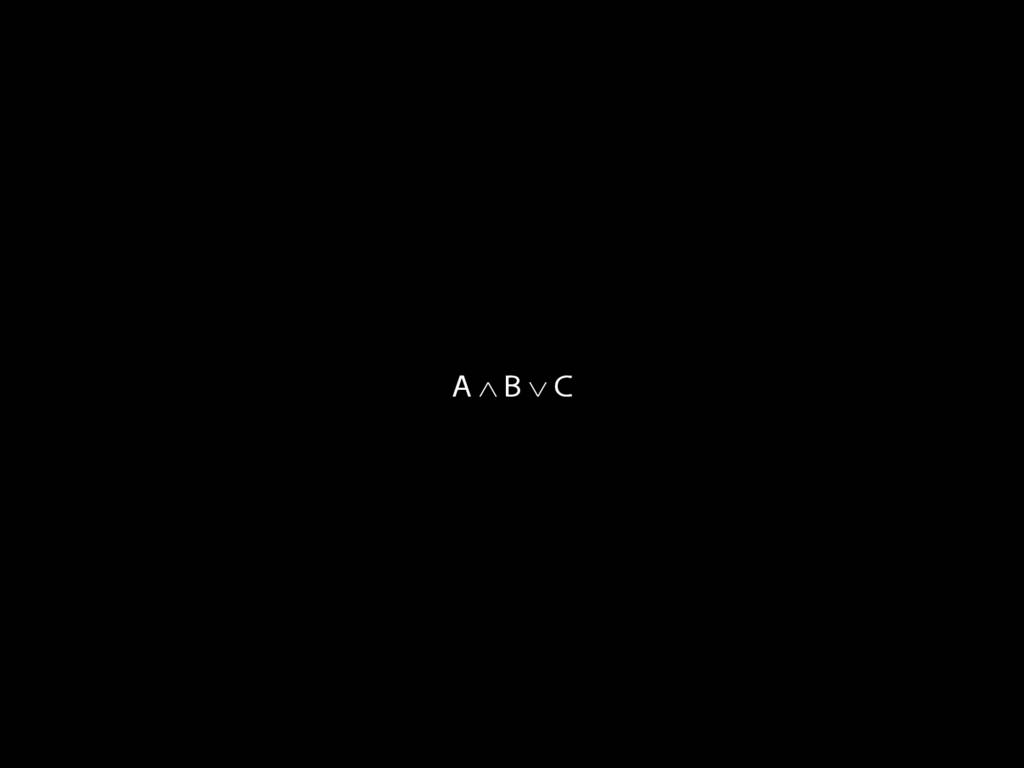
Consider this thing (it's not a sentence). If we allowed this into our language, we'd have problems.
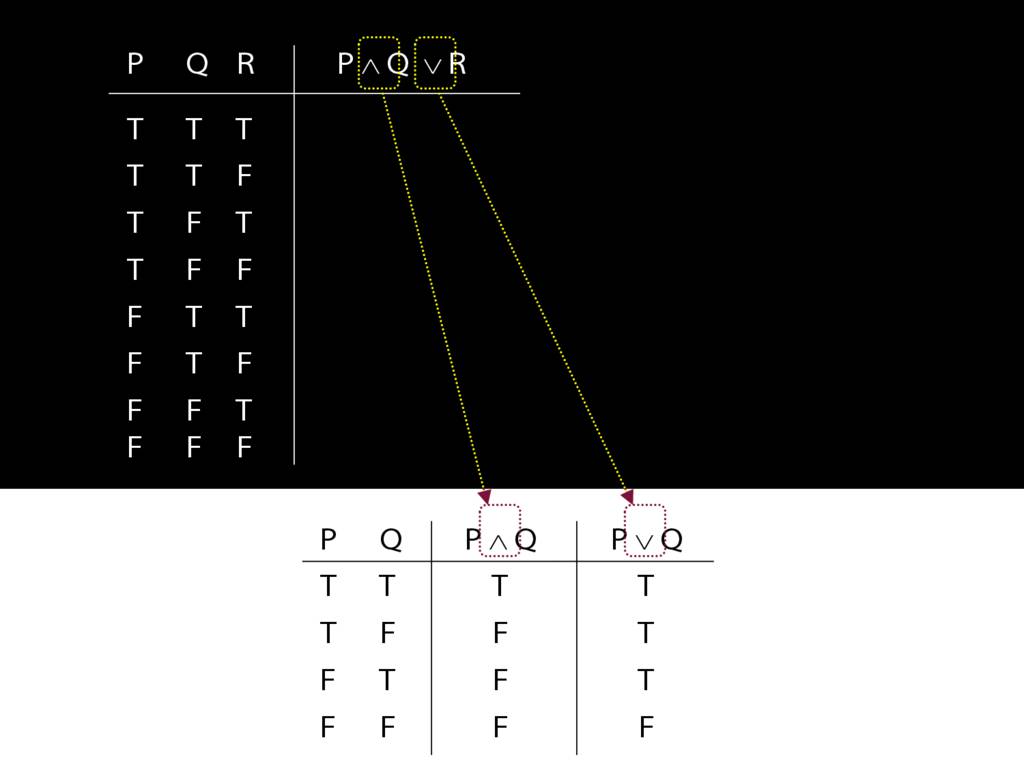
For one thing, we'd not be able to say what the right way to construct its truth table is.
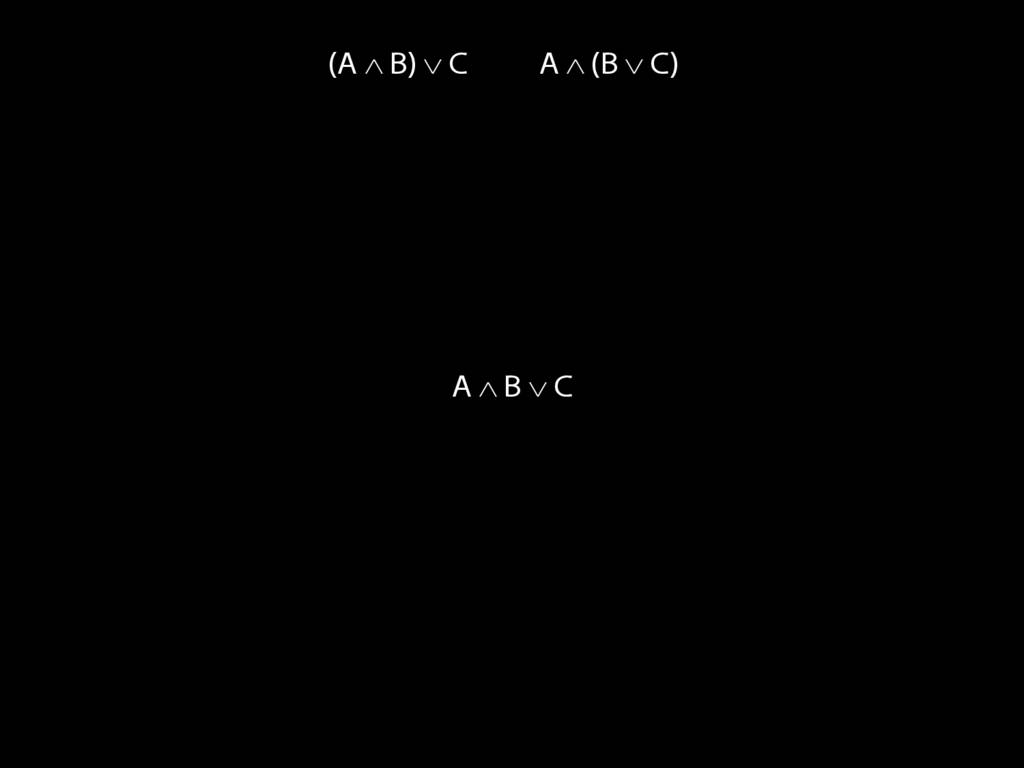
Now this thing is not a sentence. Instead we have two distinct sentences, (A ∧ B) ∨ C and A ∧ (B ∨ C).
Just a moment ago I asked, How can we be sure that our formal language involves no syntactic ambiguity?
The simplest answer is: because we use brackets.
It's important to realise this, but it's not a very satisfying answer for two reasons.
First, it's not satisfying because we don't know \emph{how} the brackets enable us to avoid ambiguity. The answer doesn't enable us to prove that our language contains no ambiguous sentences.
And, second, it's not satisfying because we haven't said anything yet about what the brackets mean. We can't just throw symbols into our language without explaining them. (This is the down side of having a formal language: we have to say what everything means explicity, since it's a creature of our own creation.)
3.20, 3.21, 3.22
\section{A ∧ B ∨ C: the Truth-tables}
\section{A ∧ B ∨ C: the Truth-tables}
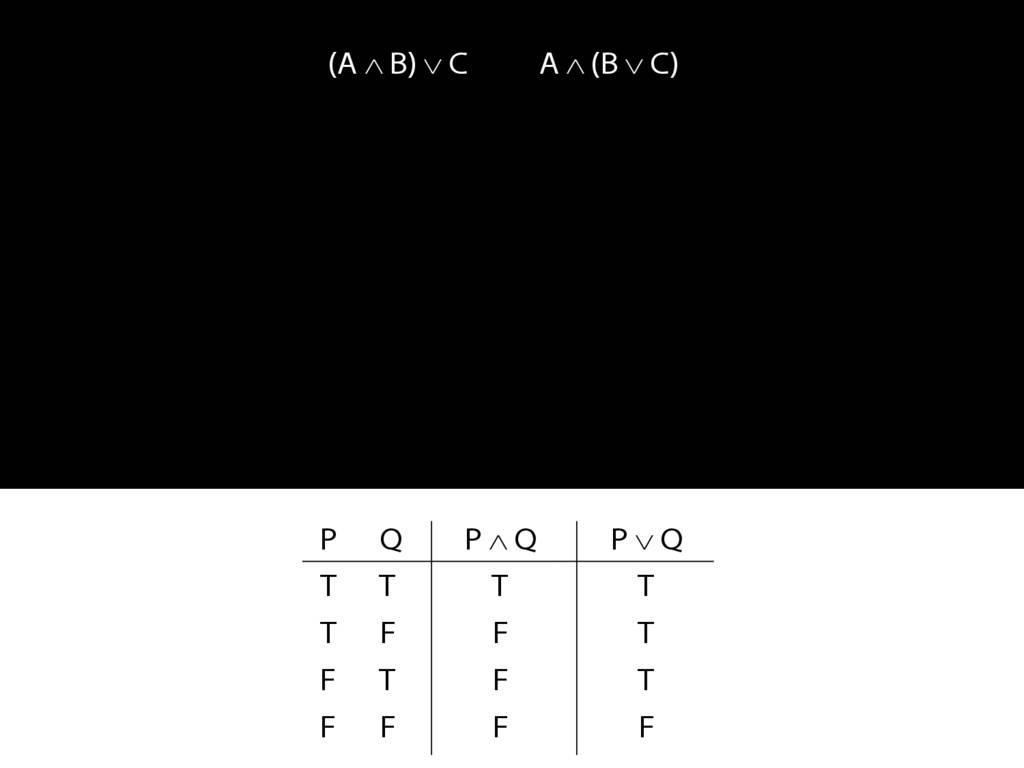
Let us examine how these two sentences, (A and B) or C versus A and (B or C), differ using truth tables.

We have quite a few rows to fill in so it's worth thinking about short cuts.
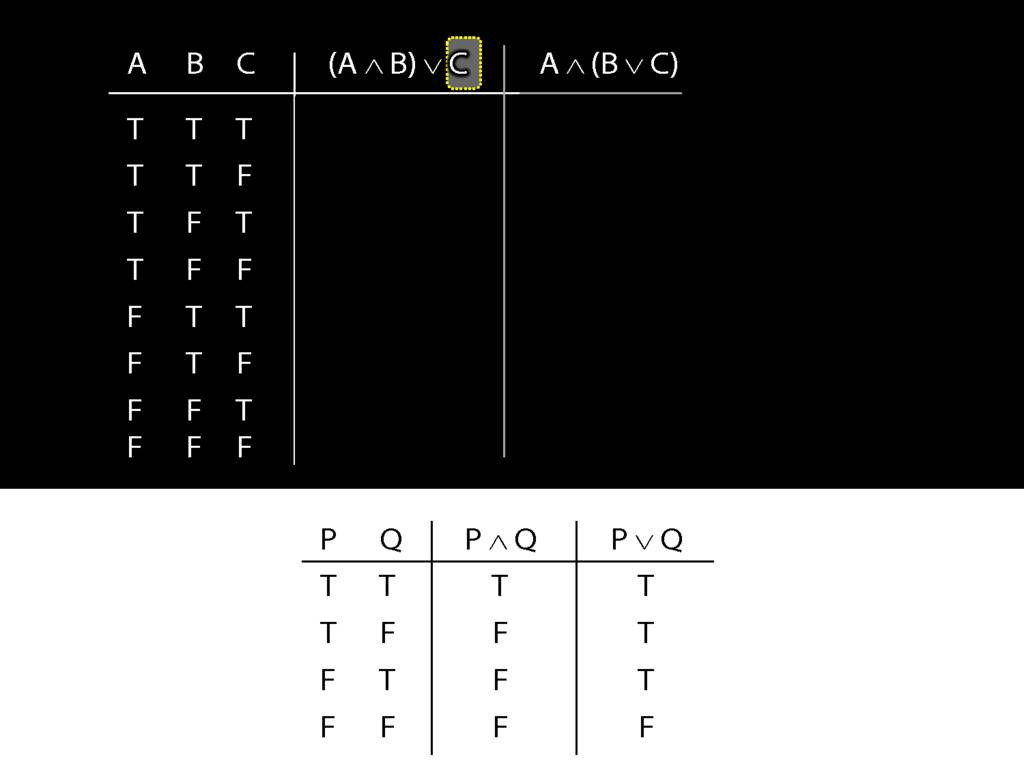
Think about this C on the right hand side of the disjunction.
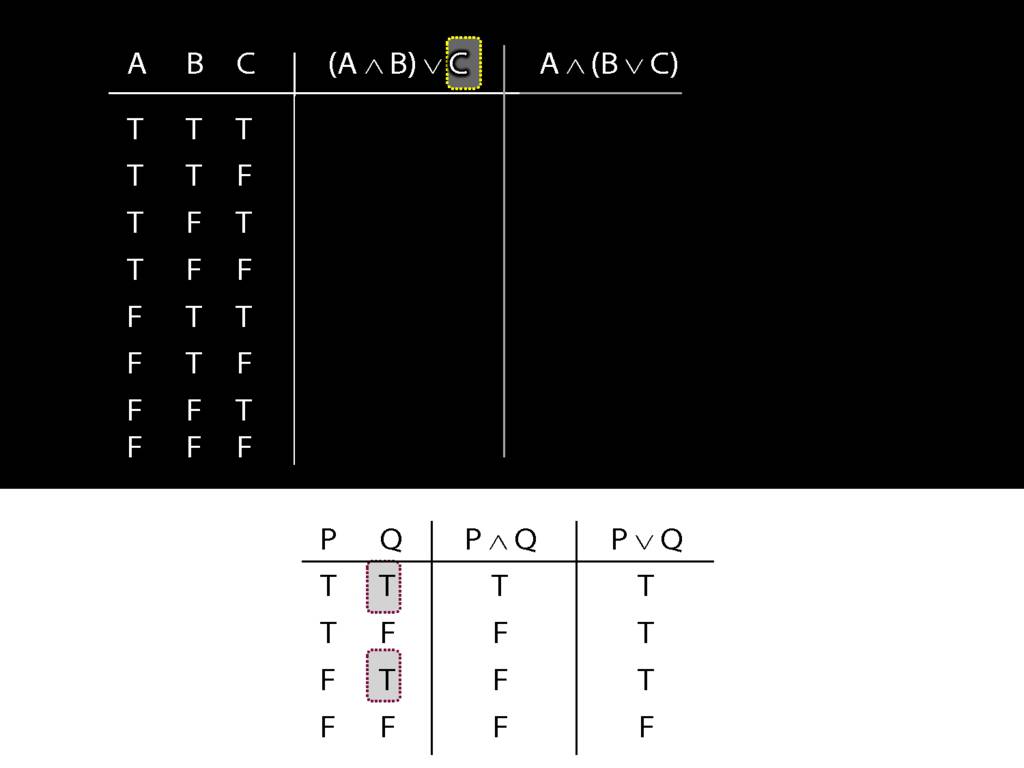
Whenever a disjunct is true ...
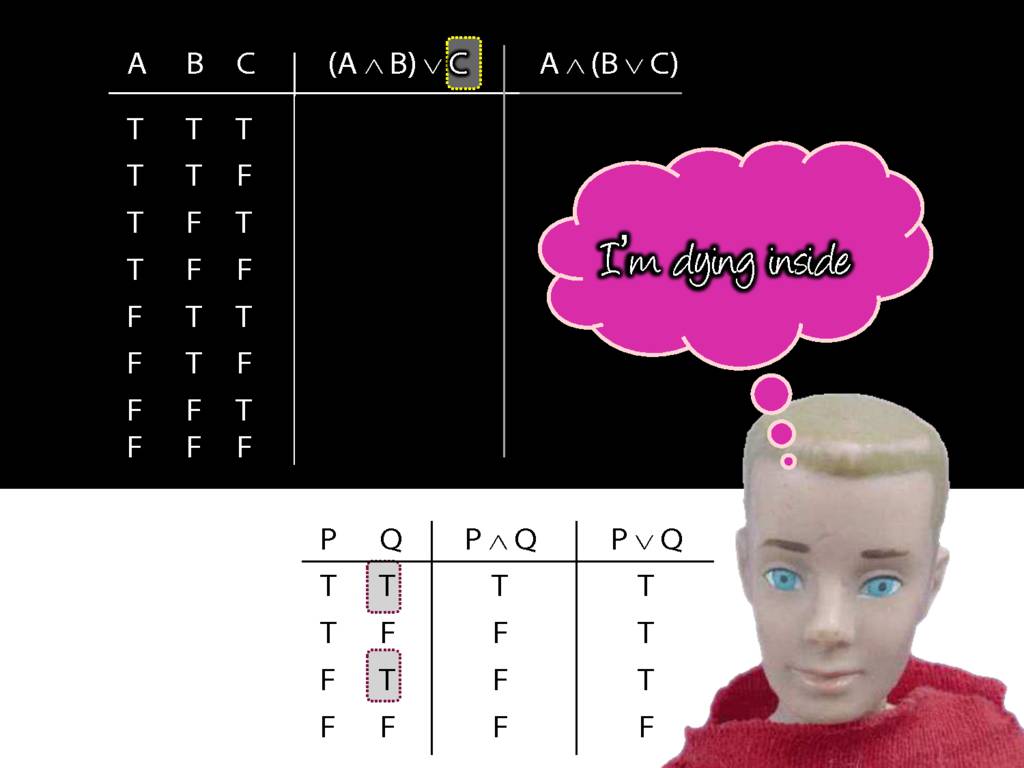
... oops, Ken says he's dying inside.
For most people that would be an exaggeration, but for Ken it's actually an understatement of his problems.
Anyway, I hope it isn't because of logic.
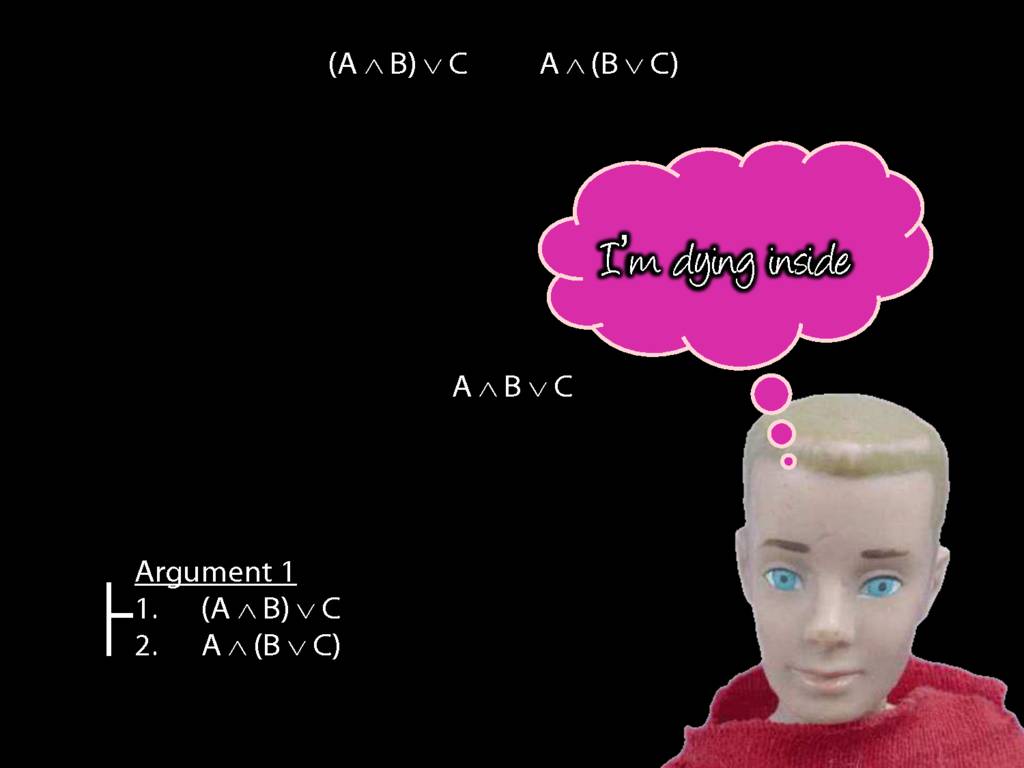
If this is too easy, try an exercise while I'm talking about the truth tables.
Here's one argument ...
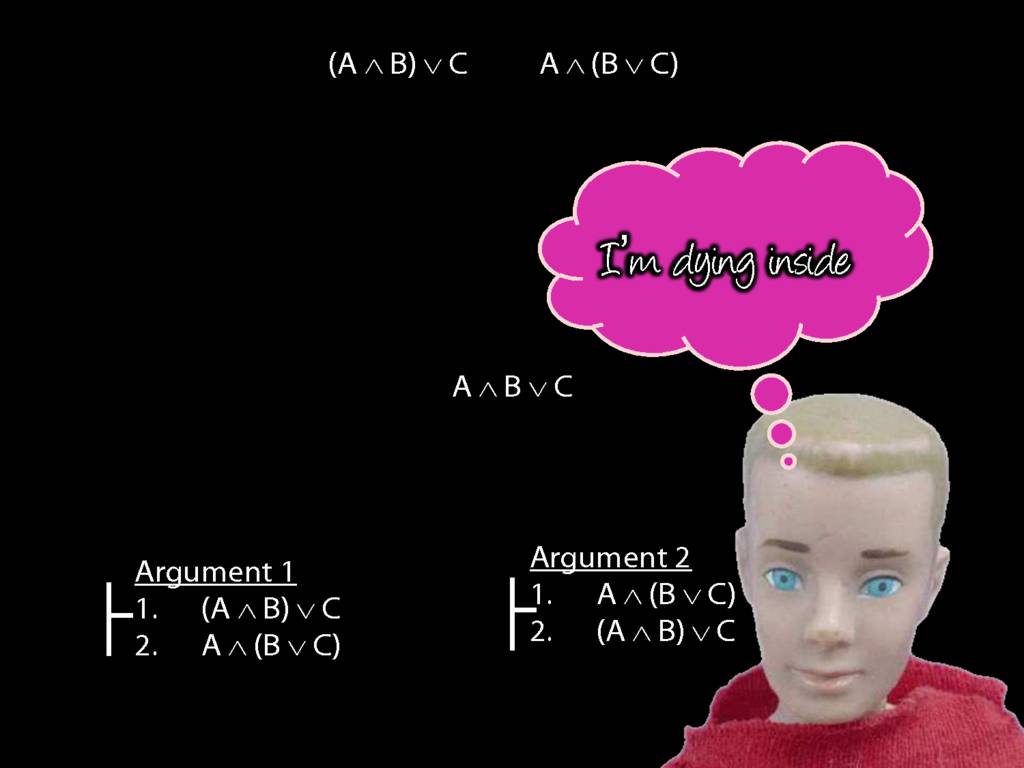
... and here's a second argument. Your exercise is to say which is valid and which is not valid.
For the invalid argument, give a counterexample.
For the valid argument, give a Fitch proof.
While you are doing that, the rest of us will go back to thinking about truth tables.
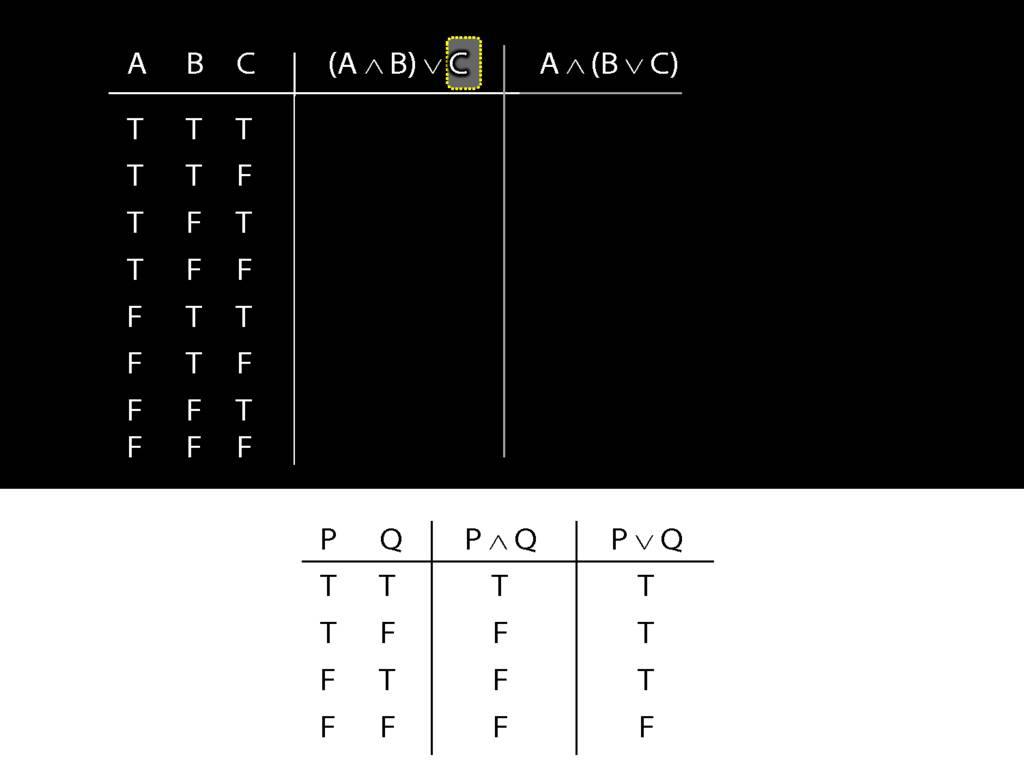
So we were thinking about the right disjunct of the first sentence, C.
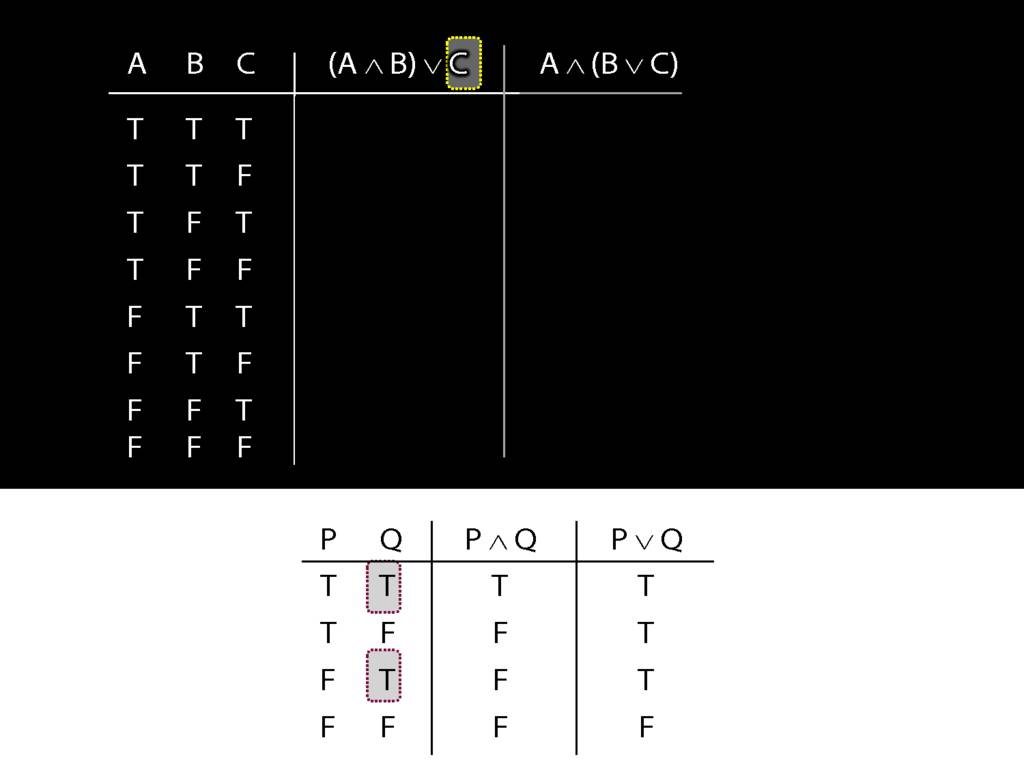
What happens when this disjunct is true?
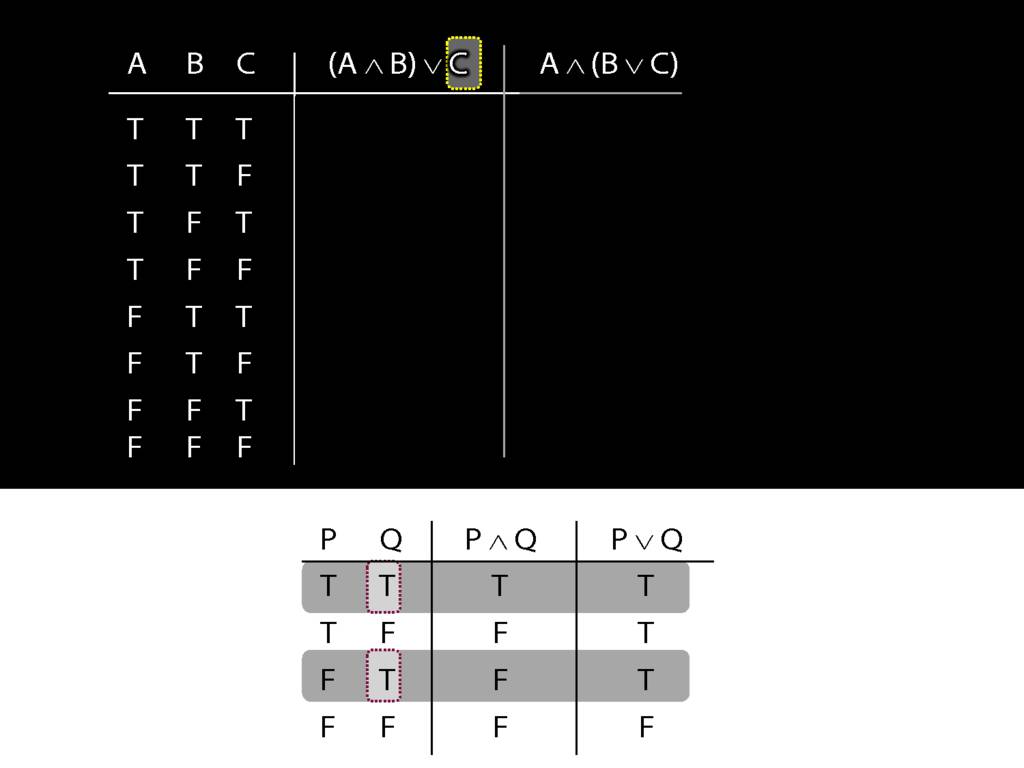
The whole sentence is true, regardless of what the truth value of the other (left) disjunct is.

So in every row of the truth-table in which C is true, ...

... these four rows ...
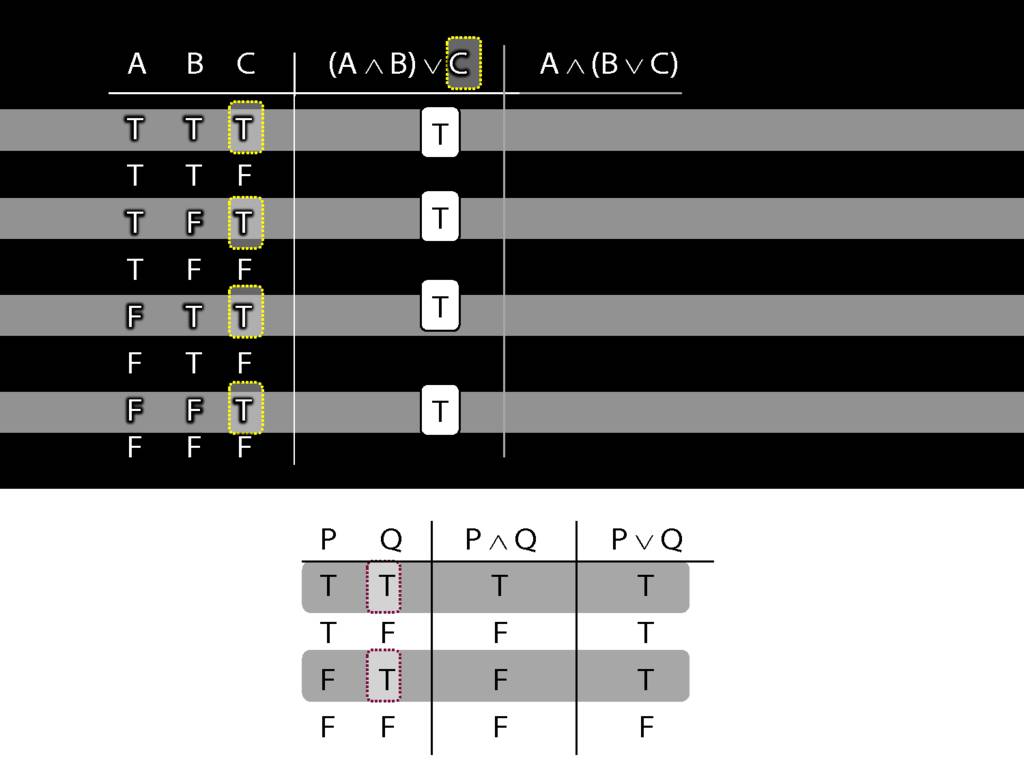
... we know that the whole sentence is true.


Now consider row four. Here we have to do it the slow way.

We start at a point innermost in the brackets, so with A and B.

What is the truth value of A and B in this row?
That depends on what the main connective in this sentence is, and on what the truth values of A and B are.

In this row, A is true and B is false.

And the connective is conjunction.

So the truth-table we need to consult is the one for conjunction.

It's the second row that we want because this is the row where A is true and B false.
In this row of the truth-table, the conjunction is false.

And it's this truth-value that we put into our truth-table for A and B.
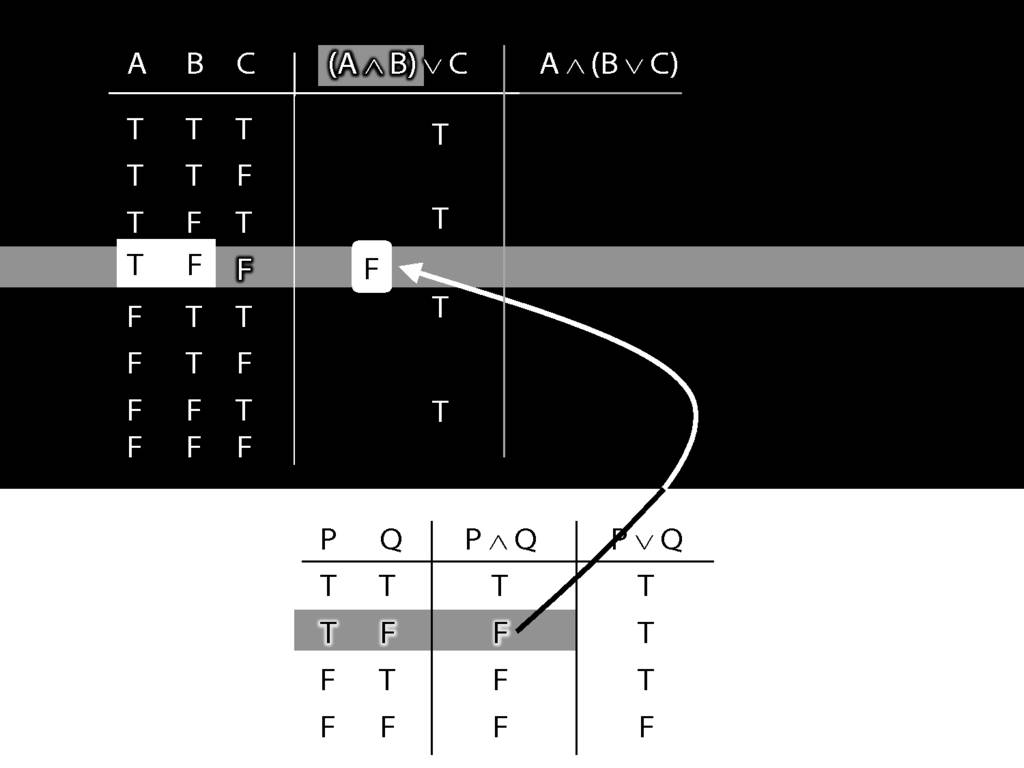
Prima!
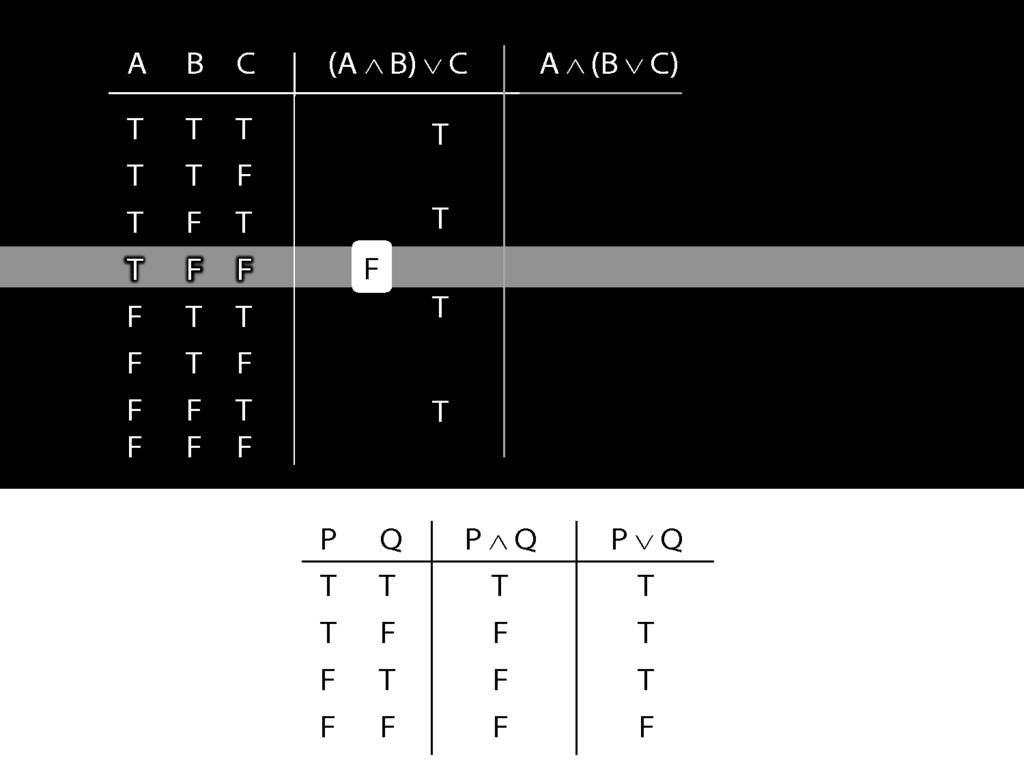
Bene!

Now we turn to the whole sentence. What is its truth value?
First we have to ask, What is the connective?
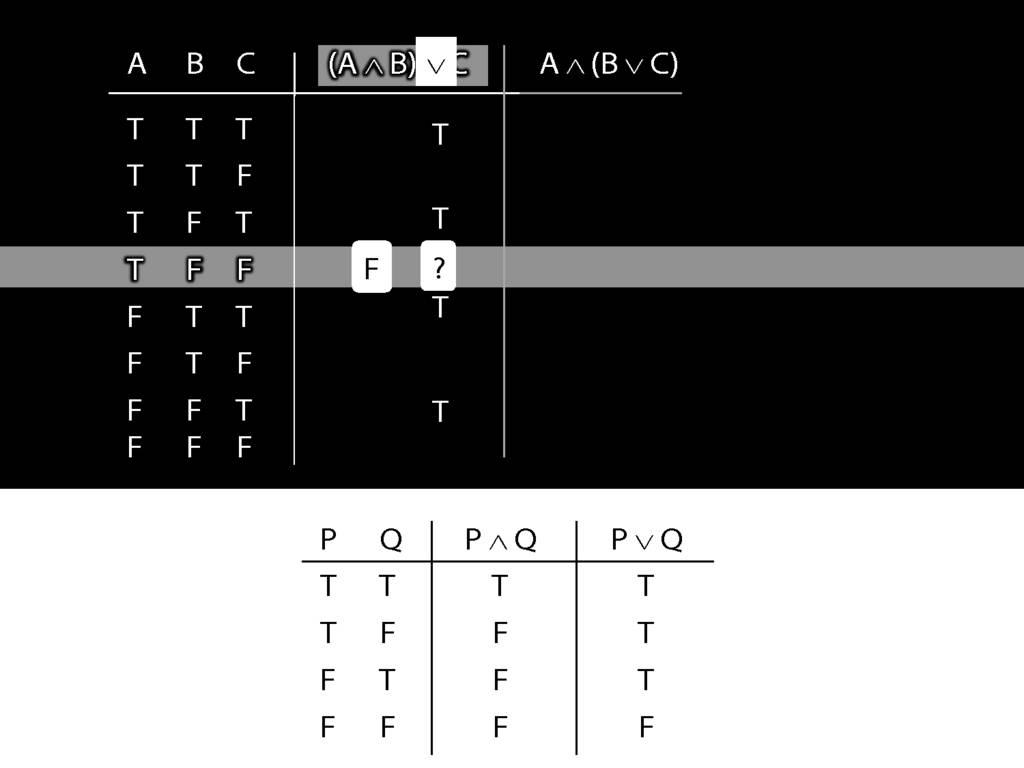
In this case the connective is disjunction.
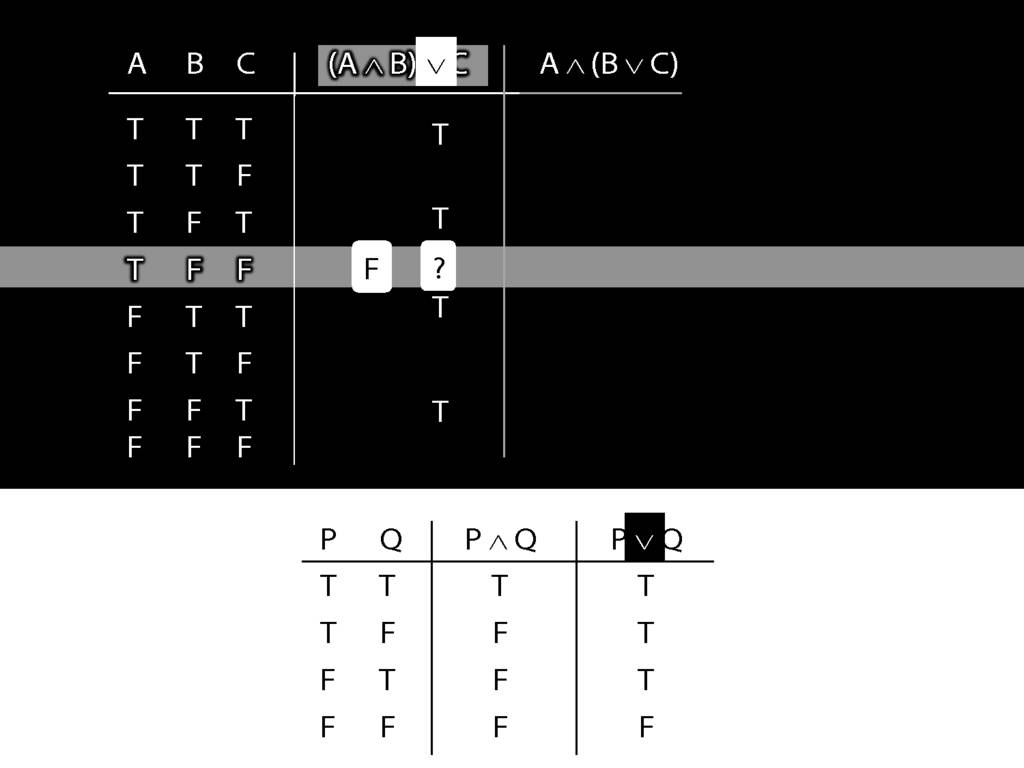
So the truth-table we need to consult is the one for disjunction.
But which row do we need?
In this case, the thing on the left of the disjunction (the left disjunct) is A and B, which is false;
and the thing on the right, C, is also false.
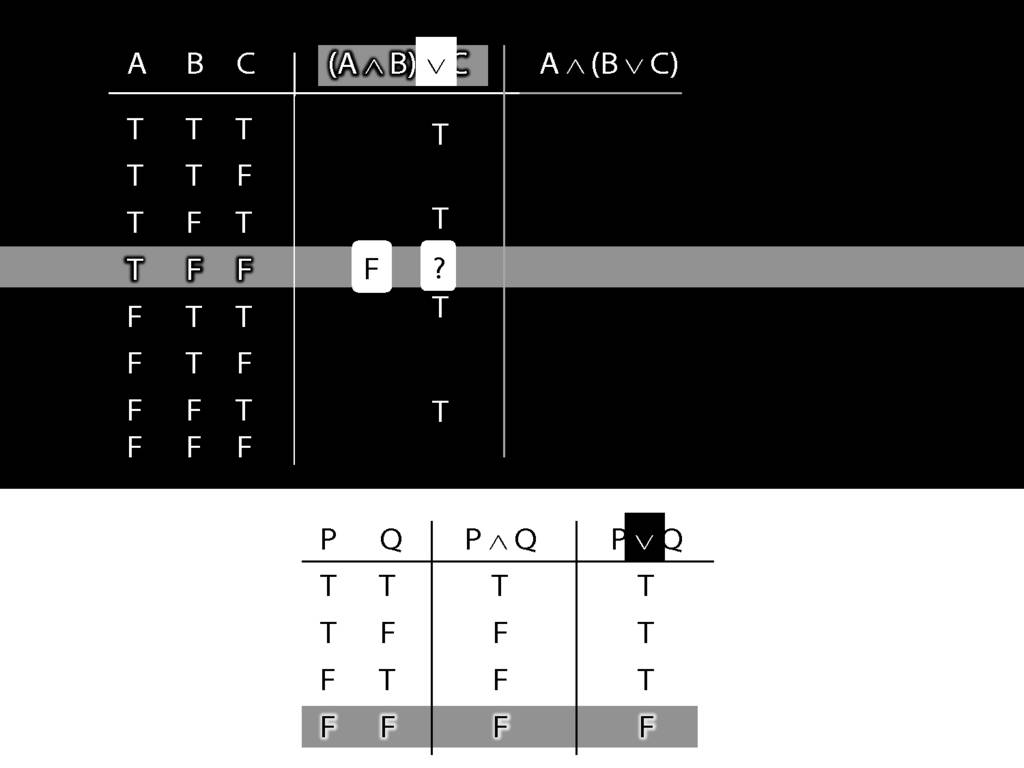
So we're looking at the last row of the truth-table, the one with false and false.
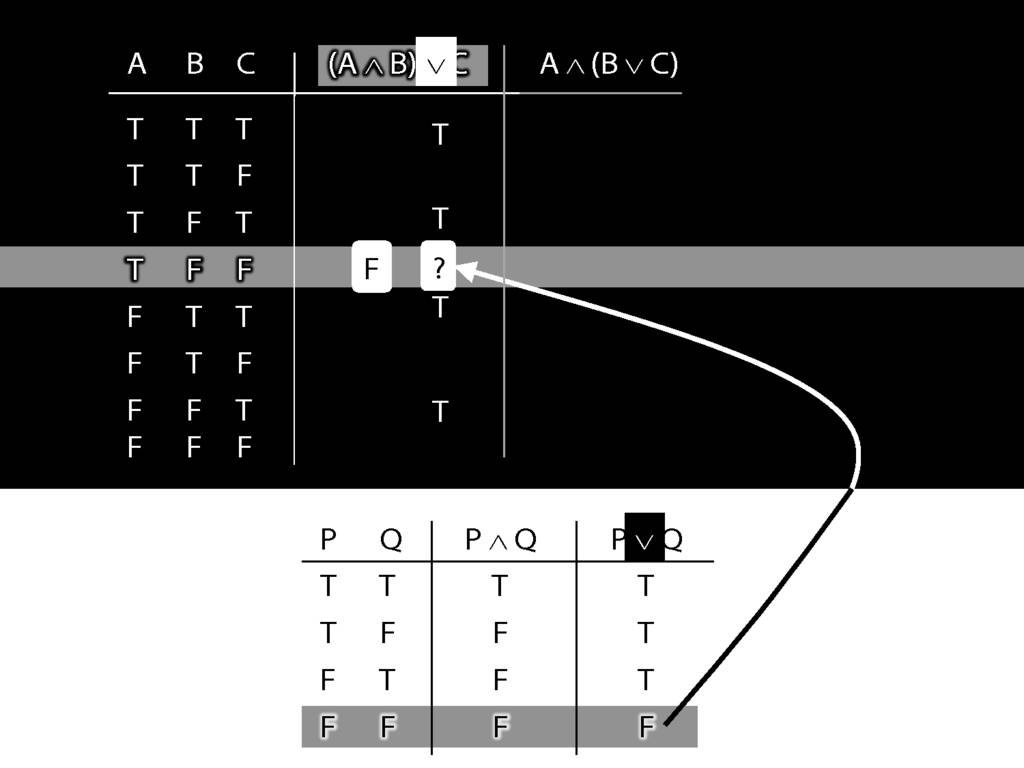
The truth-value in this row is the truth-value we need to put into the truth-table we're working on.
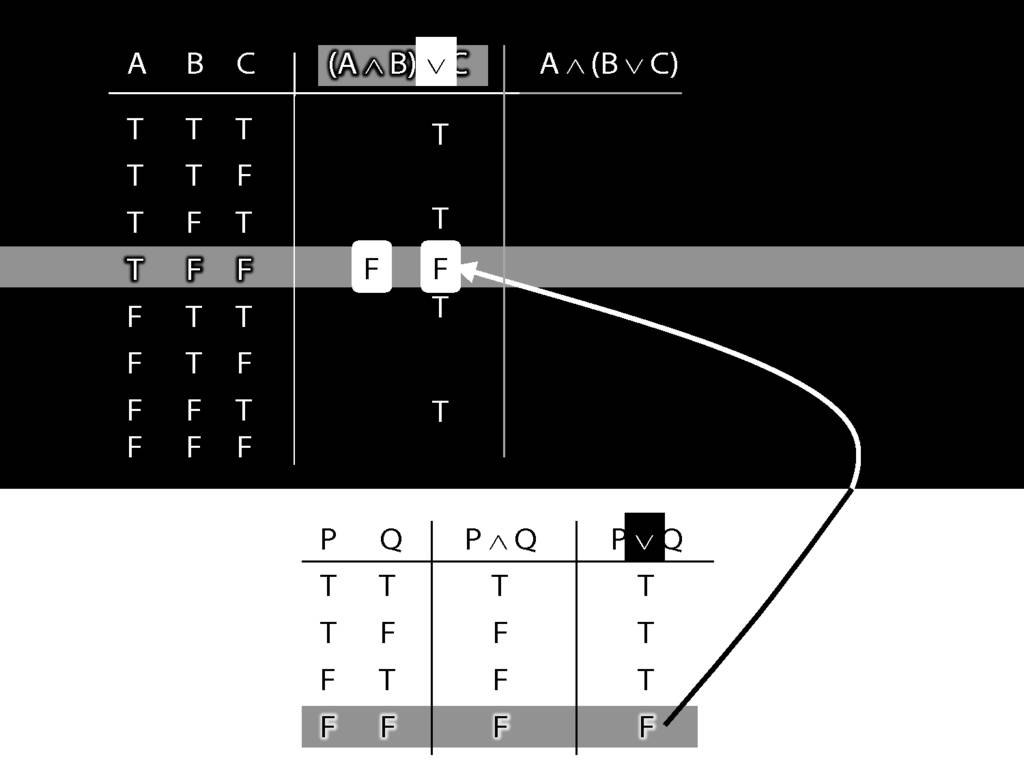
So we know that (A and B) or C is false in this row, where A is true, B is false and C is false.

Sehr gut!
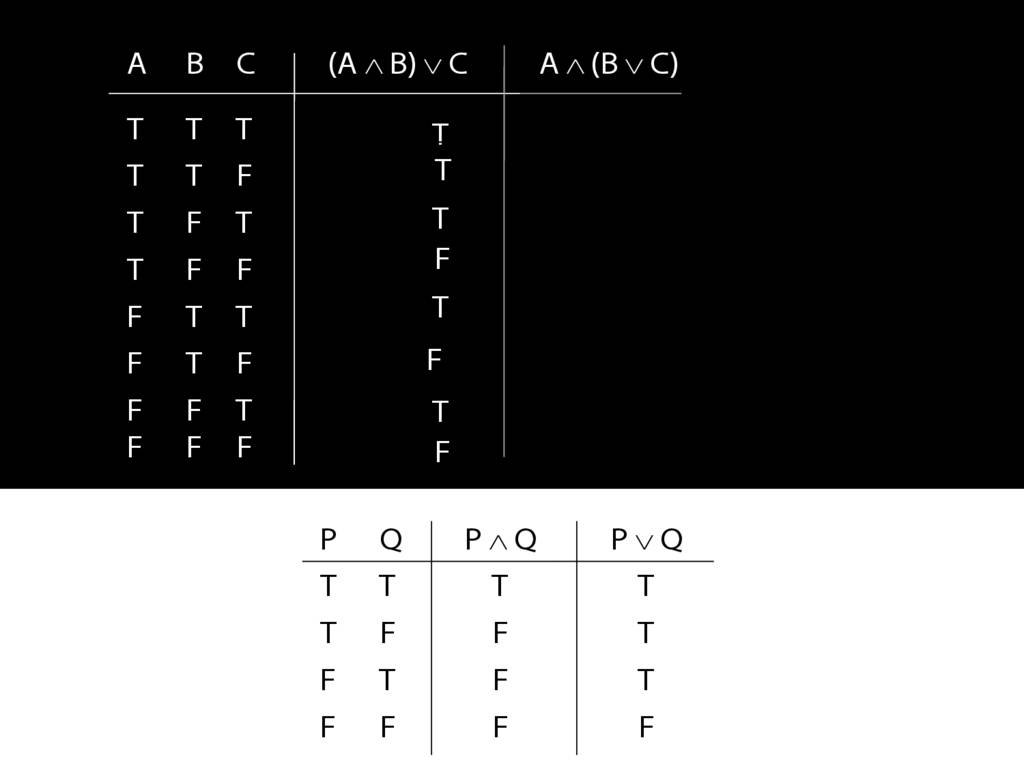
I'll give you the rest of this for free.
Now think about the other sentence.
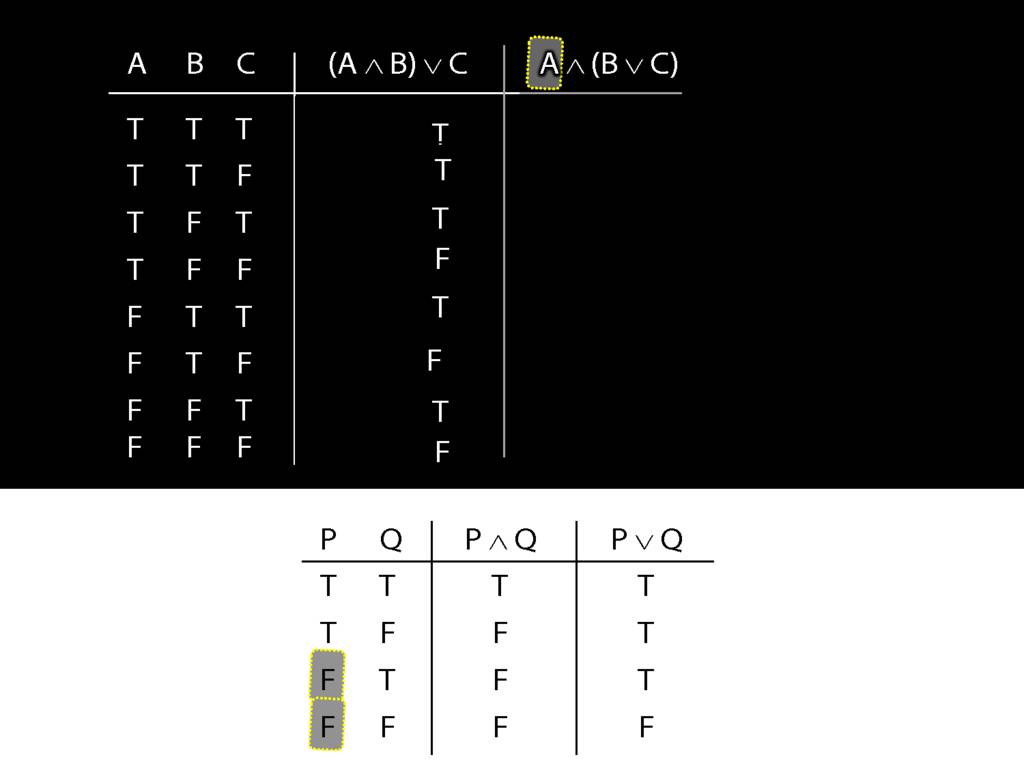
The thing on the left, the left conjunct, is the simplest part.
What happens when this is false?

Regardless of what happens on the right, when the left side of a conjunction is false, the whole thing is false.
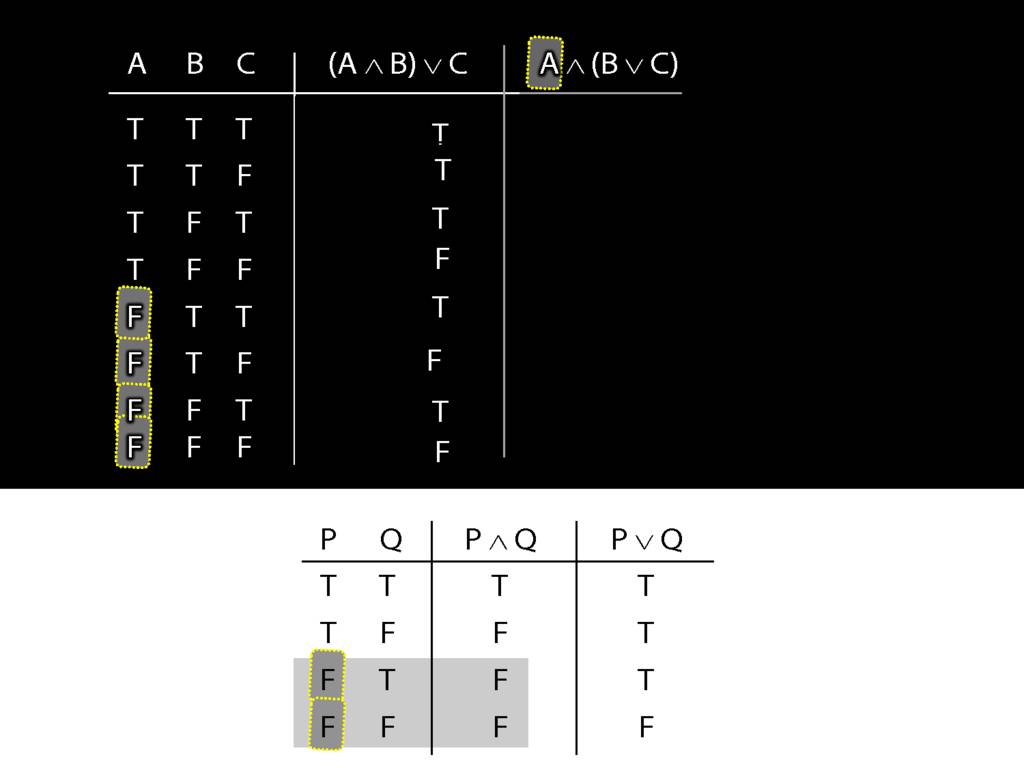
This can save us time. Where is this left side of the conjunction false?

In the bottom four rows.
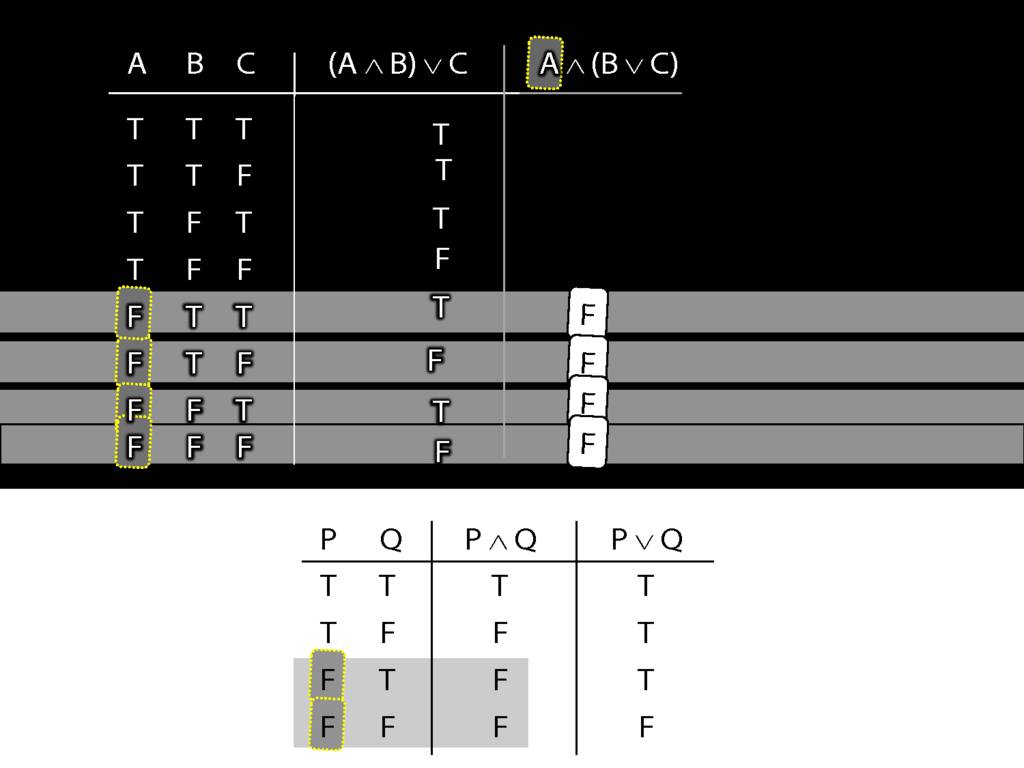
So we can be sure, even without thinking about the right side, that the whole sentence is false in these rows.

The rest of the truth table probably requires more thought ...
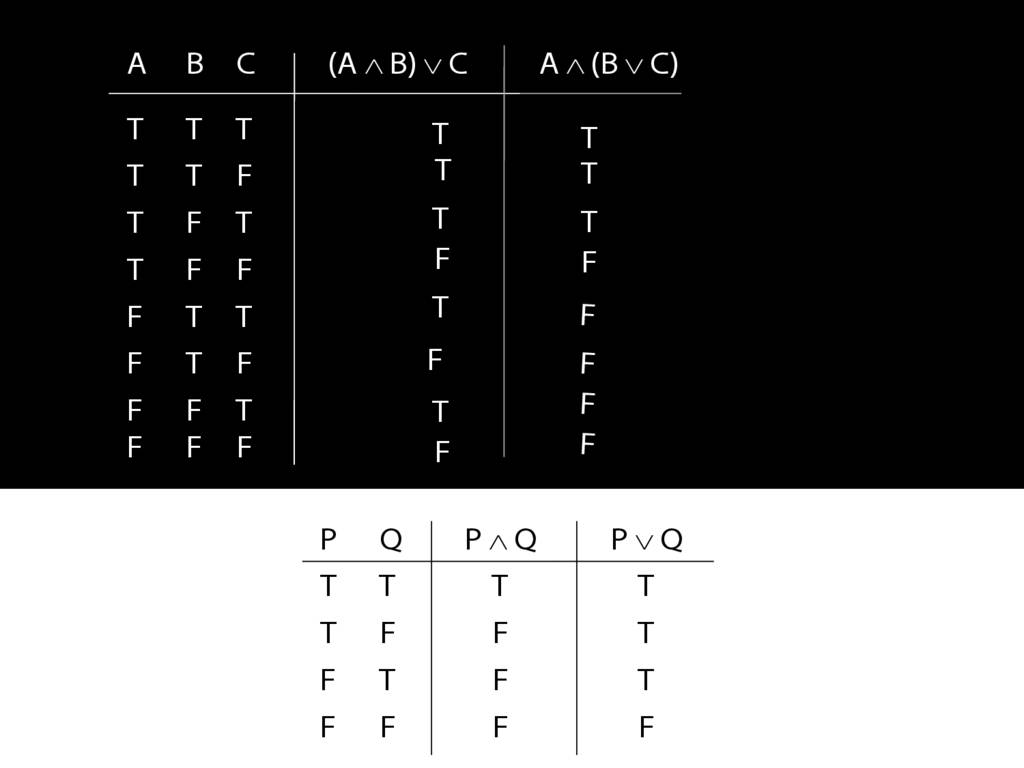
... so here's one I made earlier.
\section{A ∧ B ∨ C: They Are Different}
\section{A ∧ B ∨ C: They Are Different}
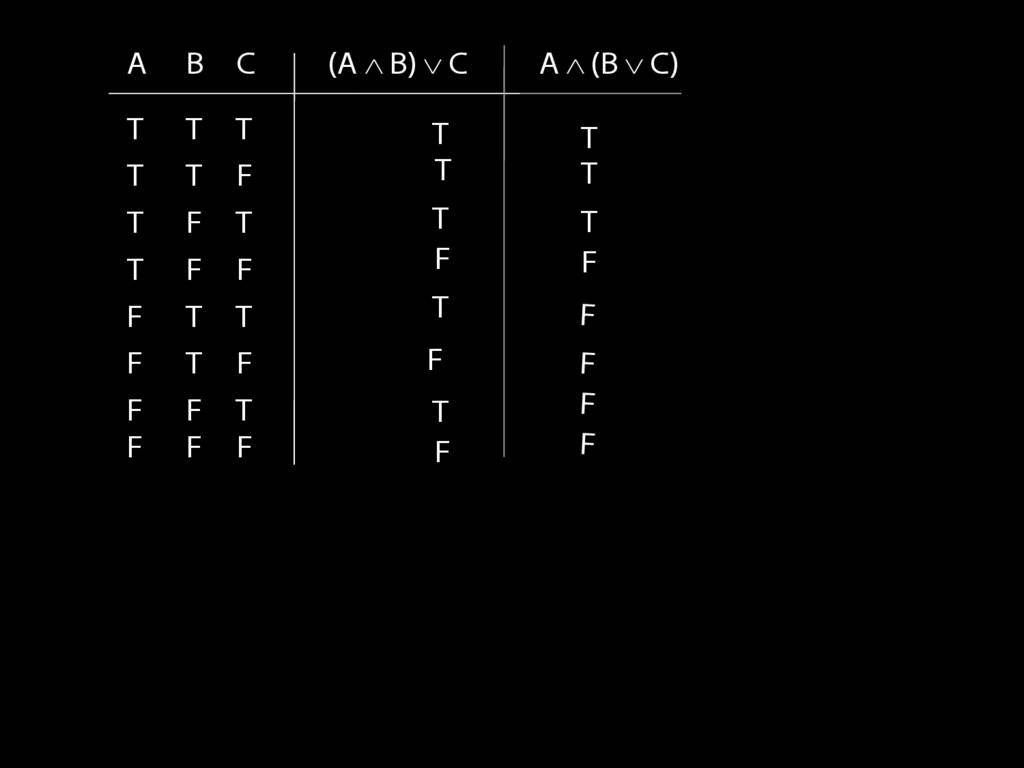
OK, so we have the truth tables. Where do they differ?

The truth-tables differ in rows five and seven only.
So the only difference between these two sentences is the brackets, but
this difference means that the two sentences differ in truth-value.
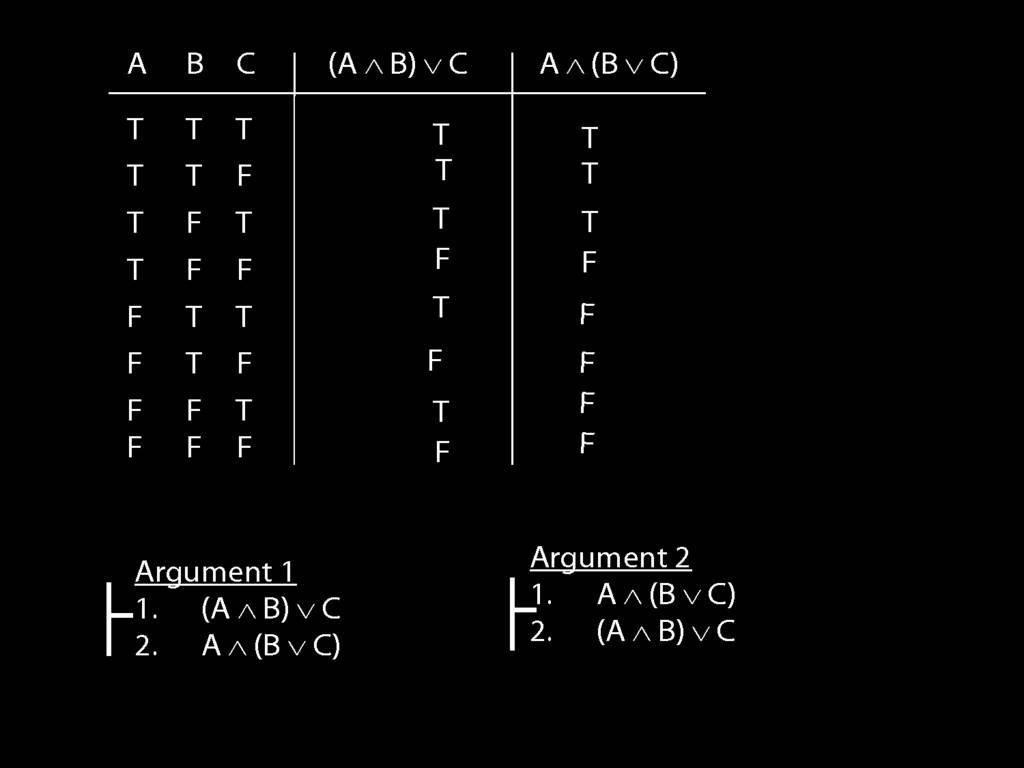
This also makes a difference to their role in arguments, of course.
Which of these arguments is logically valid?
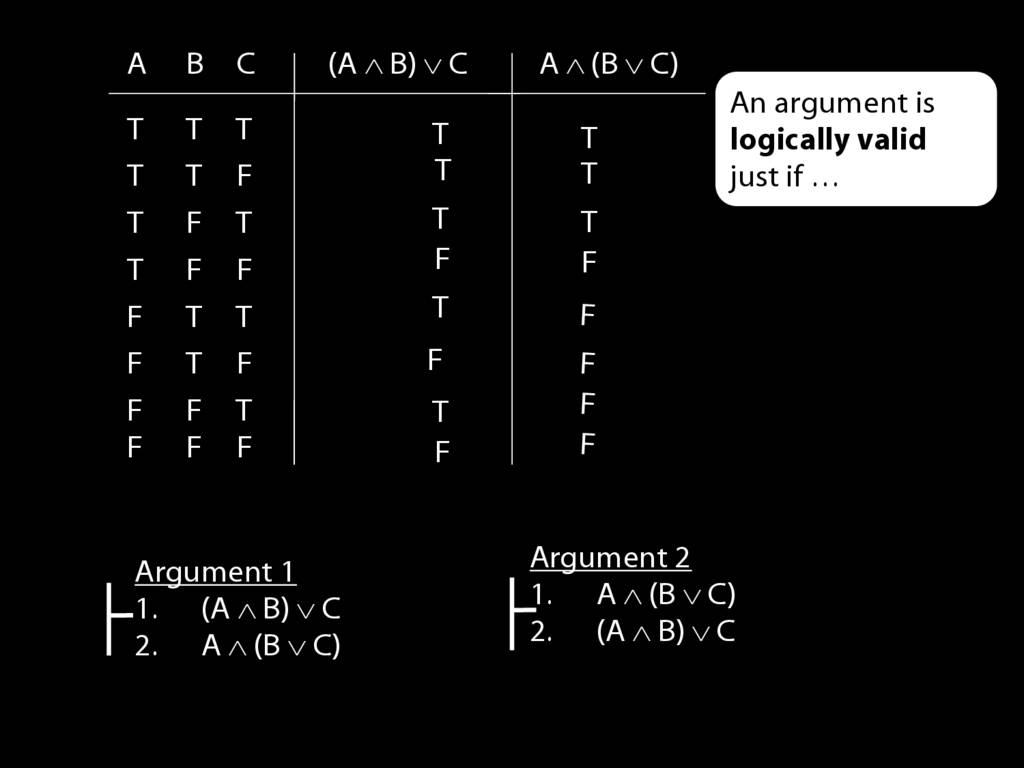
Recall that for an argument to be logically valid is for ...
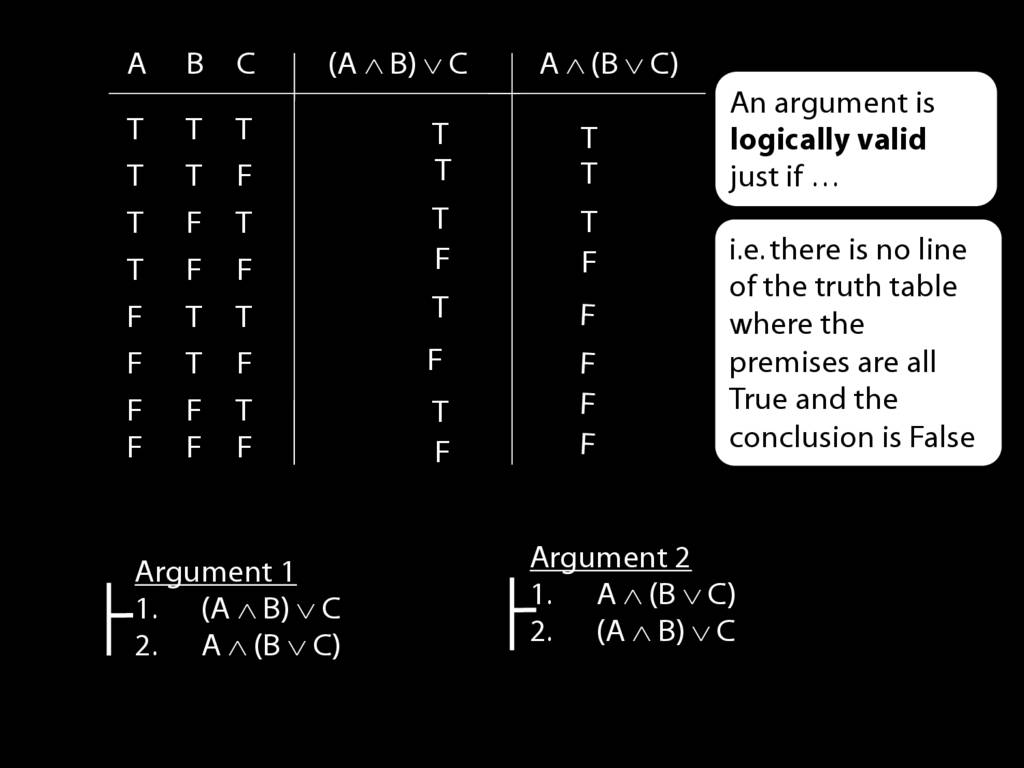
Now in the case of truth-tables, for an argument to be logically valid amounts to there being no row of the truth-table where the premise is true and the conclusion false.
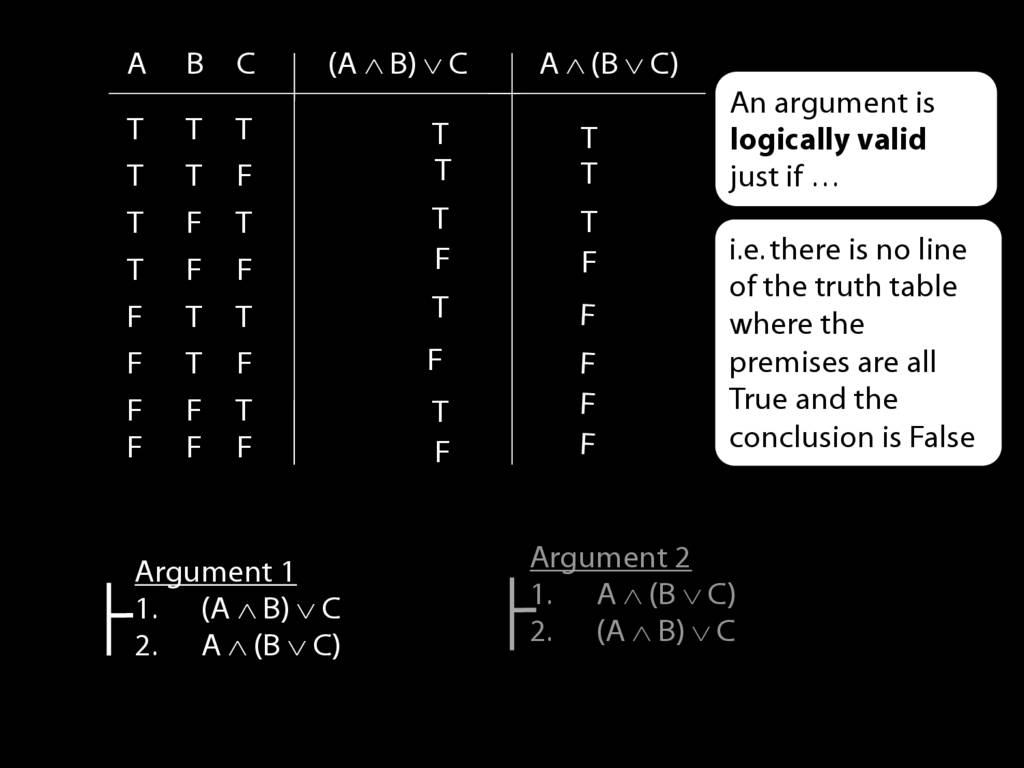
Consider the first argument. Is this valid?
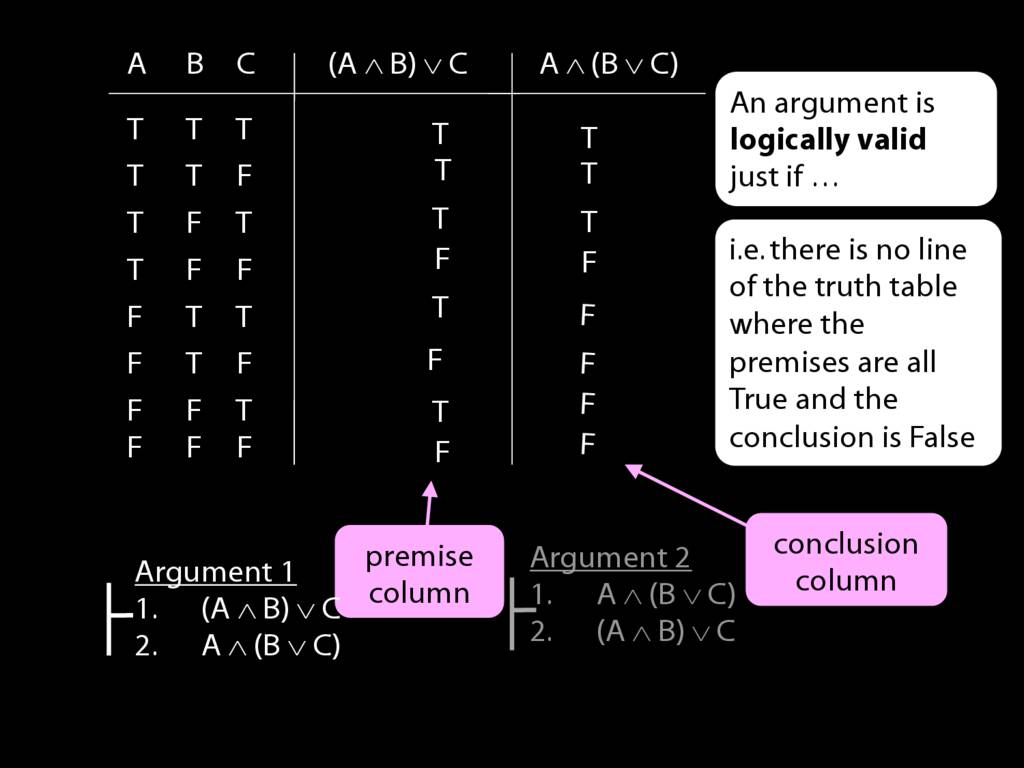
Here's the premise and here's the conclusion.
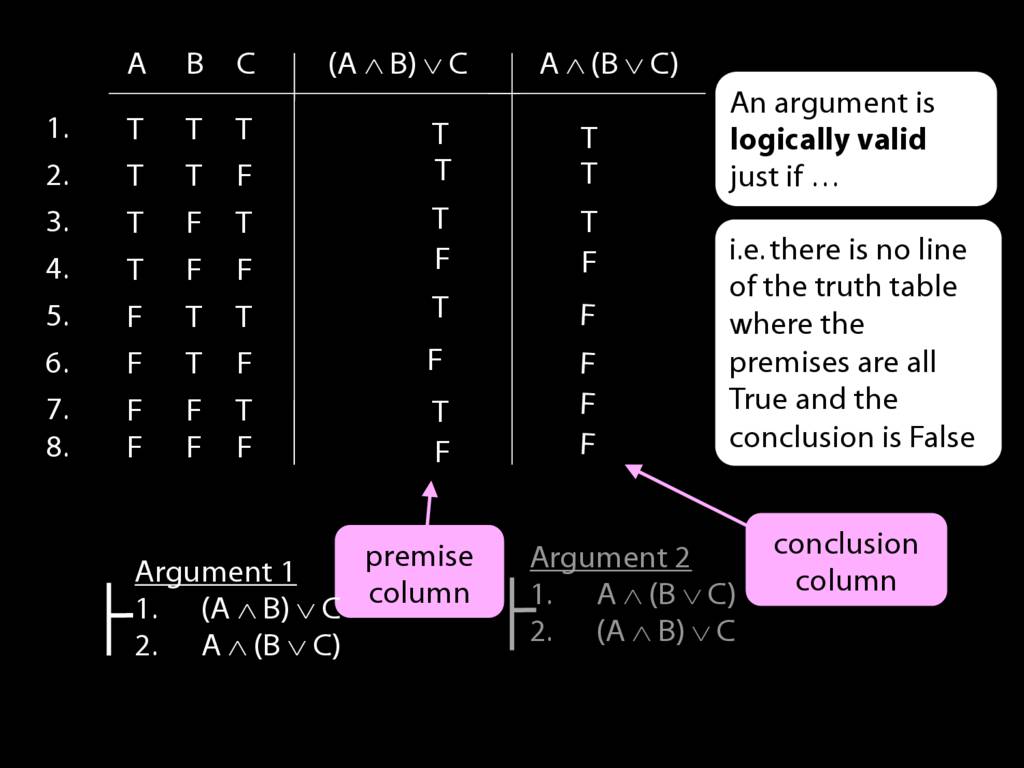
(Let's have some numbers so you can see which lines I'm talking about.)
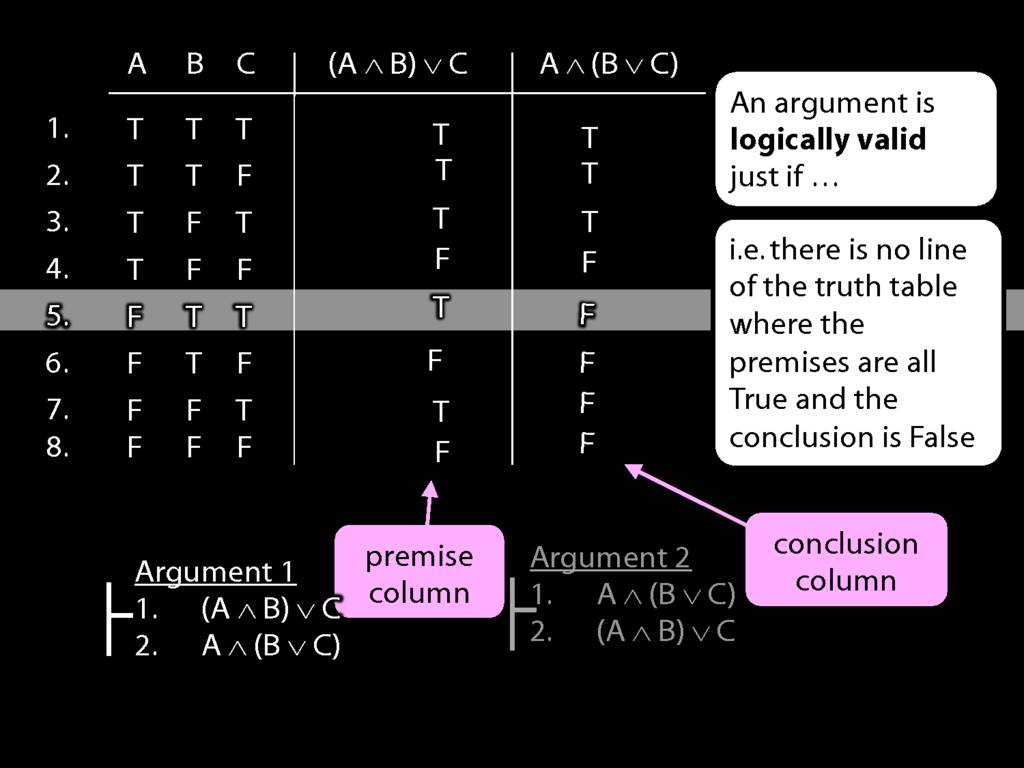
What happens in line five? Here we have true premise and false conclusion.
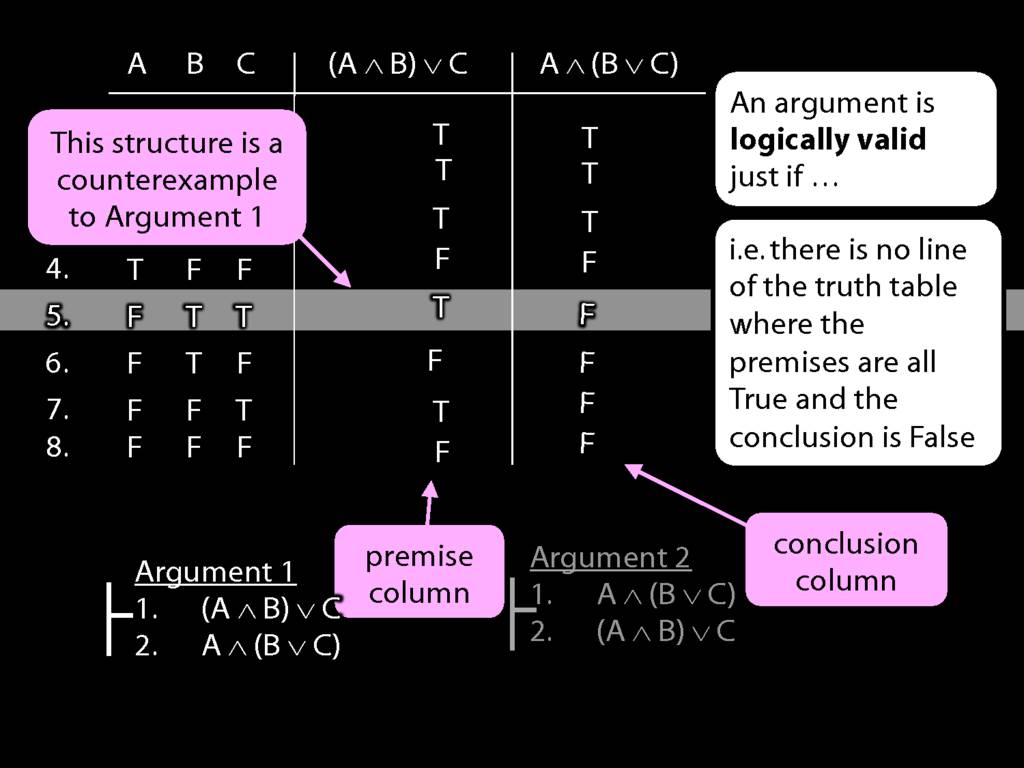
So the argument is not valid, and this row is a counterexample to the argument.
If someone asks you for a counterexample, what do you have to write?
Just this : A false, B true and C true. That's is: you've specified a possibile situation
in which the premises are true and the conclusion false, and that's what a counterexample is.
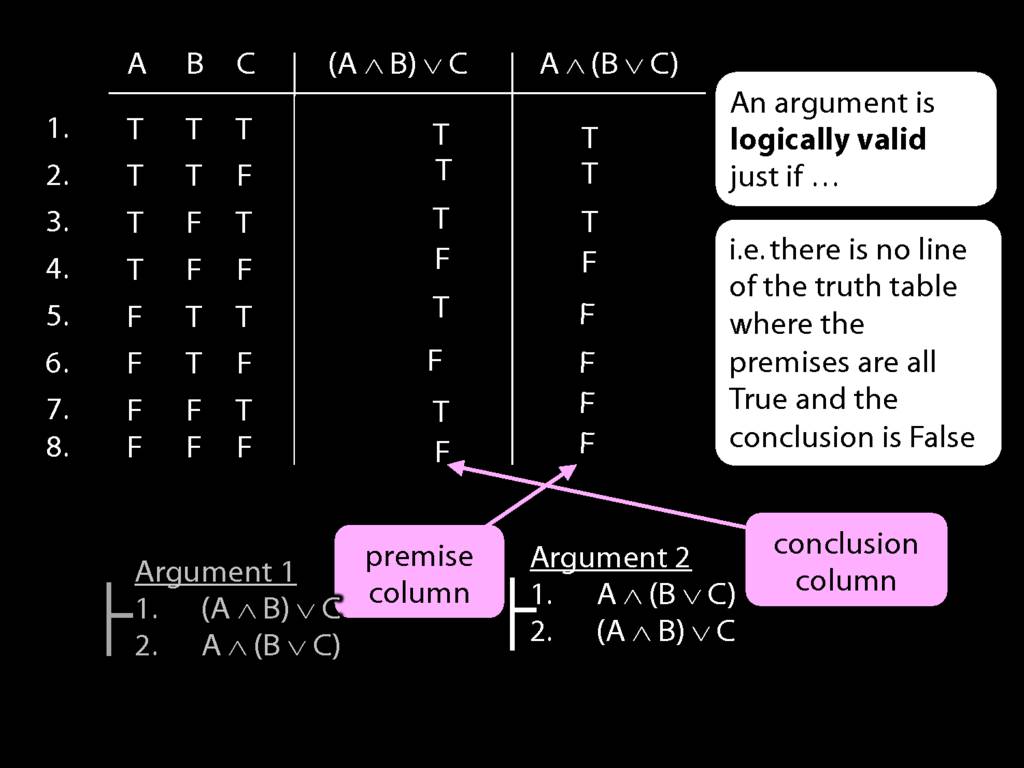
Now look at argument 2. Here the premise and conclusion columns are the other way around.
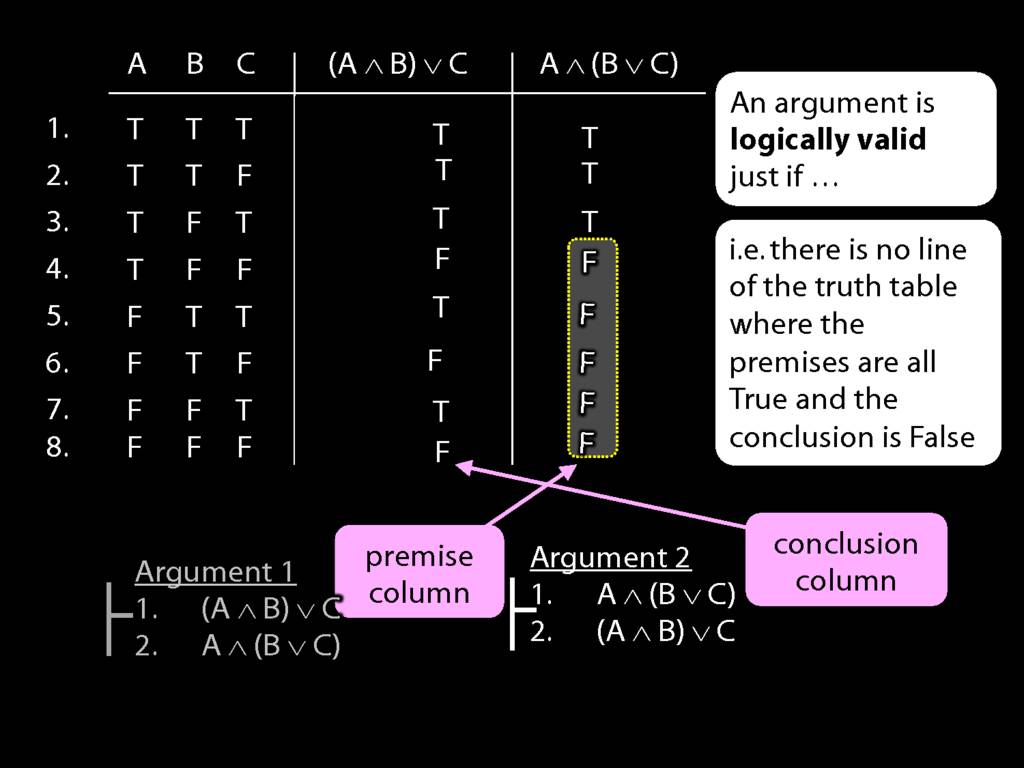
In the last five rows, the premise is false. So we can ignore these because
we won't find a true premise AND a false conclusion where the premise is false.'
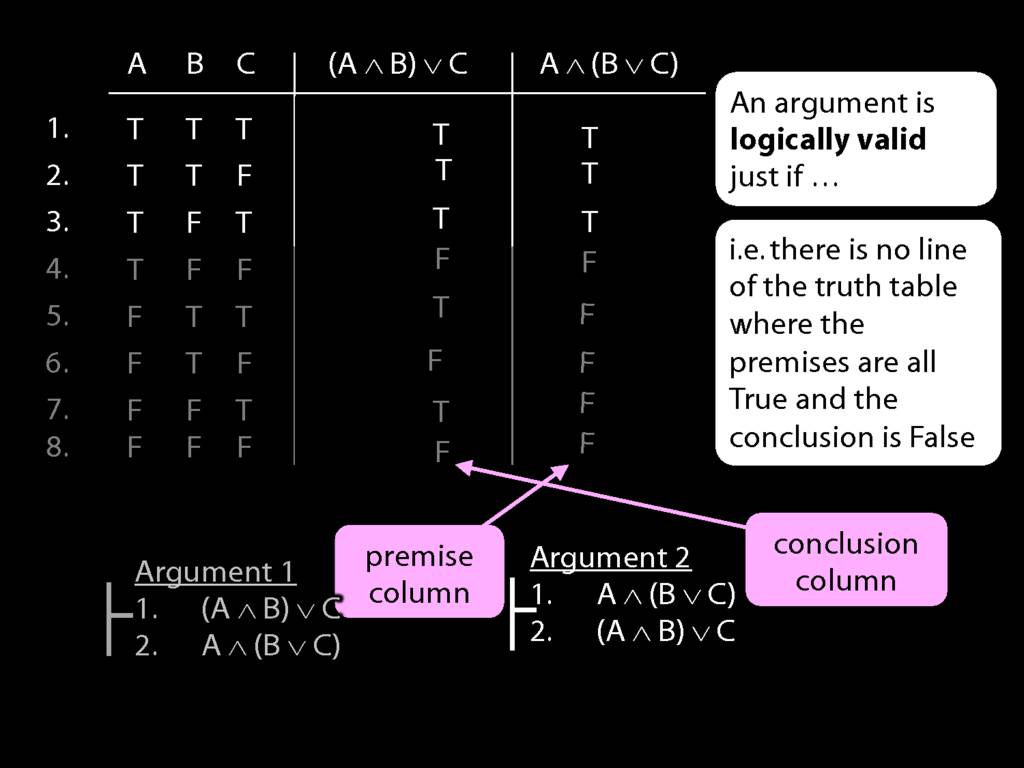
What about the top three rows?
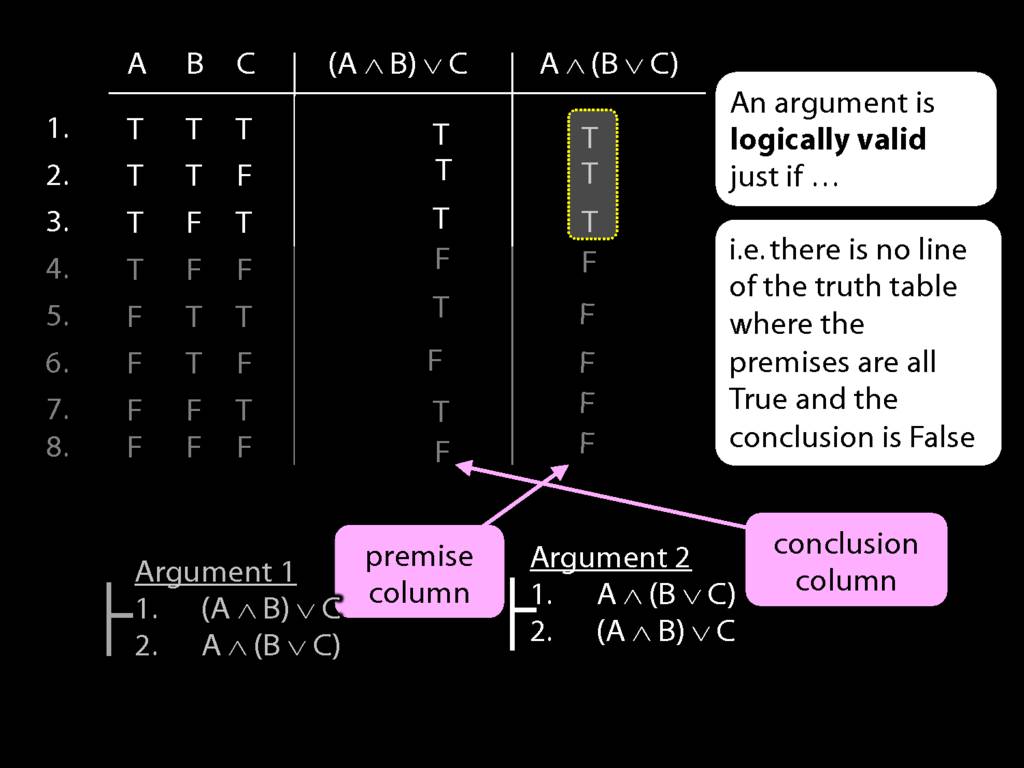
In the top three rows, the premise is true ...
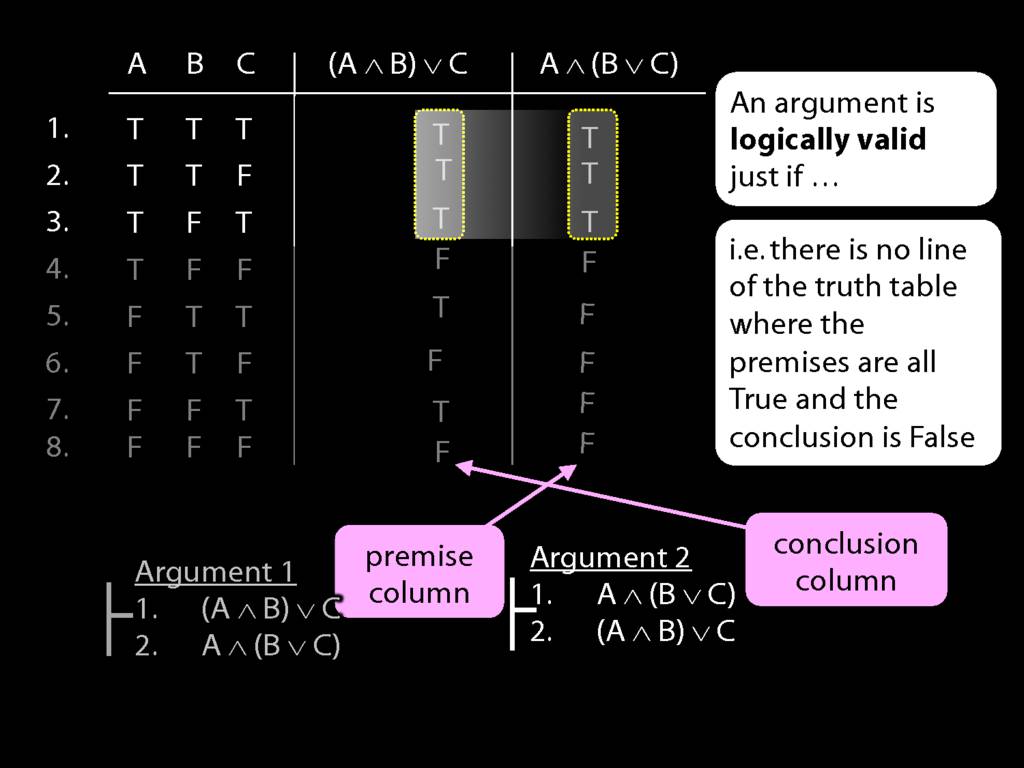
... but so is the conclusion.
So this second argument is clearly logically valid.
(A ∧ B) ∨ C
vs
A ∧ (B ∨ C)
This ends my discussion of these two sentences.
Although they differ only with respect to brackets, they have different truth-tables
and so contribute differently to the validity or not of arguments.
There's a simple message and a complex one.
The simple message is that the brackets matter.
The complex one is that we have more work to do in explaining our formal language, awFOL.
We have more work to do because we haven't yet said what the brackets mean,
although it's clear that they contribute to the meanings of sentences of awFOL.
What is the counterpart of a truth-table for brackets?
In this course we don't have time to worry about this question; we must leave the meaning
of the brackets as something that you get only implicitly.
3.14, 3.15
3.14, 3.15
7.2, 7.5, 7.6